NEC of America 58155 NEC NLite E 155 MB 5.8 GHz Digital Microwave Radio User Manual Part 5
NEC Corporation of America NEC NLite E 155 MB 5.8 GHz Digital Microwave Radio Part 5
Contents
- 1. User Manual Part 1
- 2. User Manual Part 2
- 3. User Manual Part 3
- 4. User Manual Part 4
- 5. User Manual Part 5
User Manual Part 5
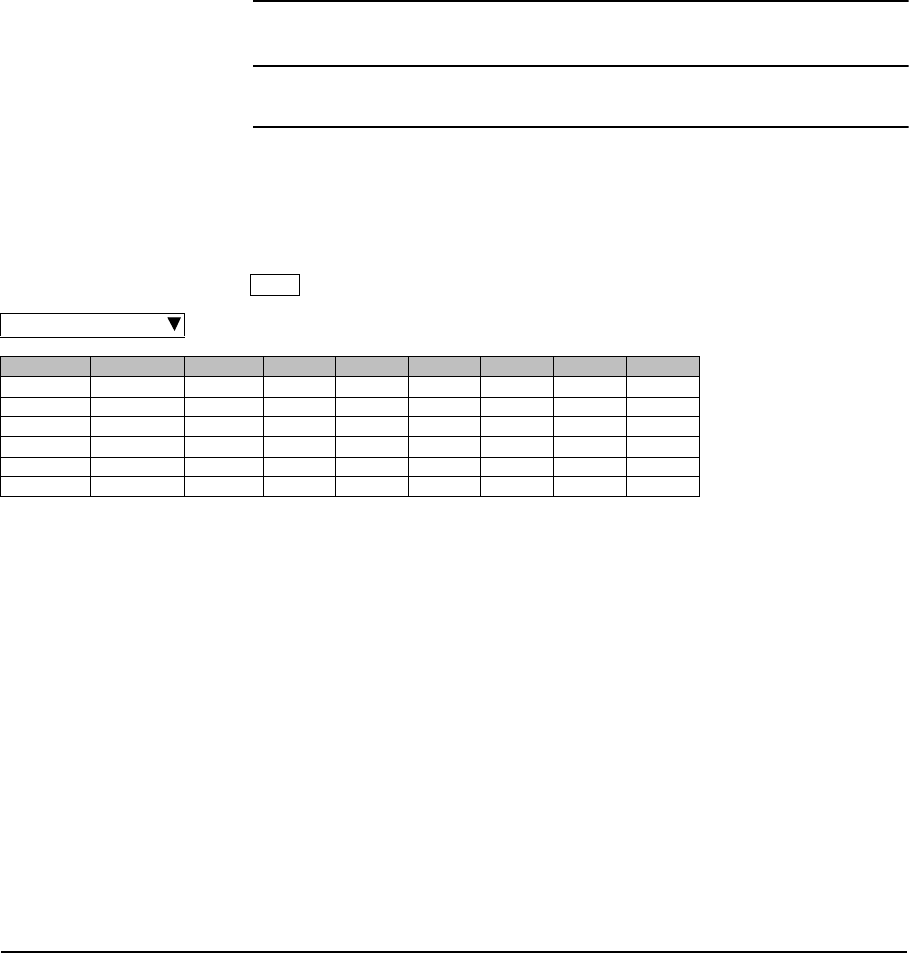
PREVENTIVE MAINTENANCE ROI-S05751
4-12
12 pages
Chart 4-2 (Cont’d)
Step Procedure
9 Click on “RMON(Line)(7days/day)” sub-menu button in
“PMON (History)”,
Detailed daily Line (LAN) RMON (Remote Network Monitoring) data are
displayed.
Note: For the GbE INTFC, there are distinctions for the
functions from the 10BASE-T/100BASE-Tx, refer to Notes
of above “RMON(Line)(24H/15min)”.
---RMON(Line)(1day)--- Maintenance Mode: on
Port1
Date Time Status 1 2 3 4 5 6 1:
2:
3:
4:
5:
6:
7:
8:
9:
10:
11:
12:
13:
14:
15:
16:
17:
18:
19:
20:
21:
22:
RX UNICAST
RX BROADCAST
RX MULTICAST
RX PAUSE
RX CEC ERR
RX ALIGNMENT ERR
RX SYMBOL ERR
RX UNDERSIZE
RX FRAGMENTS
RX 64
RX 65-127
RX 128-255
RX 256-511
RX 512-1023
RX 1024-1536
RX 1537-MAX
RX JABBERS
TX UNICAST
TX BROADCAST
TX MULTICAST
TX PAUSE
TX COLLISION

ROI-S05751 CORRECTIVE MAINTENANCE
5-1
5. CORRECTIVE MAINTENANCE
Corrective maintenance done in the field is described in this chapter.
Corrective maintenance in the field covers fault isolation, module/unit
replacement and alignment. The fault location procedures describes how
to isolate module-level/unit-level faults.
Faults can be classified into those that cause deterioration of the
transmission quality and those that interrupt the traffic due to a
malfunction of the equipment. This chapter explains the troubleshooting
procedures for equipment faults and the corresponding remedial methods.
The purpose of troubleshooting malfunctioning equipment is to restart the
service by locating the faulty part and replacing it with a spare.
The faults that cause deterioration in the transmission quality are primarily
originated by changes occurred in the state of propagation. Therefore, if a
decline in the transmission quality or similar fault takes place frequently,
the link design will have to be reviewed.
During the corrective maintenance, carefully observe the precautions
given in Chapter 2, until the alignment is completed.
5.1 Alarm/Status
When an alarm event has occurred, At first, check alarm indication on the
front of the IDU. Continuously, connect the PC to the LCT jack on the
IDU and check alarm/status indication, Meter Reading on the LCT.
(a) Check of the ALM LED Indications and LCT Indication
A faulty part can be located by checking the ALM LED indicators
and LCT Alarm indications. For the explanation of the ALM LED
indication, refer to Chapter 2 OPERATING EQUIPMENT in
Section II. Also refer to Chapter 2 Alarm/Status in this Section IV
APPENDIX LCT OPERATION.
(b) Meter Readings
Based on the meter readings during periodical inspection with
LCT described in Chapter 4, a faulty part can be located by
checking if the reading values exceed the permissible ranges.
(c) Loopback
In the case of an abnormal BER measurement result among the
meter reading items, try to distinguish the faulty part by Chart
5.1.1 Loopback.
CORRECTIVE MAINTENANCE ROI-S05751
5-2
5.1.1 Alarm and Status
The alarm and status of each module and ODU are displayed.
Each items is explained below.
ODU
TX Power: Indicates the status of the transmitter in the ODU.
When the transmission level is decreased 3 dB or
more from preset ATPC minimum level, “Alarm”
is issued.
TX Input: Indicates the status of the ODU input signal from
IDU. When the input signal from the IDU is lost,
“Alarm” is issued.
RX Level: Indicates the status of the received RF signal level
of the ODU. When the level decreased below the
RX threshold level, “Alarm” is issued.
APC: Indicates the status of the synthesizer in the ODU.
When any abnormality occurs in the synthesizer,
“Alarm” is issued.
ODU CPU/Cable Open:
Indicates the status of the CPU in the ODU or IF
cable, When any abnormality occurs the CPU
operation or IF cable is open, “Alarm” issued.
Mute Status: Indicates the control status of the ODU TX power
output. When the TX power is set to Mute, “On”
is issued.
LO REF (for XPIC in SONET):
Indicates the status of reference LO signal used for
V/H signal synchronization. When the reference
signal in the ODU is lost, “Alarm” is issued.
TX SW Status (for 1+1 configuration):
Indicates the TX SW status for the No. 1 or No. 2
CH selection.
RX SW Status (for 1+1 configuration):
Indicates the RX SW status for the No. 1 or No. 2
CH selection.
ROI-S05751 CORRECTIVE MAINTENANCE
5-3
MODEM
Unequipped:
Indicates the status of the MODEM existence.
When the MODEM is loose contact or it is not
mounted according to the “Equipment Setup”,
“Alarm” is issued.
Module:
Indicates the status of the modulator-demodulator.
When a failure occurred in the modulator-
demodulator and as a result of a LSI failure,
“Alarm” is issued.
LOF: Indicates the frame synchronization status.
When the synchronization from DMR is lost,
“Alarm” is issued,
Frame ID: Indicates the status of ID number against
MODEM of opposite station or the other channel
in Twinpath configuration. When ID number
assignment is improper, “Alarm” is issued.
High BER: Indicates the quality severe deterioration status
between radio sections. When the signal
deteriorates below the threshold preset value,
“Alarm” is issued. The settable threshold values
are: 1E-3, 1E-4 and 1E-5.
Low BER: Indicates the quality unsevere deterioration status
between radio sections. When the signal
deteriorates below the preset threshold value,
“Alarm” is issued. The settable threshold values
are: 1E-6, 1E-7, 1E-8 and 1E-9.
Early Warning:
Indicates quality deterioration status. When the
signal deteriorates below the preset threshold
level, “Alarm” is issued. (When the Early Warning
is used for protection switchover in 1+1
configuration, RX Hitless Switch is operated.) The
preset threshold level is less than 1E-9.
MOD: Indicates the operating status of the MOD. When
any failure occurs in the modulator section,
“Alarm” is issued.
DEM: Indicates the operating status of the DEM. When
any failure occurs in the demodulator section,
“Alarm” is issued.
CORRECTIVE MAINTENANCE ROI-S05751
5-4
Input Voltage:
Indicates the power supply input voltage status.
When power supply is exceeding the limited,
“Alarm” is issued.
Power Supply:
Indicates the operating status of the power supply.
When power supply is abnormal, “Alarm” is
issued.
IF Cable Short:
Indicates the status of IF cable between IDU and
ODU. When a short circuit is caused between
ODU and the IDU, “Alarm” is issued.
Cable EQL: Indicates the status of IF cable equalizer. When
equalizer characteristics control is lost, “Alarm” is
issued.
XIF (for XPIC in SONET):
Indicates the status of XIF input signal of the Main
Master IDU and Sub Master IDU. When the XIF
input signal is lost, “Alarm” is issued and XPIC
function is reset.
XPIC Status (for XPIC in SONET):
Indicates the status of XPIC operation. When the
XPIC function is reset, “Reset” is indicated and
the “Reset” LED on the front panel is lit.
XREF (for XPIC in SONET):
Indicates the status of reference CLK signal used
for V/H signal synchronization. When the
reference OSC in the MODEM failure occurs,
“Alarm” is issued.
Linearizer Function:
Indicates the status of linearizer function.
OPR: When the linearizer function is used.
NO OPR:When the linearizer function is not used.
In this case, TX output power decreases
approx. 4 dBm from a standard value.
N/A: When the ODU is used without
linearizer function.
Linearizer: Indicates the linearizer operating status. When
linlearizer operation is improper in OPR condition,
“Alarm” is issued.
ROI-S05751 CORRECTIVE MAINTENANCE
5-5
ATPC Power Mode:
Indicates the status of ATPC operation mode.
When the ATPC function is improper, stop the
control and maintain the TX output level at
HOLD/MAX/MIN selectable.
INTFC (Main/Sub)
INTFC(1/2) Module:
Indicates the operating status of the ( ) INTFC.
When any failure occurs in the INTFC(1/2)
Module, “Alarm” is issued.
INTFC(1) Unequipped:
Indicates the existence status of the ( ) INTFC.
When the ( ) INTFC(1) is not equipped, “Alarm”
is issued.
INTFC(2) Unequipped (for SONET):
Indicates the existence status of the ( ) INTFC.
When the ( ) INTFC(2) is not equipped, “Alarm”
is issued.
INTFC(1/2) Type Mismatch:
Indicates the mounted status of the ( ) INTFC.
When the INTFC(1/2) type is not coincided with
the inventory list, “Alarm” is issued.
INTFC(1) In-Phase:
Indicates the received signal DADE status
between No. 1 and No. 2 at STM/( )E1 INTFC.
When the received signal delay time is out of
permissible range, Outphase alarm is issued.
OC-3(1) LOS (MUX) (for SONET):
Indicates the input signal status of the OC-3 from
MUX. When the input is disconnected, “Alarm” is
issued.
OC-3(1) LOF (MUX) (for SONET):
Indicates the input signal status of the OC-3 from
MUX. When the input signal is out of frame
synchronization, “Alarm” is issued.
E-BER(1) (MUX) (for SONET):
Indicates Excessive-BER of the input OC-3 signal
from MUX. When the signal deteriorates below
the preset threshold level, “Alarm” is issued. The
settable threshold values are 1E-3, 1E-4 and 1E-5.
OC-3(1) SD (MUX) (for SONET):
CORRECTIVE MAINTENANCE ROI-S05751
5-6
Indicates the input signal status of the OC-3 from
MUX. When the signal deteriorates below the
preset threshold level, “Alarm” is issued. The
settable threshold values are 1E-6, 1E-7, 1E-8 and
1E-9.
OC-3(1) LOS (DMR) (for SONET):
Indicates the signal status of the OC-3 from DMR.
When the input is disconnected, “Alarm” is issued.
ROI-S05751 CORRECTIVE MAINTENANCE
5-7
OC-3(1) LOF (DMR) (for SONET):
Indicates the status of the input OC-3 signal from
DMR. When the input signal is out of
synchronization, “Alarm” is issued.
OC-3(1) E-BER (DMR) (for SONET):
Indicates Excessive-BER of the input OC-3 signal
at the Radio side. When the signal deteriorates
below the preset threshold level, “Alarm” is
issued. The setable threshold values are 1E-3, 1E-
4 and 1E-5.
OC-3(1) SD (DMR) (for SONET):
Indicates the input signal status of the OC-3 from
DMR. When the signal deteriorates below the
preset threshold level, “Alarm” is issued. The
setable threshold values are 1E-6, 1E-7, 1E-8 and
1E-9.
OC-3(1) TF (for SONET):
Indicates the signal interruption status. Indicates
when MS-AIS Generation is set to “Disable”.
When OC-3 output signal of OC-3 INTFC is
stopped, “Under Execution” is indicated.
LAN Link (Port ( )) (LAN INTFC for SONET):
Indicates the status of Link between related
equipment and Port ( ). Indicates “Link” when the
Port is linked with related equipment and indicates
“Alarm” in other case.
LAN Collision (Port ( )) (LAN INTFC for SONET):
Indicates the status of Collision in Half Duplex
mode. In Full Duplex mode, “Normal” is always
displayed. Indicates status when Port ( ) is in
collision condition.
Link Loss Forwarding (LLF) (Port ( )) (LAN INTFC for
SONET):
Indicates the operating status during the fault in
opposite station or when the link of local Port ( )
LAN is disconnected by the fault of radio section.
When any failure occurs in the MAIN INTFC,
“Alarm” is also issued.
Speed & Duplex: (Port ( )) (LAN INTFC for SONET):
Indicates the operating mode of Port ( ).
CTRL
CTRL Module:
Indicates the operating status of the CTRL. When
any failure occurs in the CTRL Module, “Alarm”
CORRECTIVE MAINTENANCE ROI-S05751
5-8
is issued.
MMC:
Indicates the MMC status. When the mounted
MMC is detected, “On” is displayed.
APS SW Fail (for APS in SONET):
Indicates the APS status of the APS system. When
the APS switchover failure occurs, “Alarm” is
issued.
APS Online Status (for APS in SONET):
Indicates online channel on the APS system.
XCTRL (for XPIC in SONET):
Indicates the status of control signal between Main
Master IDU and Sub Master IDU. When the out of
control condition occurs, “Alarm” is issued.
XPIC Mode Mismatch (for XPIC in SONET):
Indicates the status of the Main Master IDU and
Sub Master IDU definition. When the Main
Master IDU and Sub Master IDU is not defined
properly as like as Main Master-Main Master or
Sub Master-Sub Master, “Alarm” is issued.
ROI-S05751 CORRECTIVE MAINTENANCE
5-9
5.1.2 Control Item
Control items can be selected only under maintenance mode. As this
“Control” is likely to cause disconnection of signal, take care during
operation.
Details of “Control” item is described as follows:
TXSW manual control:
Controls manual switchover of the TX SW at the
transmitting side in the Hot standby (HS)
configuration.
RXSW manual control:
Controls manual switchover of the RX SW in the
1+1 configuration. The switchover is carried out
without traffic interruption when the DADE is In-
phase. Adjustment of the delay time of No.1 and
No.2 is automatically set.
Caution: When the RX SW mode is set to “Forced” in
provisioning, RX SW manual control can select
either No. 1 or No. 2 RX route though one is
alarmed. Then, take care switching to avoid traffic
interruption.
ATPC manual control:
Used when it is required ATPC operation ON/OFF
or the change of the transmitting power range in
ATPC operation.
TX mute: Turns off the transmitter output.
CW CONTROL (No.1/2):
Used for transmitting a unmodulated carrier wave
(CW). Used to confirm the TX frequency stability.
APS Manual Control (for APS in SONET):
Controls manual switchover (Auto/Working/
Protection) of the Optical Line in the APS system.
Caution: When the APS Maintenance mode is set to “Forced”
in provisioning, APS Manual Control can select
either Working or Protection line though one is
alarmed. Then, take care switching to avoid traffic
interruption.
IF loopback: Used for distinguish equipment failure to ODU or
IDU. The input traffic signal from MUX is looped
back at IF stage. When no abnormality is found in
the signal after IF loopback, it is assumed that the
ODU has a problem.
CORRECTIVE MAINTENANCE ROI-S05751
5-10
Since the control is not interlocked with the RX
SW, the RX SW control is needed to select CH
which it is IF looped back in 1+1 configuration.
Main Loopback (NEAR END) (for SONET)/
Main Loopback (NEAR END) INTFC (1) or (2) (for SONET
APS)/:
Used for distinguish equipment failure to MUX
equipment or radio equipment. The input signal
from MUX is looped back to the MUX. When no
abnormality is found in the signal with NEAR
END loopback, it is assumed that the radio
equipment (IDU or ODU) has a problem.
Main Loopback (FAR END) (for SONET):
Used for distinguish equipment failure to MUX
equipment or radio equipment. Signal is looped
back at the IDU of the opposite station. When no
abnormality is found in the signal through FAR
END loopback, it is assumed that the local radio
equipment (IDU or ODU) has no problem.
Note: This function is unavailable when 2-WAY/XC is
enabled.
DADE Adjust:
Sets the DADE for Hot Standby SD/Twinpath
configuration. Selects to make INTFC status In-
phase.
Notes: 1. The DADE control applies in 1+1 configuration to
adjust delay time for RX hitless switching when the
INTFC status is indicated Outphase.
ROI-S05751 CORRECTIVE MAINTENANCE
5-11
2. The DADE adjustment is needed in initial lineup or
when the IF CABLE is replaced. It is not needed
readjustment when the INTFC status is indicated In-
phase.
LAN Device Reset (for LAN transmission only):
Used for reset control to LAN interface Port 1 or
Port 2.
Linearizer Control:
Sets Auto/Forced Reset of linearizer function.
Forced Reset: When the linearizer function is not used.
Auto: When the linearizer function is used.
RF SUB Band select:
Used for changing the ODU sub band for radio
link depending on the RF frequency assignment.
Antenna Alignment Mode:
The Antenna Alignment Mode is used for
extending the dynamic range of the NLITE E
Monitor unit. In order to measure in high range of
AGC V, it is mandatory required to set Antenna
Alignment Mode to ON. If not it set to ON, the
indicated AGC voltage is not guaranteed value.
For the antenna orientation, set the TX power to
the required level by MTPC mode at the opposite
site.
Note: It is necessary to set to Antenna Alignment Mode when
monitor the RX level with the NLITE E Monitor unit.
ALS Restart (for SONET optical interface):
Sets the duration that the laser is emitted when
ALS manual restart for test is performed.
XPIC Control Local (for XPIC in SONET):
Resets the XPIC function for Local IDU when
propagation is deteriorated, either MODEM or
ODU of Main Master or Sub Master is a failure or
perform the link test.
XPIC Control Remote (for XPIC in SONET):
Resets the XPIC function for the IDU in the
opposite station when either MODEM or ODU of
Main Master or Sub Master in the local station is a
failure or perform the link test.
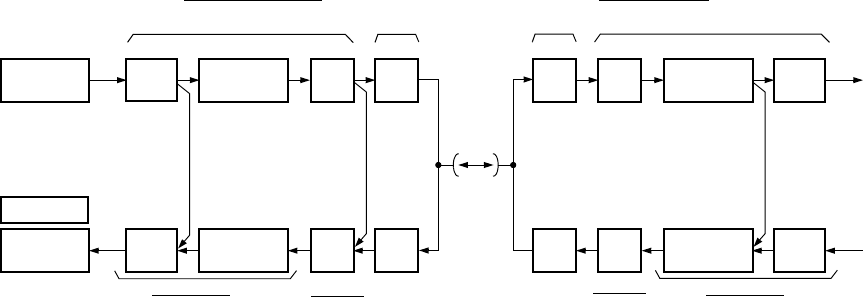
CORRECTIVE MAINTENANCE ROI-S05751
5-12
5.1.3 Loopback
When loopback condition is necessary, set the system to loopback
condition. (see Chart 5-1)
When there is an interruption of signals, use the STM/SONET/PDH
analyzers and isolate the faulty section by checking the traffic signal by
loopback. Setup the test equipment according to the following diagrams
for PDH or SONET configuration.
N/C
(E/O)
CONV
DEMRX
C/N
(O/E)
CONV
MODTX
IDUODU
RECEIVING END
TX
RX
MOD
DEM
RST
STM/SONET
ANALYZER
STM/SONET
ANALYZER
ODUIDU
TRANSMITTING END
MODEM OC-3 INTFC
MODEM
RST
RST
RST
C/N
(O/E)
CONV
N/C
(E/O)
CONV
OC-3 INTFC
(Near End Loopback) (IF Loopback) (Far End Loopback)
PC
Fig. 5-1 Loopback Diagram for Fault Isolation for SONET
Note: The IF LOOPBACK and the RX SW is not operated interlock. In
1+1 configuration, The RX SW switching is needed to select the
same CH that is testing in IF LOOPBACK.
When the RX SW manual control is disable, set it to Forced mode
in Provisioning.

ROI-S05751 CORRECTIVE MAINTENANCE
5-13
Chart 5-1 Loopback Control
Step Procedure
For the LCT operation, refer to Chapter 6 of LCT Operation in
Appendix of this Section IV.
This chart contains:
A. Preparation
B. IF Loopback Control
C. Main Loopback (Near End) Control (SONET)
D. Main Loopback (Far End) Control (SONET)
If loopback operation is performed, timing loop may occur (timing loop is
described in ITU-T Recommendation G.781).
Step Procedure
Caution: The Loopback control affects the radio link connection.
1. Loopback control operation is not performed at the
same time, or perform the Loopback reset control
and perform either Loopback mode.
• IF Loopback
• Near End Loopback
• Far End Loopback
2. Loopback operation is not performed with an
opposite station simultaneously.
3. Far End Loopback control will be canceled when
radio link failure occurs under the control has been
executed.
A. PREPARATION
1 Set up the BER measurement, (refer to Fig. 5-3)
2 Connect the LCT port and the USB port with a USB cable, (see
Fig. 2-2 in Chart 2-2)
3 Login LCT with User name “Admin” and Admin password,
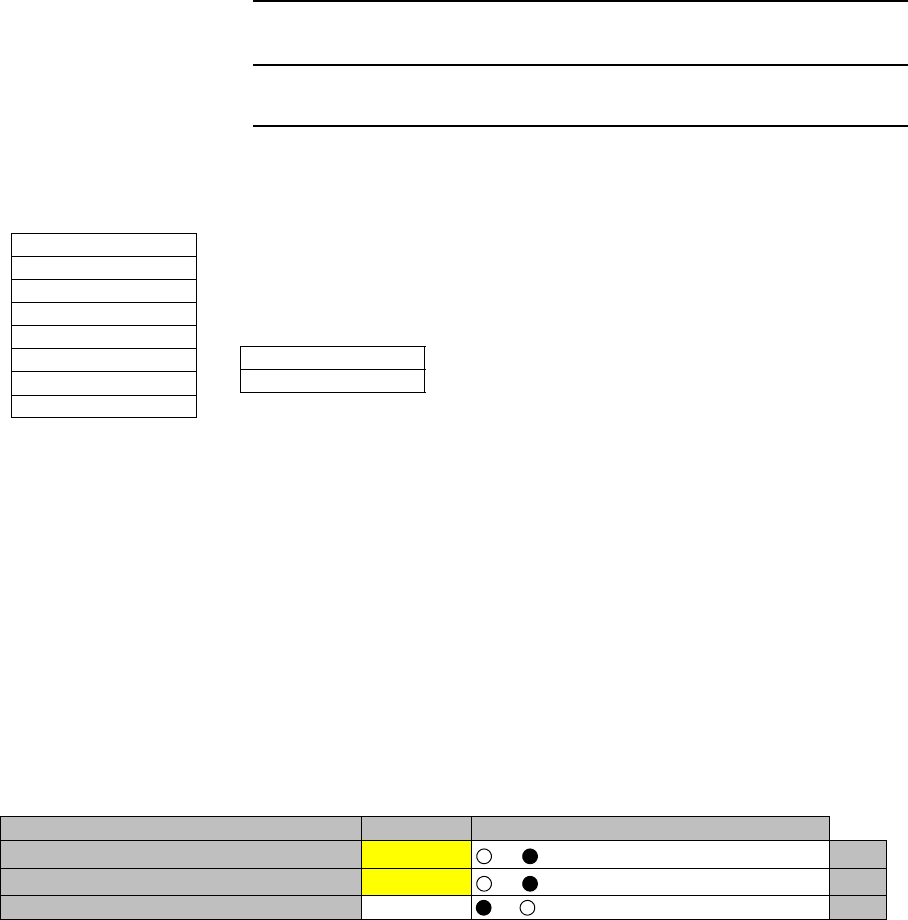
CORRECTIVE MAINTENANCE ROI-S05751
5-14
Chart 5-1 (Cont’d)
Step Procedure
4 Click on the “Maintenance” button in “LCT MENU”,
LCT MENU
Alarm/Status
Equipment Setup
Inventory
AUX I/O
Maintenance
Provisioning
Metering
PMON(History)
Maintenance1
Maintenance2
5 Click on the “Maintenance1” menu,
6 Click on the control button “On” and click “Set” button, to set to
Maintenance On mode,
7 For 1+1 configuration, switchover the TX SW and RX SW for
the channel is to be set loopback, (Refer to Chart 2.3 Manual
Switchover Operation)
8 Click on the “IF Loopback ( )” button in “Maintenance1” menu
and click on the setting button “On”,
Note: The control affects Radio link connection.
Note:The control applies to IF loopback in local MODEM.
9 Click on the “Set” button,
10 Click on the Alarm/Status on LCT MENU to check the status,
11 Refer to Fig. 5-7 to 5-9 Troubleshooting Flowchart to diagnose
the problem,
12 Click on the setting button “Off” of the IF Loopback ( ) and
click on the “Set” button,
---Maintenance1---
Item Value Setting
Maintenance On Off On Set
IF Loopback (No.1) On Off On Set
IF Loopback (No.2) Off Off On Set
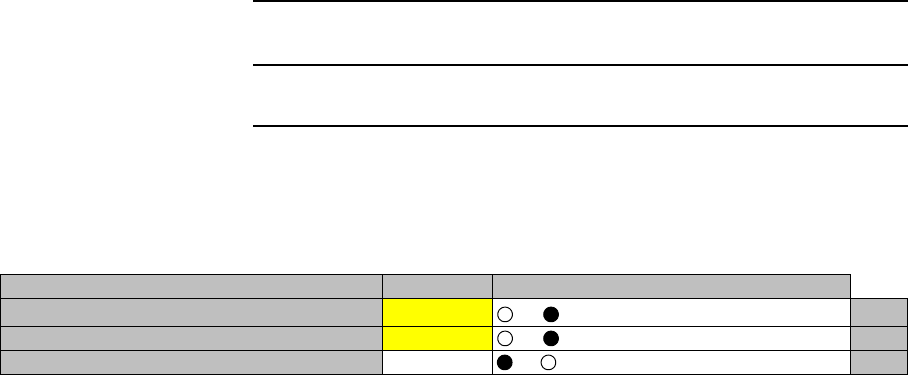
ROI-S05751 CORRECTIVE MAINTENANCE
5-15
Chart 5-1 (Cont’d)
Step Procedure
For OC-3 (E)
13 Click on the setting button “On” and click on the “Set” button,
---Maintenance1---
Item Value Setting
Maintenance On Off On Set
Main Loopback (Near End) On Off On Set
Main Loopback (Far End) Off Off On Set
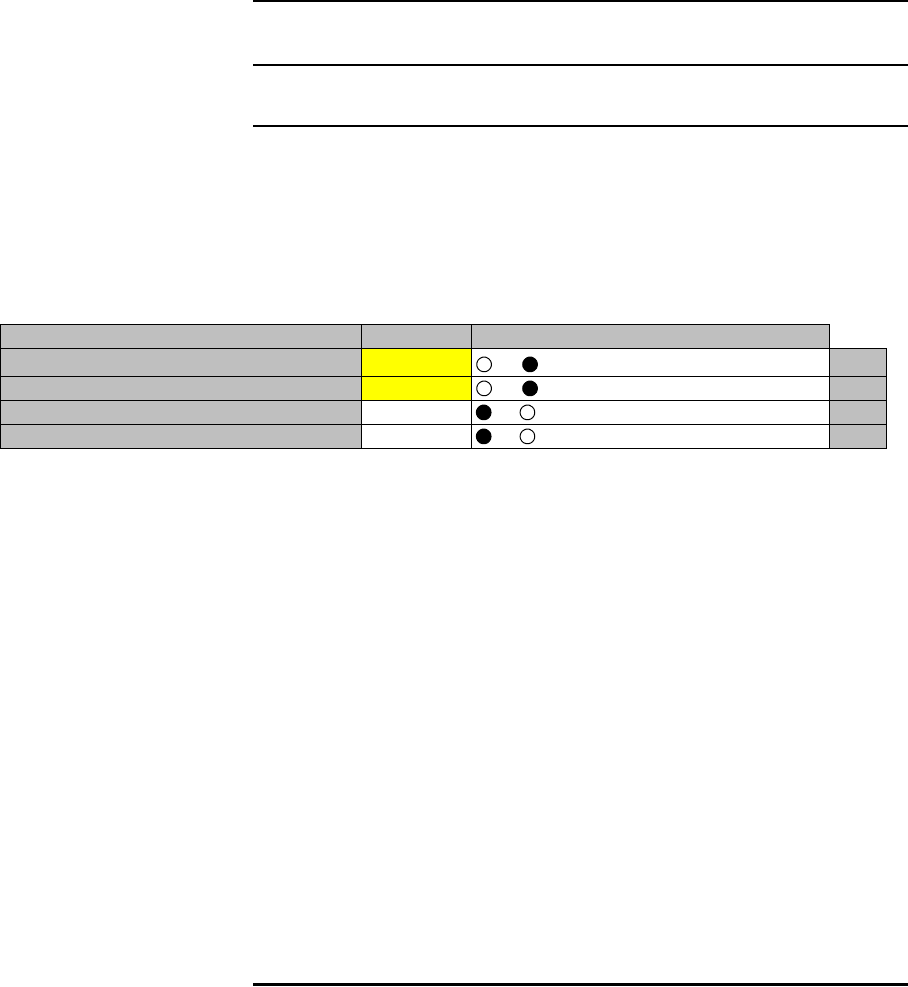
CORRECTIVE MAINTENANCE ROI-S05751
5-16
Chart 5-1 (Cont’d)
Step Procedure
For OC-3 (O) (APS)
14 Click on the “Main Loopback (Near End)” button in
“Maintenance1” menu, click on the setting button “INTFC ( )” and
click on the “Set” button,
15 Click on the Alarm/Status on LCT MENU to check the status,
16 Refer to Fig. 5-7 to 5-9 Troubleshooting Flowchart to diagnose
the problem,
17 Click on the setting button “Off” of the Main Loopback (Near
End) and click on the “Set” button,
18 Click on the setting button of Main Loopback (Far End) in
“Maintenance 1” menu and click on the “Set” button,
19 Click on the Alarm/Status on LCT MENU to check the status,
20 Refer to Fig. 5-7 to 5-9 Troubleshooting Flowchart to diagnose
the problem,
21 Click on the setting button “Off” of the Main Loopback (Far
End),
22 Reset control for TX RX SW to “Off”,
23 Reset Maintenance mode to “Off”.
---Maintenance1---
Item Value Setting
Maintenance On Off On Set
Main Loopback (Near End) INTFC (1) On Off On Set
Main Loopback (Near End) INTFC (2) Off Off On Set
Main Loopback (Far End) Off Off On Set

ROI-S05751 CORRECTIVE MAINTENANCE
5-17
5.1.4 BER Measurement
Chart 5-2 BER Measurement
Apparatus:
Digital Multimeter with test leads
Screwdriver
SONET/SONET Analyzer (for SONET)
Optical Variable Attenuator (for OC-3 Optical Interface only)
Headset
Step Procedure
A. 4P LAN INTERFACE
Note: The BER measurement can not be performed for the channel
which is set to Not Used or the channels shared with LAN.
TRANSMITTING END
SELV
!
AUX/ALM
NMS NE SC IN/OUT EOW
PROTECT
CALL MMC
MAINT
MEMORY
IDU
XIF IN XIF OUT
IF IN/OUT
TX
RX
RESET
XPIC CTRL
XPIC
PWR
ODU
MD/
CBL PWR
PASOLINK NEO
ALM
LCT
PULL
SELV
!
XIF IN XIF OUT
IF IN/OUT
TX
RX
RESET
XPIC CTRL
XPIC
PWR
ODU
MD/
CBL PWR
PULL
G
G
G
G
100M PORT 3 PORT4 100M
ALM
100M PORT 1 PORT 2 100M
4P LAN INTFC

CORRECTIVE MAINTENANCE ROI-S05751
5-18
Chart 5-2 (Cont’d)
Step Procedure
1 At both transmitting and receiving ends, set the BER test set as
follows:
Note: Operation of the TX SW and RX SW are not required in
1+0 system for the following.
2 In HS system, set the TX SW to No.1 or No.2 to “On” condition
at transmitting end (refer to Chart 2-3),
3 At receiving end, set the RX SW to either No.1 or No.2 to “On”
condition,
4 Measure BER at required CH and confirm that the values are
indicated as follows:
Requirement: 1 x 10–12 or less
5 At receiving end, change setting of the RX SW to opposite No.1
or No.2 from it in step 5 and confirm that the measured value
satisfies requirement as in step 6,
6 Change setting of the TX SW to opposite No.1 or No.2 from it
in step 4 and confirm that the measured value satisfies
requirement given in step 6,
7 At receiving end, change setting of the RX SW to opposite No.1
or No.2 from it in step 7 and confirm that the measured value
satisfies requirement given in step 6,
8 Restore all connections and controls to normal.
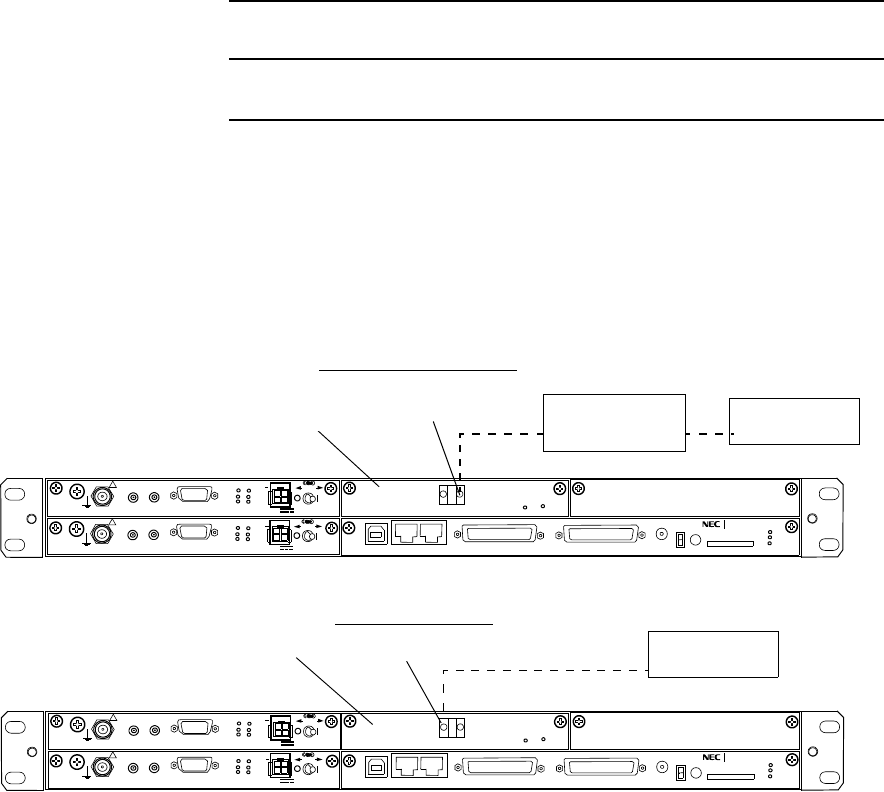
ROI-S05751 CORRECTIVE MAINTENANCE
5-19
Chart 5-2 (Cont’d)
Step Procedure
B. OPTICAL INTERFACE
Caution: To avoid damage to your eyes, do not stare into laser
beam or view directly with optical instruments. (Class
1 Laser Product).
1 At the transmitting end, disconnect OPT cable from the STM1
IN connector on the OC-3 INTFC (see Fig. 5-2),
SELV
!
AUX/ALM
NMS NE
ALM
SC IN/OUT EOW
PROTECT
CALL MMC
MAINT
MEMORY
IDU
XIF IN XIF OUT
IF IN/OUT
TX
RX
RESET
XPIC CTRL
XPIC
PWR
ODU
MD/
CBL PWR
PASOLINK NEO
LCT
OC-3 OUT OC-3 IN
PULL
SELV
!
XIF IN XIF OUT
IF IN/OUT
TX
RX
RESET
XPIC CTRL
XPIC
PWR
ODU
MD/
CBL PWR
PULL
ONLINE
G
G
G
G
STM/SONET
ANALYZER
OC-3 INTFC
TRANSMITTING END
IDU
OC-3 (OPT) IN
STM/SONET
ANALYZER
OC-3 (OPT) OUT
OPTICAL
VARIABLE
ATTENUATOR *
RECEIVING END
Equipped with OC-3 Optical Interface
IDU
SELV
!
AUX/ALM
NMS NE
ALM
SC IN/OUT EOW
PROTECT
CALL MMC
MAINT
MEMORY
IDU
XIF IN XIF OUT
IF IN/OUT
TX
RX
RESET
XPIC CTRL
XPIC
PWR
ODU
MD/
CBL PWR
PASOLINK NEO
LCT
OC-3 OUT OC-3 IN
PULL
SELV
!
XIF IN XIF OUT
IF IN/OUT
TX
RX
RESET
XPIC CTRL
XPIC
PWR
ODU
MD/
CBL PWR
PULL
ONLINE
G
G
G
G
(Blank)
(Blank)
OC-3 INTFC
Fig. 5-2 BER Measurement for OC-3 Signal
2 At the receiving end, disconnect the OPT cable from the STM1
OUT connector on the OC-3 INTFC (see Fig. 5-2),
3 At both transmitting and receiving ends, set the STM/SONET
Analyzer as follows:

CORRECTIVE MAINTENANCE ROI-S05751
5-20
Chart 5-2 (Cont’d)
Step Procedure
OC-3 INTFC(OPTICAL)
• Bit rate : 155.52 Mbps
• Code format : OC-3, NRZ
• Level S-1.1 L-1.1
IN : −8 to −28 dBm/ −10 to −34 dBm
OUT : −8 to −15 dBm/ 0 to −8 dBm
• Wave length
IN : 1310 nm
OUT : 1310 nm
Note: Operation of the TX SW and RX SW are not required in
1+0 system.
4 In HS system, set the TX SW to No.1 or No.2 to On condition at
transmitting end, (refer to Chart 2-3)
5 At receiving end, set the RX SW to either No.1 or No.2 to On
condition,
6 Measure BER and confirm that the values are indicated as
follows:
Requirement: 1 x 10–12 or less
7 At receiving end, change setting of the RX SW to opposite No.1
or No.2 from it in step 5 and confirm that the measured value
satisfies requirement given in step 6,
8 Change setting of the TX SW to opposite No.1 or No.2 from it
in step 4 and confirm that the measured value satisfies
requirement given in step 6,
9 At receiving end, change setting of the RX SW to opposite No.1
or No.2 from it in step 7 and confirm that the measured value
satisfies requirement given in step 6,
10 Restore all connections and controls to normal.
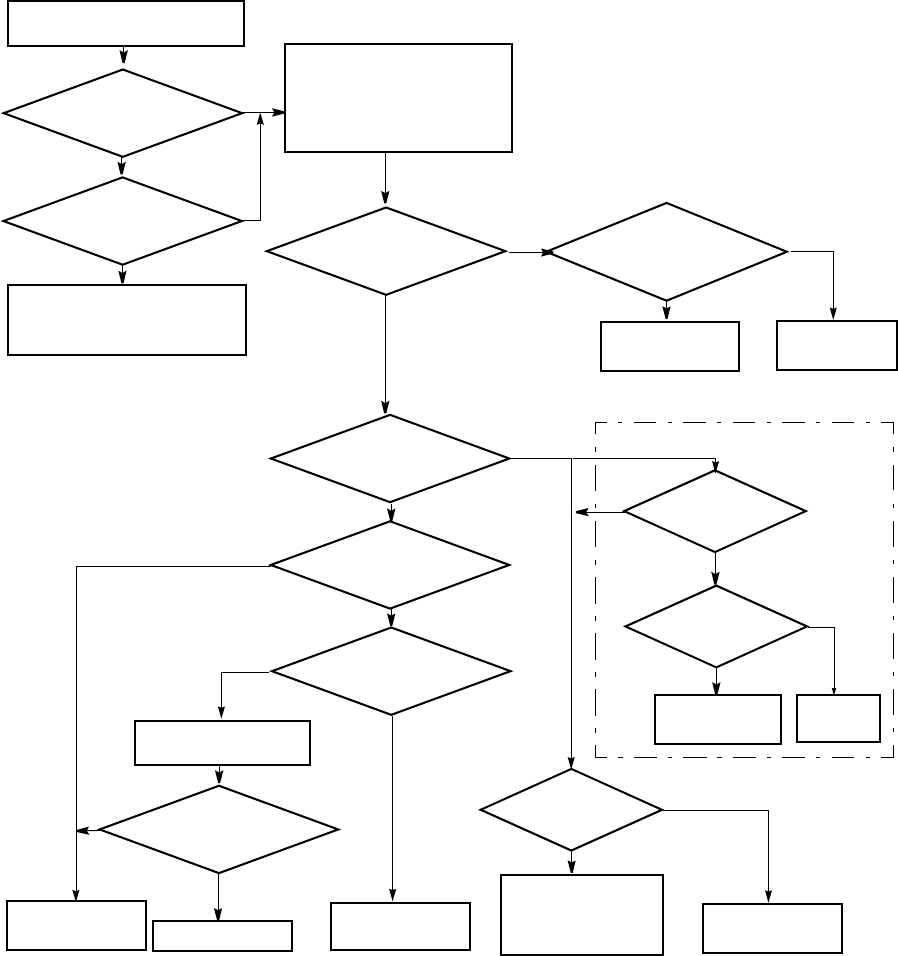
ROI-S05751 CORRECTIVE MAINTENANCE
5-21
5.1.5 Trouble Shooting Flow
When alarm condition occurs, red alarm LEDs on the IDU are lit except
when there is a power supply failure. Faults can be distinguished using the
LED indicators on the front panel of the IDU. Connect the LCT to the
equipment and check the equipment conditions in according with the flow
chart are shown in Fig. 5-3 to Fig. 5-5.
Is ODU ALM indicator (red) on the
IDU lighted?
YES
Is
IDU ALM indicator
(red) on the IDU
lighted?
NO
YES
Are
both IDU and ODU ALM
indicators (red)
flashing?
Check the IF cable connection and
connectors whether the cable is
open or short circuit.
YES
Is
TX power of the ODU is
indicated normal?
YES
Is
TX Input
indicated normal?
The
IF cable type,
cable length and cable loss are
used standard.
Change the IF
cable to standard.
Is TX power
vary with ATPC manual
control?
NO
Replace the ODU
with a spare.
YES
Replace the ODU with a
spare, if TX power alarm
continues when
temperature is improved.
YES
Is
APC of the ODU is indicated
normal?
NO NO
YES
Replace the ODU
with a spare.
NO Is
ODU CPU is indicated
normal?
NO
Reset CPU of the ODU.
Is
ODU ALM is indicated
normal?
NO
Check the RX
section of the ODU.
End
YES
YES
Connect the LCT to the IDU and
check ALARM/STATUS menu.
Check every items whether
indicated status is alarm or normal.
NO
NO
YES
Replace the ODU
with a spare.
Is
LO REF indicated
normal?
NO
YES
Replace the ODU
with a spare.
Is
XREF (MODEM)
indicated normal?
NO
YES
Check the
IDU section.
For XPIC
Fig. 5-3 ODU TX Section Troubleshooting Flowchart
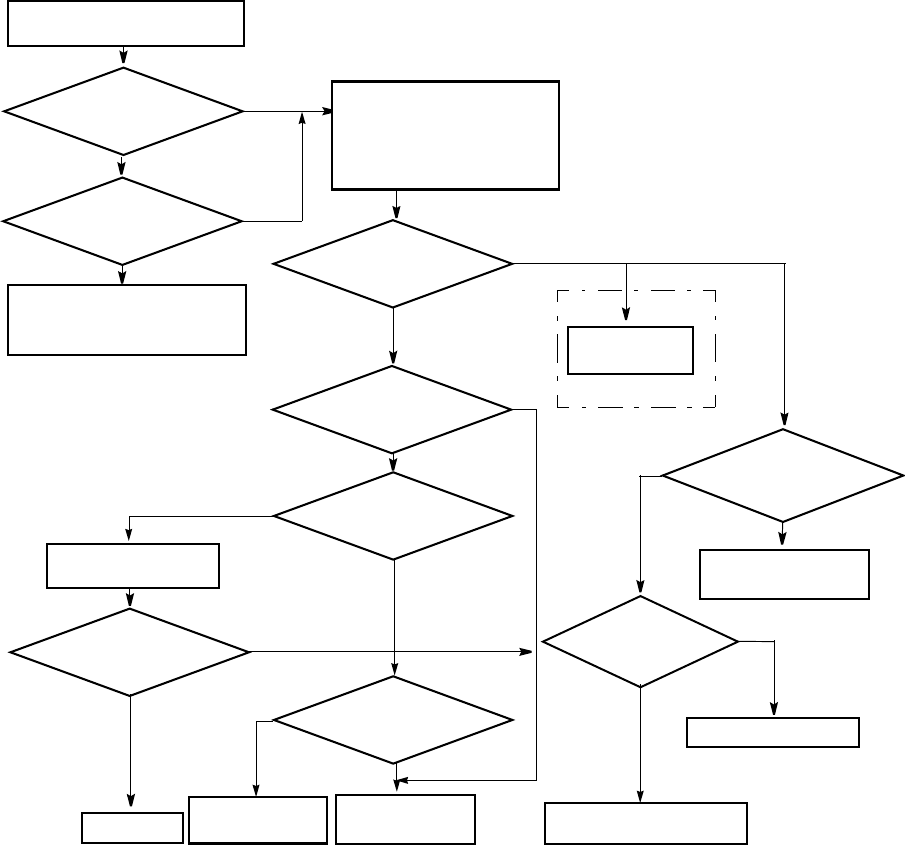
Is ODU ALM indicator (red) on
the IDU lighted?
YES
NO
YES
Are
both IDU and ODU ALM
indicators (red)
flashing?
Check the IF cable connection and
connectors whether the cable is
open or short circuit.
Connect the LCT to the IDU and
check ALARM STATUS menu.
Check every items whether
indicated status is Alarm or Normal.
Is
RX Level
indicated Normal?
Is RXLEVEL by
RSL monitor vary at random
interval?
Are
frequency value at
opposite site and local
site correct?
NO
NO
YES
Check fading or
interference.
YES
Is
IDU ALM indicator (red)
lighted?
YES
YES
Is
APC of the ODU is indicated
Normal?
Is
ODU CPU is indicated
Normal?
Reset CPU of the ODU
Is
ODU ALM is indicated
Normal?
Replace the ODU
with a spare.
End
YES
NO
NO
YES
NO
Check Antenna system or
Replace the ODU with a spare.
Set proper frequency.
NO
YES
Is
ODU TX section are
checked?
YES
NO
NO
Check the TX
section of the ODU.
Check the ODU
TX section.
For XPIC
CORRECTIVE MAINTENANCE ROI-S05751
5-22
Fig. 5-4 ODU RX Section Troubleshooting Flowchart
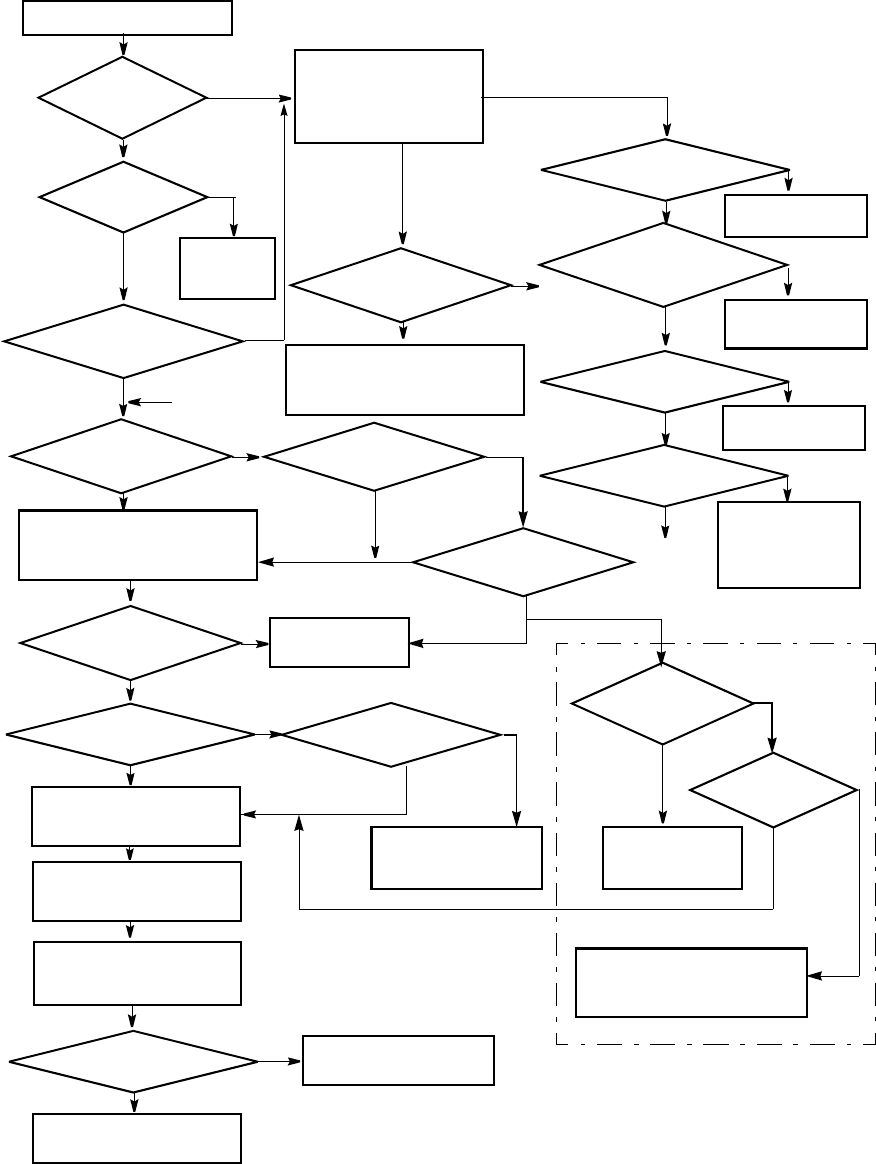
Is IDU ALM indicator (red) on
the IDU lighted?
YES
YES
Is
ODU ALM indicator
(red) on the IDU
lighted?
NO
NO
Are
both IDU and ODU ALM
indicators (red)
flashing? Check the IF cable connection and
connectors whether the cable is
open or short circuit.
Connect the LCT to the IDU
and check ALARM STATUS
menu. Check every items
whether indicated status is
Alarm or Normal.
Connect the SONET Analizer for
BER measurement.
Select Far End loopback from
Control menu in the Maintenance
Menu on the LCT.
Display ALARM/STATUS items
from main menu on the LCT
again.
YES
Is
Output LOS indicated
Normal?
Is
IF Cable indicated
Short?
YES
NO A
Is
IDU indicated
Normal?
YES
NO
A
Select IF Loopback from
Maintenance1 menu in the
Maintenance Menu on the LCT.
Is
MOD/DEM indicated
Normal?
YES
NO Replace the MODEM
with a spare.
Is
AIS Generated indicated
Normal? NO
Check associated DTE
and cable connection.
Is
Input LOS indicated
Normal?
NO
NO
Is
Output LOS indicated
Normal?
YES NO
YES
( ) INTFC faulty.
Replace the ( ) INTFC
Check associated DTE and
cable connection at
opposite site.
YES Check associated
DTE at opposite site.
Is
AIS or MS-AIS Received
indicated
Normal?
NO
YES Check associated
DTE at local site.
Is
CH Usage indicated
Normal? NO
YES Set CH usage correct.
Is
MOD/DEM indicated
Normal?
YES
NO Is
status of LAN INTFC indicated
Normal? NO
YES Perform LAN device
reset and check LAN
cable or associated
external equipment.
A
YES
YES
Is
PWR LED on the
MODEM lit?
Replace Fuse
in the
MODEM.
NO
Is
XIF indicated
normal?
YES Is
MOD indicated
Normal?
NO
NO
Is
XREF indicated
normal?
YES
YES
NO
Replace the MODEM
with a spare.
Check the XIFcable, IDU and ODU
of the opposite pol. CH or setting of
the opposite station.
For XPIC
ROI-S05751 CORRECTIVE MAINTENANCE
5-23
Fig. 5-5 IDU Section Troubleshooting Flowchart
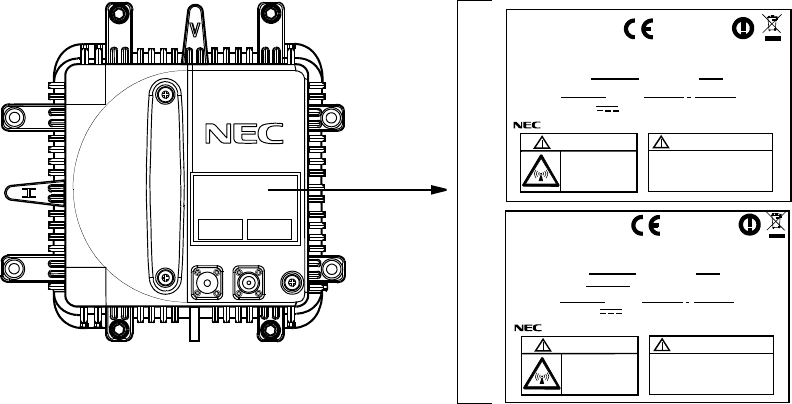
CORRECTIVE MAINTENANCE ROI-S05751
5-24
5.2 Replacement
The replacement procedures of the IDU and ODU is described below.
5.2.1 ODU Replacement
The procedures for replacing the ODU with a spare are given in the Chart
5-3. The label attached to the side of ODU indicates the ODU type (see Fig
5-6). To replace the ODU, prepare another ODU of the same type as
indicated on the label of the failed one.
Check the name plate of the spare ODU. When the indicated items are
coincided, the ODU can be replaced.
Caution: Do not remove/connect the IF cable with the IDU power
ON. Turn the IDU power OFF before connecting/
disconnecting the IF cable, or equipment may be damaged.
Caution: To avoid microfonic properties, occurrence of bit errors,
when installing the ODU on the HYB or OMT, protect the
ODU from mechanical knocks which is not be replaced.
6-38 GHz ODU
FG
IFL
MON
RX LEV
TRP-( )G-1B
0678
NLITE E
TRP-( )G-1B
OUTDOOR UNIT (NHG)
SHIFT FREQUENCY
MHz SUB BAND
(NWA-009034)
WEIGHT 3.5kg/ - 48V 0.5A
NEC Corporation TOKYO JAPAN MADE IN JAPAN
CAUTION
Non-ionizing
radiation
0678
-48V INPUT
Power down IDU before
disconnection or
connection of cable.
NLITE E
TX
HIGH/LOW
WEIGHT 3.5kg/ - 48V 0.5A
NEC Corporation TOKYO JAPAN MADE IN JAPAN
CAUTION
Non-ionizing
radiation
-48V INPUT
Power down IDU before
disconnection or
connection of cable.
MHz
TX FREQUENCY
OUTDOOR UNIT (NHG)
SHIFT FREQUENCY
MHz SUB BAND
TX
HIGH/LOW
SERIAL No. DATE
SERIAL No. DATE
(NWA-009034)
NLite E
Fig. 5-6 ODU Type and Frequency Indication Label
Note: Before replacing the ODU in XPIC, perform the control of XPIC
Local and XPIC Remote Reset by the LCT for Main Master or
Sub Master channel that is to be used online.
The mounting and demounting the ODU from/to antenna, refer to the
Installation and Initial Line up in Section III.
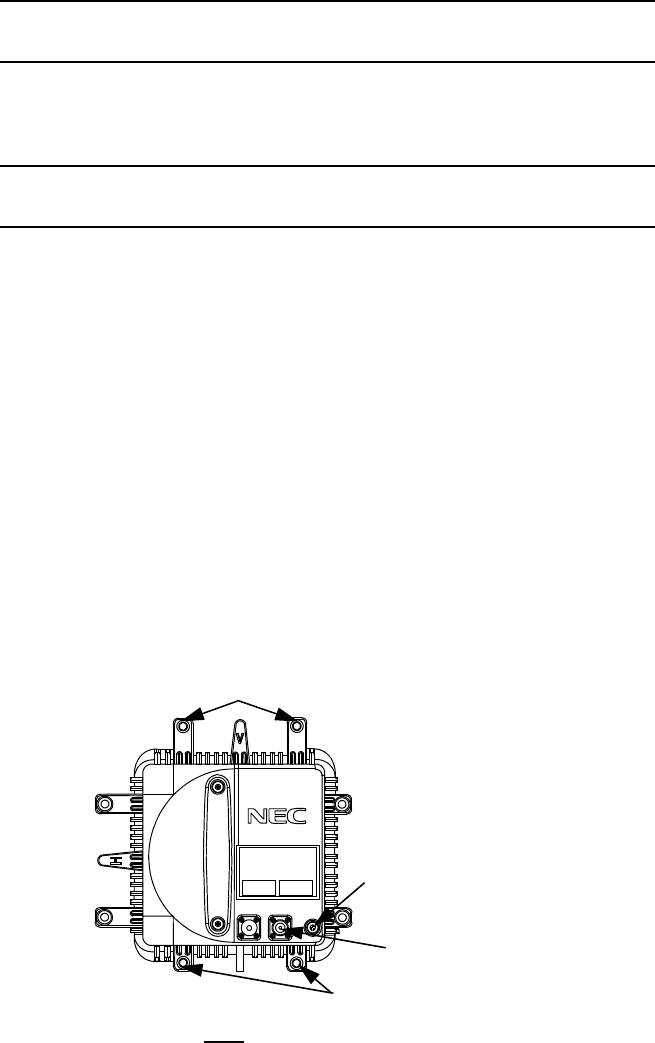
ROI-S05751 CORRECTIVE MAINTENANCE
5-25
Chart 5-3 ODU Replacement
Apparatus:
T type hexagonal driver
Step Procedure
REMOVING
1 For 1+1 configuration, switchover the TX SW and RX SW for
the standby channel is to be replaced,
2 Turn off the power switch on the MODEM which is connected
to the ODU is to be replaced,
3 Remove the self-bonding tape from the IF IN/OUT connector,
4 Disconnect the IF cable from the IF IN/OUT connector on the
ODU,
5 Disconnect ground cable from the FG terminal on the ODU,
6 Loosen four bolts fixed the ODU with a T type hexagonal
driver,
FG
IFL
MON
RX LEV
SCREWS
SCREWS
ODU
IF
CABLE
GROUND
CABLE
NLite E
7 Remove the ODU from the bracket,
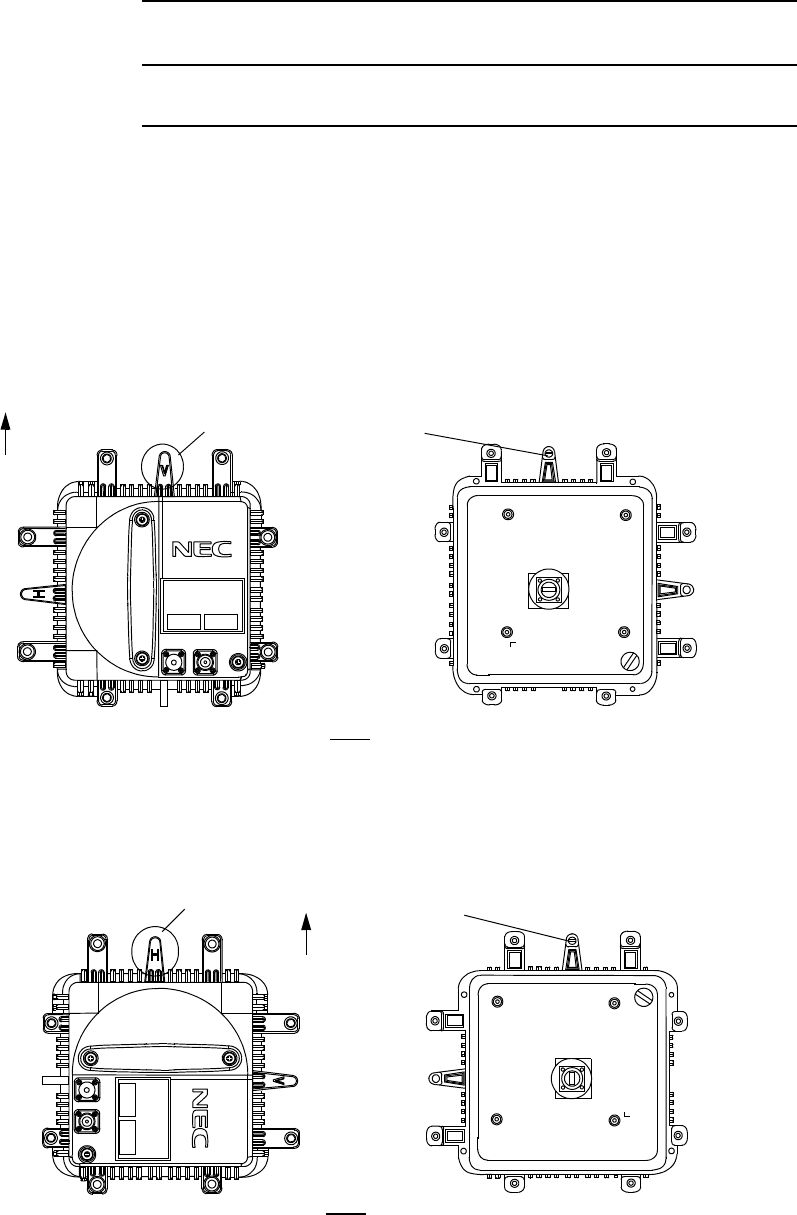
CORRECTIVE MAINTENANCE ROI-S05751
5-26
Chart 5-3 (Cont’d)
Step Procedure
MOUNTING
8 When the ODU is used for vertical polarization, rotate the ODU
so that the plate marked V is on top,
V POLARIZATION
PLATE MARKED V
UP
FG
IFL
MON
RX LEV
Guide Pin
ODU
NLite E
Note: Remove the protection metallic plate covering the waveguide
hole on ODU.
9 When the ODU is used for horizontal polarization, remove the
guide pin fixed on the plate marked V,
10 Insert the guide pin removed in step 8 behind of the plate
marked H,
11 Rotate the ODU so that the plate marked H is on top,
PLATE MARKED H
UP
FG
IFL
MON
RX LEV
Guide Pin
ODU H POLARIZATION
NLite E
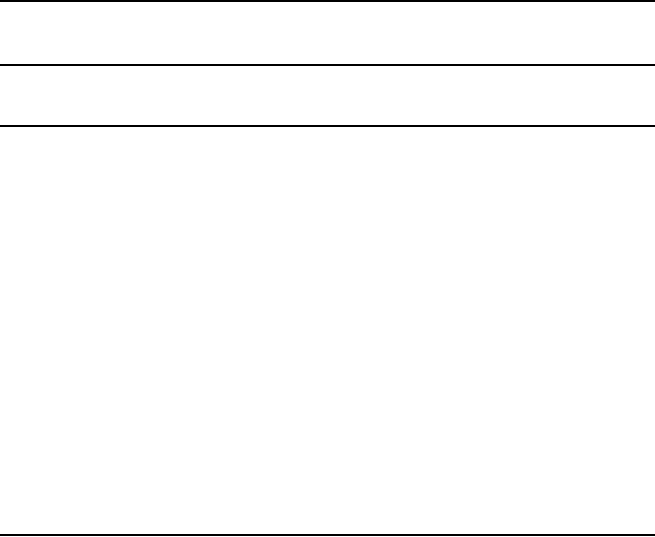
ROI-S05751 CORRECTIVE MAINTENANCE
5-27
Chart 5-3 (Cont’d)
Step Procedure
12 Fit the spare ODU onto the bracket,
Note: Be careful not to damage the flange and O-ring.
13 Mount the spare ODU onto the bracket and tighten the four
screws on the ODU,
14 Reconnect the IF cable to the IF IN/OUT connector on the
ODU,
15 Wrap twice the IF IN/OUT connector with self-bonding tape for
waterproofing. (see Fig. 5-7 (1/2) and (2/2))
16 Reconnect ground cable removed in step 4 to FG terminal,
17 Turn on the power switch on the IDU.
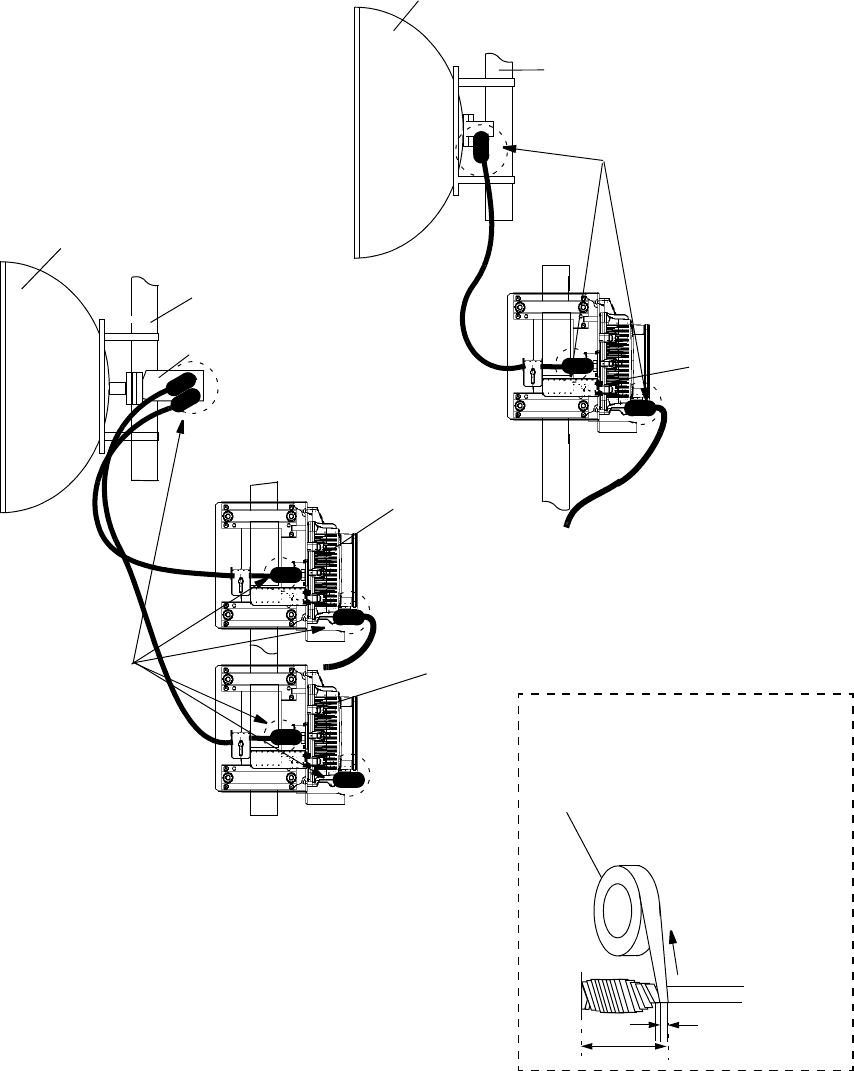
POLE
ANT
6-8 GHz BAND
ODU
ODU
(*)
Note: * These parts should be wrapped by self-bonding
tape for waterproof.
6-8 GHz BAND
self-bonding
tape
stretch
Wrap twice the IF IN/OUT connector with
self-bonding tape for waterproofing.
a half of tape width
ODU
twice
(*)
ODU
POLE
ANT
HYB
CORRECTIVE MAINTENANCE ROI-S05751
5-28
Fig. 5-7 Location of Connector for Waterproof (1/2)
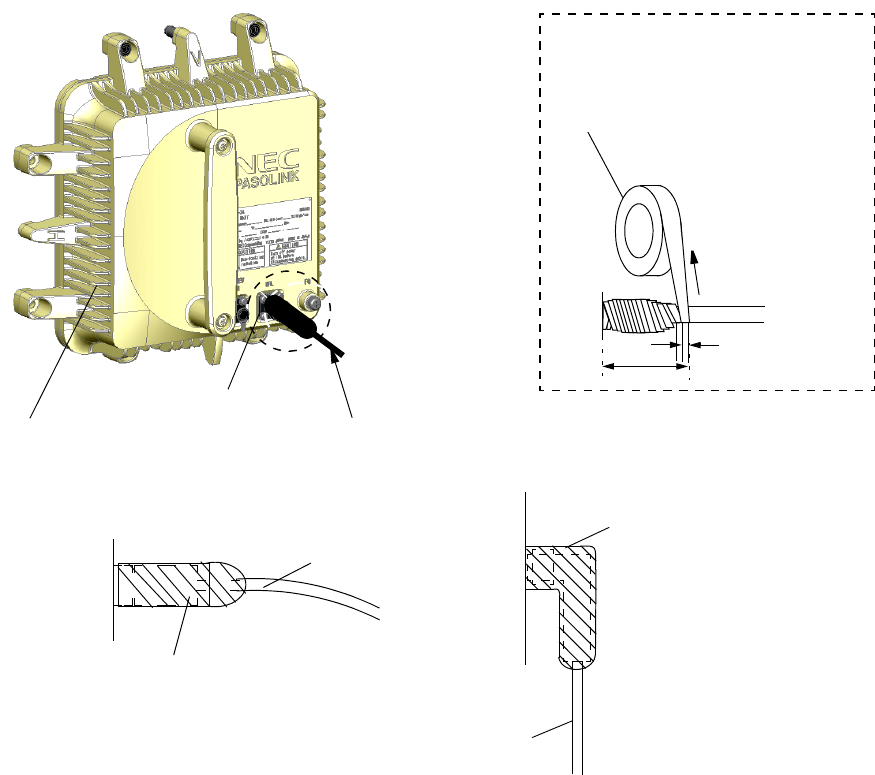
IF CABLE
SELF-BONDING TAPE
ODU
Note: The self-bonding tape should be prepared by customer.
SELF-BONDING TAPE
ODU
IF CABLE
IN CASE OF L−ANGLE
ODU
CONNECTOR
self-bonding
tape
stretch
Wrap twice the IF IN/OUT connector with
self-bonding tape for waterproofing.
a half of tape width
ODU
twice
This part should be wrapped by
self-bonding tape for waterproof.
ROI-S05751 CORRECTIVE MAINTENANCE
5-29
Fig. 5-7 Location of Connector for Waterproof (2/2)

CORRECTIVE MAINTENANCE ROI-S05751
5-30
5.2.2 IDU and Module Replacement
The procedures for replacing IDU/module with a spare are given in the
Chart 5-4.
Chart 5-4 IDU and Module Replacement
Caution: Persons performing maintenance must take necessary steps
to avoid electro-static discharge which may damage the
modules or cause error. Wear a conductive wrist strap
connected to the grounded (G) jack on the front of the
equipment shelf. This will minimize static build-up during
maintenance. (see Fig. 2-1 in Chapter 2).
Caution: Do not remove/connect the IF cable with the IDU power
ON. Turn the IDU power OFF before connecting/
disconnecting the IF cable, or equipment may be damaged.
This chart contains:
A. Module replacement
B. IDU replacement
Apparatus:
Suitable Screwdriver
Step Procedure
A. MODULE REPLACEMENT
Note: Be careful do not touch the electric parts and printed
circuit on the module.
Note: The top surface of the IDU above MODEM is hot in
operation.
Note: The maintenance personnel should report starting
replacement from a station to the relevant station.
1 Referring to Chart 2-1, set the IDU to maintenance ON
condition by LCT,
2 For 1+1 configuration, switchover the TX SW and RX SW for
the standby channel from the working channel which is to be
replaced,

ROI-S05751 CORRECTIVE MAINTENANCE
5-31
Chart 5-4 (Cont’d)
Step Procedure
Removing MODEM
3 When the MODEM will be replaced, turn off the power switch
on the corresponding MODEM which is to be replaced,
4 Disconnect cables as following order,
(1) Disconnect power supply cable from SELV connector.
(2) Disconnect IF cable from IF IN/OUT connector. The
adapter is reused.
(3) Disconnect ground cable from the ground terminal.
5 Loosen two screws on the MODEM module, (See Fig. 5-8)
6 Remove the MODEM module from the IDU shelf,
Mounting MODEM
1 When the MODEM is replaced, check that the power switch is
set to Off position,
2 Align the MODEM to the shelf, then push it in until the multipin
connector firmly fits,
3 Tighten the two screws on the module,
4 Connect cables as following order,
(1) Connect ground cable to the ground terminal.
(2) Connect IF cable with adapter to IF IN/OUT connector.
(3) Connect power supply cable to SELV connector.
5 Turn on the power switch on the MODEM,
6 Check that the MODEM is normal on the Alarm/Status display,
7 Check that the installed MODEM module exists in the
INVENTRY list,
8 Check the operation of the replaced MODEM module,
9 Referring to Chart 2-1, set the IDU to maintenance OFF
condition by LCT.
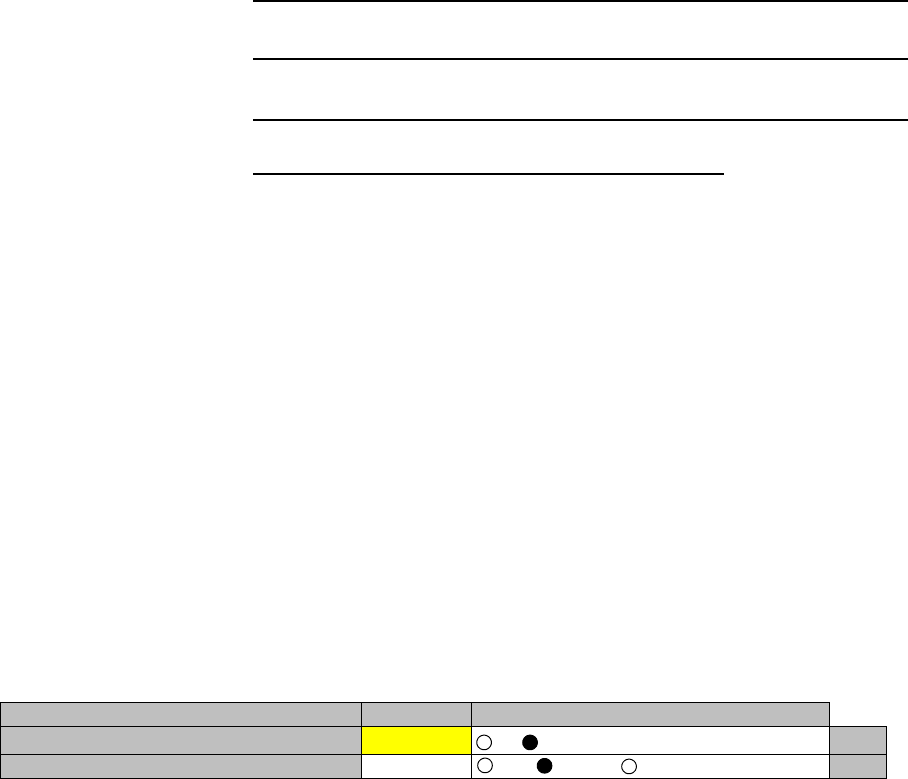
CORRECTIVE MAINTENANCE ROI-S05751
5-32
Chart 5-4 (Cont’d)
Step Procedure
Replacement of the OC-3 (Optical) INTFC in APS
Caution: Do not stare at the laser beam or look at it directly with
optical instruments. Otherwise, it may hurt your eyes (Class
1 Laser Product)
For the OC-3 (OPTICAL) INTFC replacement in APS configuration, the
OC-3 (OPTICAL) INTFC can be replaced without power OFF and not
affect traffic when doing replacement as following order. (When the traffic
is not applied to the system, turn off the power switch before performing
the replacement of the module.). The maintenance personnel should report
starting replacement from a station to the relevant station.
1 Referring to Chart 2-1, set the IDU to maintenance ON
condition by LCT,
2 Click on “APS Manual Control” from “Maintenance 1” menu,
3 Switchover the module is to be replaced to OFF LINE. Click on
the “Working” or “Protection” button and click on the “Set”
button, then, value turns to selected side for ON LINE,
4 Check that the “ON LINE” LED is unlit on the OC-3
(OPTICAL) INTFC which is to be replaced,
5 Set the PROTECT SW on the module front to ON (for upper
position), then the MAINT LED starts the blink,
The module can be replaced under the MAINT LED is blinking,
(a) There is need to install the MMC. The MEMORY LED blinks
during the data is uploading to the MMC, the MAINT LED
starts the blink after upload of the data has been completed.
(b) When the CTRL becomes the PROTECT mode, LCT
connection takes timeout.
6 Disconnect optical cables from OC-3 OUT and OC-3 IN
connectors on the OC-3 (OPTICAL) INTFC module is to be
replaced,
---Maintenance1---
Item Value Setting
Maintenance On Off On Set
APS Manual Control Working Auto Working Protection Set

ROI-S05751 CORRECTIVE MAINTENANCE
5-33
Chart 5-4 (Cont’d)
Step Procedure
7 Loosen two screws on the OC-3 (OPTICAL) INTFC module is
to be replaced, (See Fig. 5-11)
8 Extract the OC-3 (OPTICAL) INTFC module from the IDU
shelf,
Note: Be careful not catch the module on the cable when
extracting the module. If the module caught on the live
cables, it may be caused radio link error.
9 Install the spare OC-3 (OPTICAL) INTFC module into the IDU
shelf,
10 Connect the OPT cables to the OC-3 OUT and OC-3 IN
connectors on the OC-3 (OPTICAL) INTFC module,
11 Set the PROTECT SW on the module front to OFF (for lower
position), then the MAINT LED turns to lit,
When the PROTECT SW turns to OFF, it will appear
momentary that events have been latched.
12 Check that the OC-3(1) and OC-3(2) are normal on the Alarm/
Status display,
13 Check that the installed OC-3 (OPTICAL) INTFC module
exists in the INVENTRY list,
14 Check the operation of the replaced OC-3 (OPTICAL) INTFC
module,
15 Click on the “Auto” button and click on the “Set” button, then,
value turns to Auto,
16 Click on the “Off” button of Maintenance and Click on the “Set”
button,
17 This work finishes.
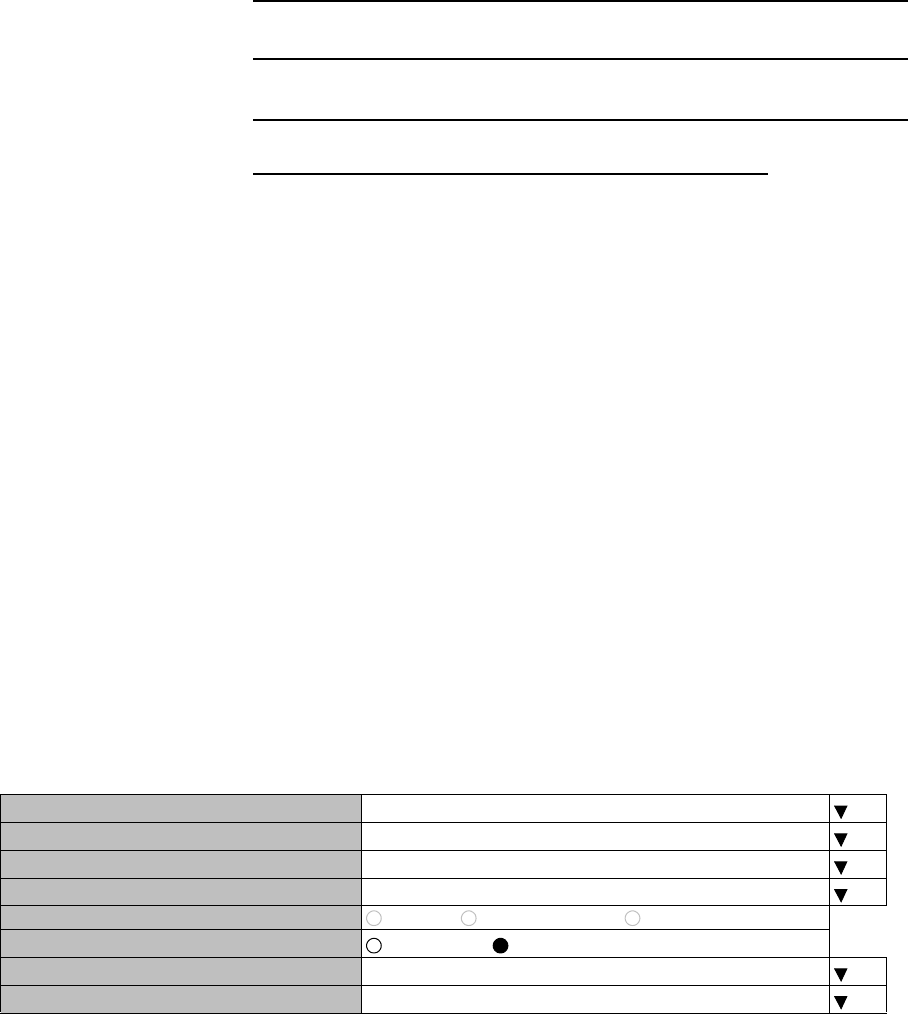
CORRECTIVE MAINTENANCE ROI-S05751
5-34
Chart 5-4 (Cont’d)
Step Procedure
System Upgrade for APS of OC-3 (OPTICAL) INTFC
Caution: To avoid eye damage, do not stare at the laser beam or look
at it directly with optical instruments. (Class 1 Laser
Product)
For the change of OC-3 (OPTICAL) INTFC system to the APS system,
perform system setup without power OFF and not affect traffic when
doing replacement as following order. The maintenance personnel should
report starting replacement from a station to the relevant station.
1 Referring to Chart 2-1, set the IDU to maintenance ON
condition by LCT,
2 Click on the “Equipment Setup” button in “LCT MENU”, then
“Equipment Setup” menu is displayed,
3 Select “OC-3 OPT for APS” from pull-down menu of the
SUB(PROT),
4 Click on the “Available” setting button of the APS Function,
5 Click on the “SET” button in Common area, then “OK” is
displayed in Progress area when the setup is properly executed,
---Equipment Setup---
User Interface SONET OC-3
Redundancy Setting 1+1(Hot Standby TERM)
INTFC (Main) OC-3(OPTICAL)
INTFC (Prot) OC-3 OPT for APS
XPIC Usage Not Used Used(Main Master) Used(Sub Master)
APS Function Unavailable Available
Modulation Scheme 128QAM
Transmission Capacity 156MB
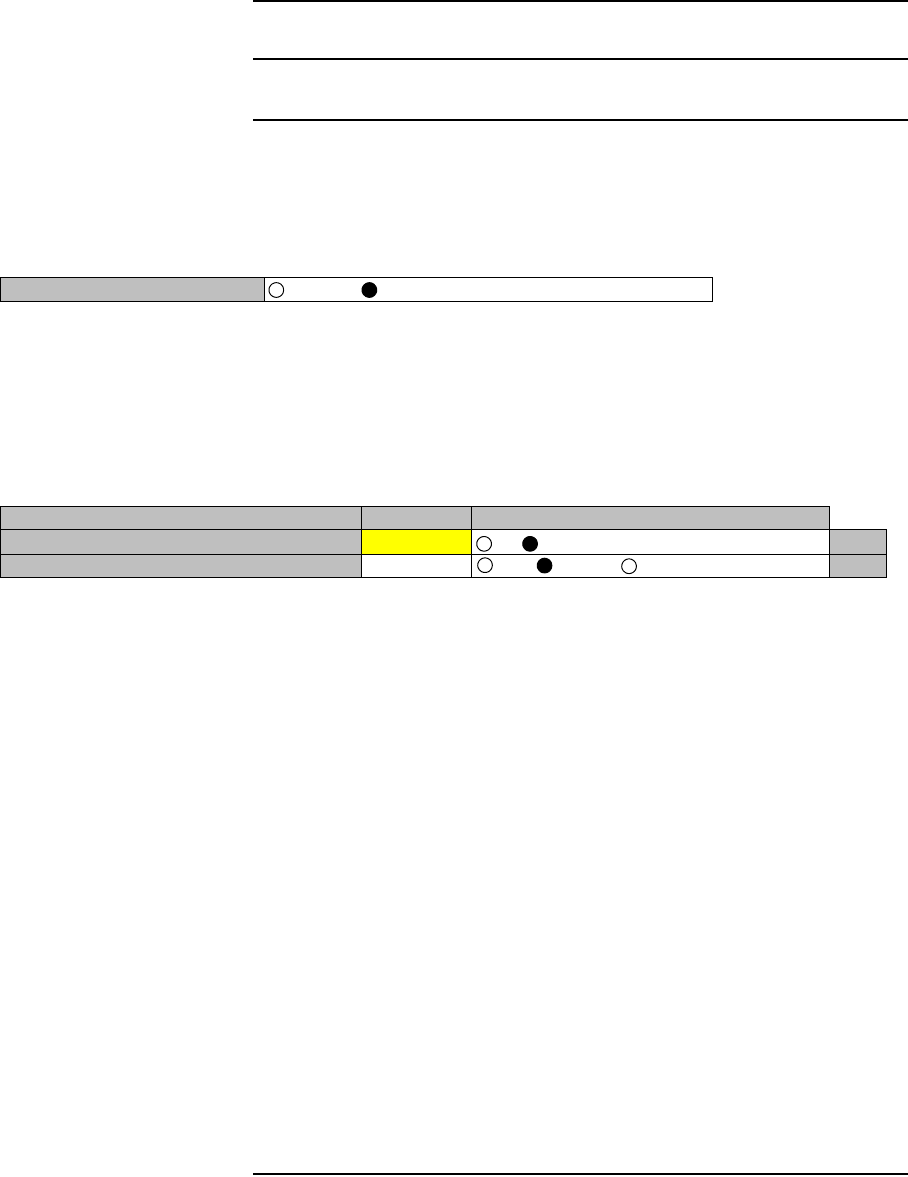
ROI-S05751 CORRECTIVE MAINTENANCE
5-35
Chart 5-4 (Cont’d)
Step Procedure
6 Click on the Provisioning button on “LCT MENU”,
7 Click on the “Forced” control button of the APS Maintenance
Mode item,
8 Click on the “SET” button in Common area, then “OK” is
displayed in Progress area when the setup is properly executed,
9 In the Maintenance1 menu, Click on the “Working” button of
the APS Manual Control and Click on the “Set” button, then,
value turns to “Working”,
10 Remove the blank cover of the Slot2 for OC-3 INTFC(2),
11 Install the OC-3 (OPTICAL) INTFC module into the Slot2,
12 Tighten two screws of the OC-3 (OPTICAL) INTFC module,
(See Fig. 5-11)
13 Connect the OPT cables to the OC-3 OUT and OC-3 IN
connectors on the OC-3 (OPTICAL) INTFC module,
14 Check that the OC-3(1) and OC-3(2) are normal on the Alarm/
Status display,
15 Check that the installed OC-3 (OPTICAL) INTFC module
exists in the INVENTRY list,
16 Check the operation of the installed OC-3 (OPTICAL) INTFC
module,
17 Click on the “Auto” button and Click on the “Set” button, then,
value turns to Auto,
18 Click on the “Off” button of Maintenance and Click on the “Set”
button,
19 This work finishes.
----Condition for APS---
APS Maintenance Mode Manual Forced
---Maintenance1---
Item Value Setting
Maintenance On Off On Set
APS Manual Control Working Auto Working Protection Set
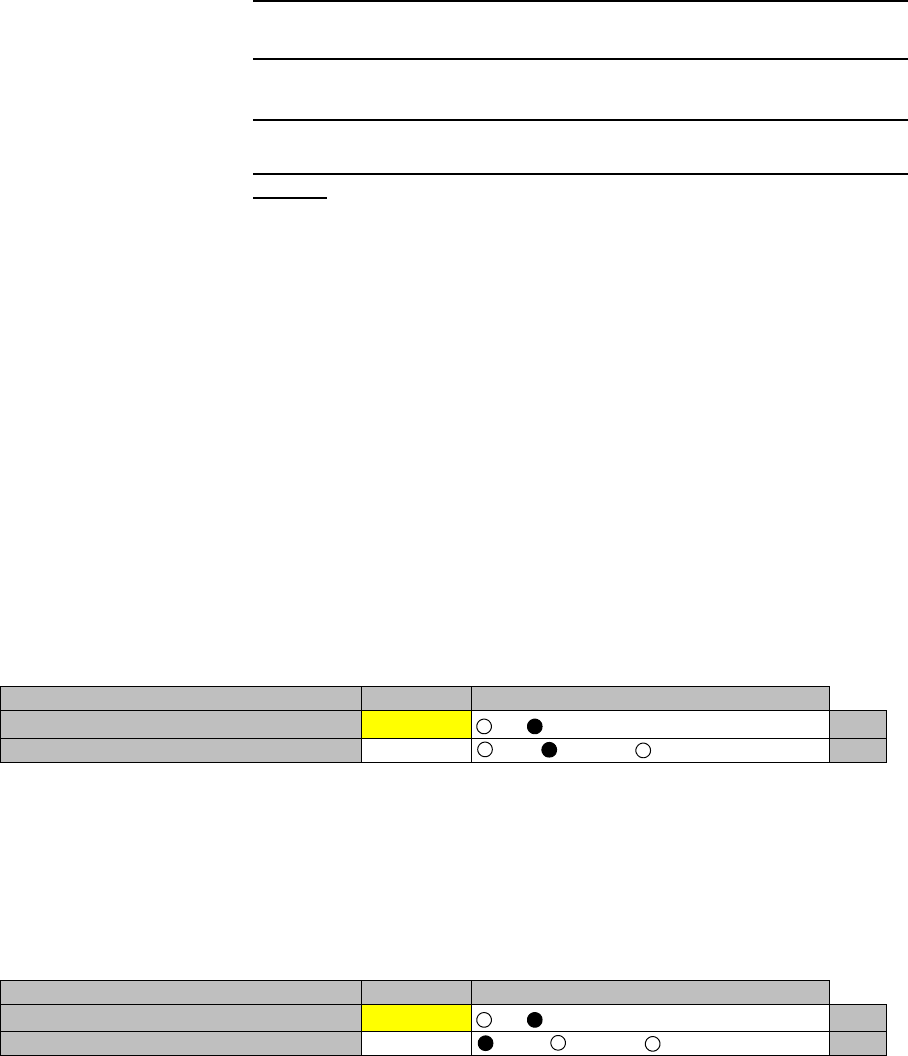
CORRECTIVE MAINTENANCE ROI-S05751
5-36
Chart 5-4 (Cont’d)
Step Procedure
System Change from e/w APS to w/o APS of OC-3 (OPTICAL)
INTFC
Caution: Do not stare at the laser beam or look at it directly with
optical instruments. Otherwise, it may hurt your eyes (Class
1 Laser Product).
For the change of OC-3 (OPTICAL) INTFC system of the APS system to
without APS system, perform system setup without power OFF and not
affect traffic when doing system change as following order. The
maintenance personnel should report starting system change from a station
to the relevant station.
1 Referring to Chart 2-1, set the IDU to maintenance ON
condition by LCT,
2 In the Maintenance1 menu, Click on the “Working” button of
the APS Manual Control and Click on the “Set” button, when
the Protection side is ON LINE, value turns to “Working”,
3 Click on the “Auto” button of the APS Manual Control and
Click on the “Set” button,
When the Working side is ON LINE, check that the APS
Manual Control is “Auto” mode,
4 Click on the “Equipment Setup” button in “LCT MENU”, then
“Equipment Setup” menu is displayed,
5 Select “Not Used” from pull-down menu of the SUB(PROT),
6 Click on the “Unavailable” setting button of the APS Function,
---Maintenance1---
Item Value Setting
Maintenance On Off On Set
APS Manual Control Working Auto Working Protection Set
---Maintenance1---
Item Value Setting
Maintenance On Off On Set
APS Manual Control Auto Auto Working Protection Set
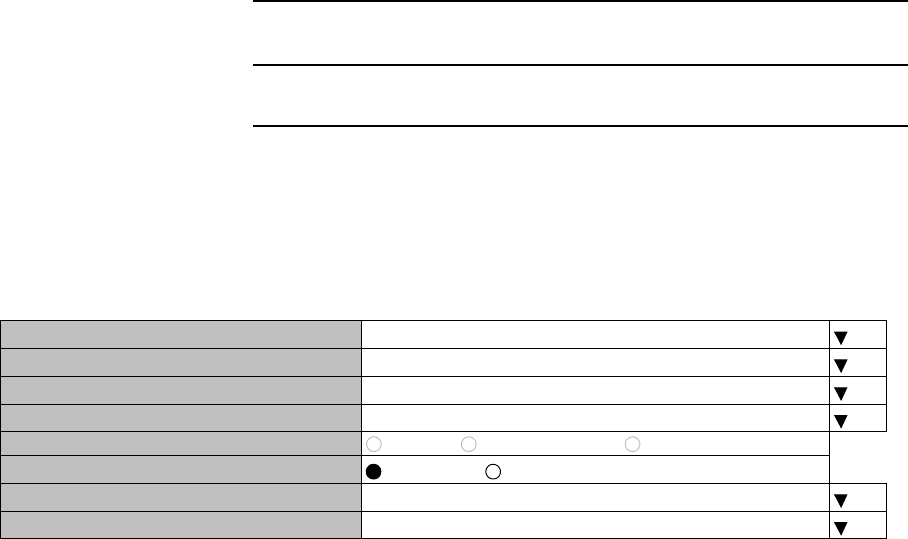
ROI-S05751 CORRECTIVE MAINTENANCE
5-37
Chart 5-4 (Cont’d)
Step Procedure
7 Click on the “SET” button in Common area, then “OK” is
displayed in Progress area when the setup is properly executed,
8 Perform step 8 to step 11 when it is needed,
9 Disconnect optical cables from OC-3 OUT and OC-3 IN
connectors on the OC-3 (OPTICAL) INTFC module in the
Slot2,
10 Loosen two screws on the OC-3 (OPTICAL) INTFC module is
to be replaced, (See Fig. 5-11)
11 Extract the OC-3 (OPT) INTFC module from the Slot2,
Note: Be careful not catch the module on the cable when
extracting the module. If the module caught on the live
cables, it may be caused radio link error.
12 Fit the blank cover with two screws to the Slot2,
13 Click on the “Off” button of Maintenance and click on the “Set”
button,
---Equipment Setup---
User Interface SONET OC-3
Redundancy Setting 1+1(Hot Standby TERM)
INTFC (Main) OC-3(OPTICAL)
INTFC (Prot) Not Used
XPIC Usage Not Used Used(Main Master) Used(Sub Master)
APS Function Unavailable Available
Modulation Scheme 128QAM
Transmission Capacity 156MB
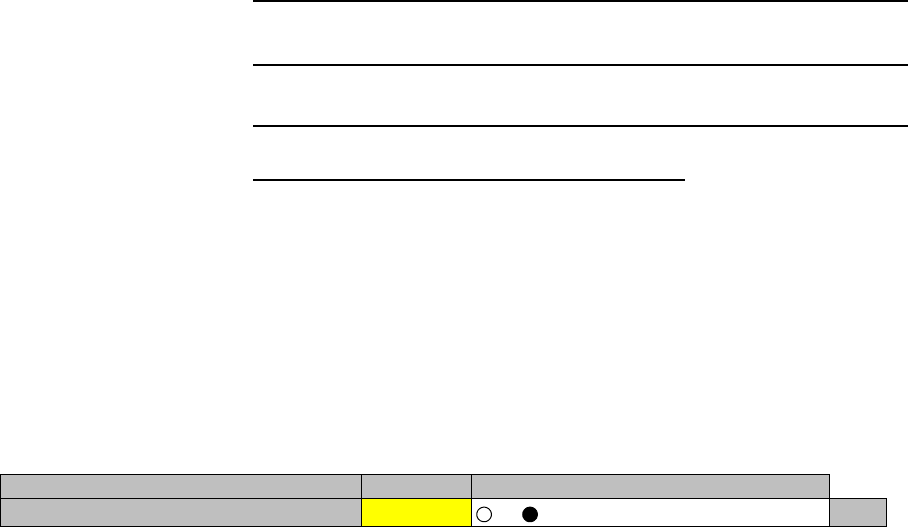
CORRECTIVE MAINTENANCE ROI-S05751
5-38
Chart 5-4 (Cont’d)
Step Procedure
Removing OC-3 INTFC, GbE INTFC, CTRL
1 Referring to Chart 2-1, set the IDU to maintenance ON
condition by LCT,
Note: When the CTRL is a failure, replace it with a spare as
explained below.
Note: When the CTRL is replaced without power OFF, refer to the
“Replacing the CTRL Used MMC or LCT”.
2 Turn off the power switch on the MODEM (both MODEM for
1+1 configuration),
3 Disconnect all the cables connected to the module,
4 Loosen two screws on the module, (See Fig. 5-11),
5 Extract the module,
Note: Be careful to avoid catching the module on the cable
when extracting the module. If the module is caught on
the live cables, it may cause a radio link error.
---Maintenance1---
Item Value Setting
Maintenance On Off On Set
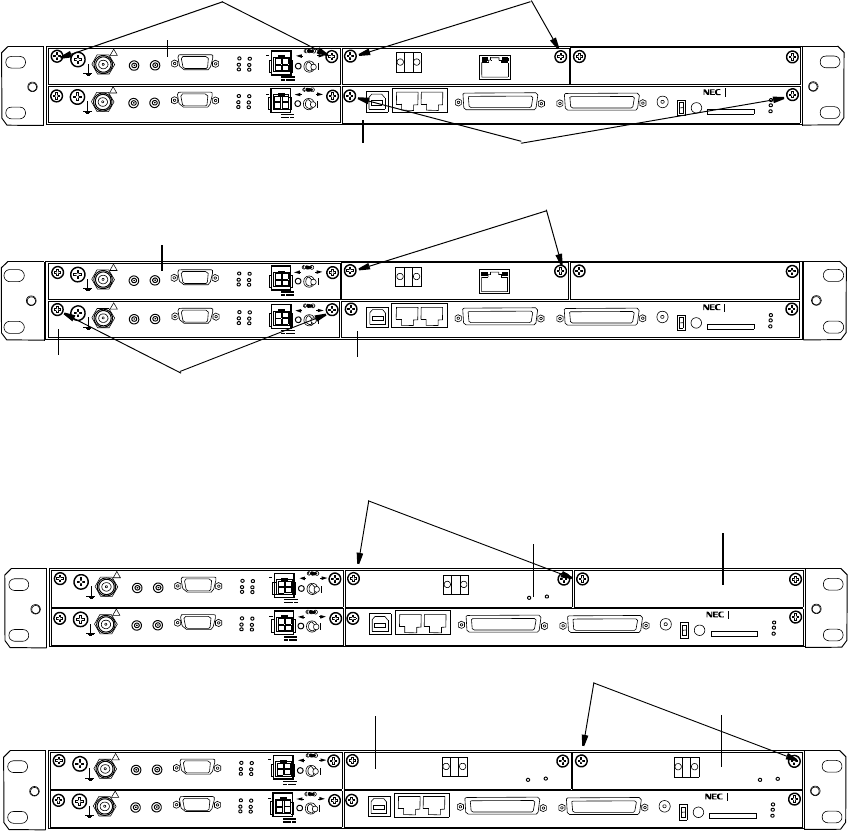
1+0 SYSTEM
1+1 SYSTEM
IDU
SELV
!
AUX/ALM
LCT NMS NE SC IN/OUT EOW
PROTECT
CALL MMC
MAINT
MEMORY
IDU
XIF IN XIF OUT
IF IN/OUT
TX
RX
RESET
XPIC CTRL
XPIC
PWR
ODU
MD/
CBL PWR
nlite e
FG
FG
PULL
SELV
!
XIF IN XIF OUT
IF IN/OUT
TX
RX
RESET
XPIC CTRL
XPIC
PWR
ODU
MD/
CBL PWR
PULL
SCREW
SCREW
SCREW
IDU
SCREW
SCREW
MODEM Gb E INTFC
CTRL
MODEM No. 1
MODEM No. 2 CTRL
Gb E INTFC
W/O APS SYSTEM
IDU
SELV
!
AUX/ALM
NMS NE
ALM
SC IN/OUT EOW
PROTECT
CALL MMC
MAINT
MEMORY
IDU
XIF IN XIF OUT
IF IN/OUT
TX
RX
RESET
XPIC CTRL
XPIC
PWR
ODU
MD/
CBL PWR
nlite e
LCT
OC-3 OUT OC-3 IN
PULL
SELV
!
XIF IN XIF OUT
IF IN/OUT
TX
RX
RESET
XPIC CTRL
XPIC
PWR
ODU
MD/
CBL PWR
PULL
ONLINE
G
G
G
G
(Blank Cover)
Slot2
SCREW
SELV
!
AUX/ALM
NMS NE
ALM
SC IN/OUT EOW
PROTECT
CALL MMC
MAINT
MEMORY
IDU
XIF IN XIF OUT
IF IN/OUT
TX
RX
RESET
XPIC CTRL
XPIC
PWR
ODU
MD/
CBL PWR
nlite e
LCT
OC-3 OUT OC-3 IN
PULL
SELV
!
XIF IN XIF OUT
IF IN/OUT
TX
RX
RESET
XPIC CTRL
XPIC
PWR
ODU
MD/
CBL PWR
PULL
ALM
OC-3 OUT OC-3 IN
ONLINE ONLINE
G
G
G
G
OC-3 (OPTICAL) INTFC OC-3 (OPTICAL) INTFC
SCREW
E/W APS SYSTEM
OC-3 (OPTICAL) INTFC
SELV
!
AUX/ALM
NMS NE SC IN/OUT EOW
PROTECT
CALL MMC
MAINT
MEMORY
IDU
XIF IN XIF OUT
IF IN/OUT
TX
RX
RESET
XPIC CTRL
XPIC
PWR
ODU
MD/
CBL PWR
nlite e
LCT
OC-3 OUT OC-3 IN
PULL
SELV
!
XIF IN XIF OUT
IF IN/OUT
TX
RX
RESET
XPIC CTRL
XPIC
PWR
ODU
MD/
CBL PWR
PULL
G
G
G
G
(Blank Cover)
OC-3 OUT OC-3 IN
(Blank Cover)
ROI-S05751 CORRECTIVE MAINTENANCE
5-39
Fig. 5-8 Demounting and Remounting Module
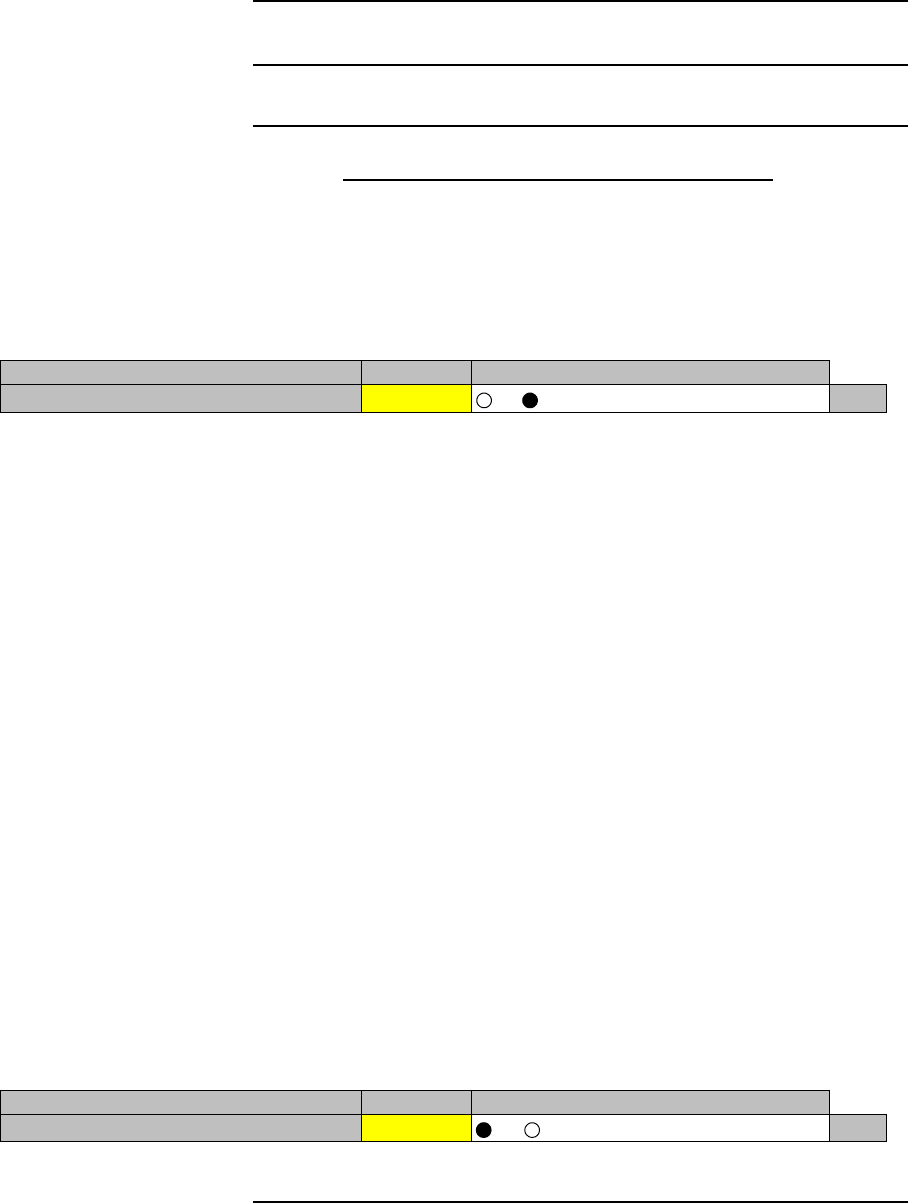
CORRECTIVE MAINTENANCE ROI-S05751
5-40
Chart 5-4 (Cont’d)
Step Procedure
Mounting OC-3 (OPTICAL) INTFC w/o APS
For the OC-3 (OPTICAL) INTFC mounting without APS, install the
module as following order,
1 Referring to Chart 2-1, set the IDU to maintenance ON
condition by LCT,
2 Turn OFF the power switch on the MODEM,
3 Align the OC-3 (OPTICAL) INTFC to the shelf, then push it in
until the multipin connector firmly fits,
4 Tighten the two screws on the module,
5 Connect optical cables to OC-3 OUT and OC-3 IN connectors,
Caution: Do not stare at the laser beam or look at it directly with
optical instruments. Otherwise, it may hurt your eyes (Class
1 Laser Product).
6 Turn ON the power switch on the MODEM,
7 Check that the “ON LINE” LED is lit on the OC-3 (OPTICAL)
INTFC which is replaced,
8 Check that the OC-3(1) is normal on the Alarm/Status display,
9 Check that the installed OC-3 (OPTICAL) INTFC module
exists in the INVENTRY list,
10 Check the operation of the installed OC-3 (OPTICAL) INTFC
module,
11 Click on the “Off” button of Maintenance and Click on the “Set”
button,
12 This work finishes.
---Maintenance1---
Item Value Setting
Maintenance On Off On Set
---Maintenance1---
Item Value Setting
Maintenance Off Off On Set
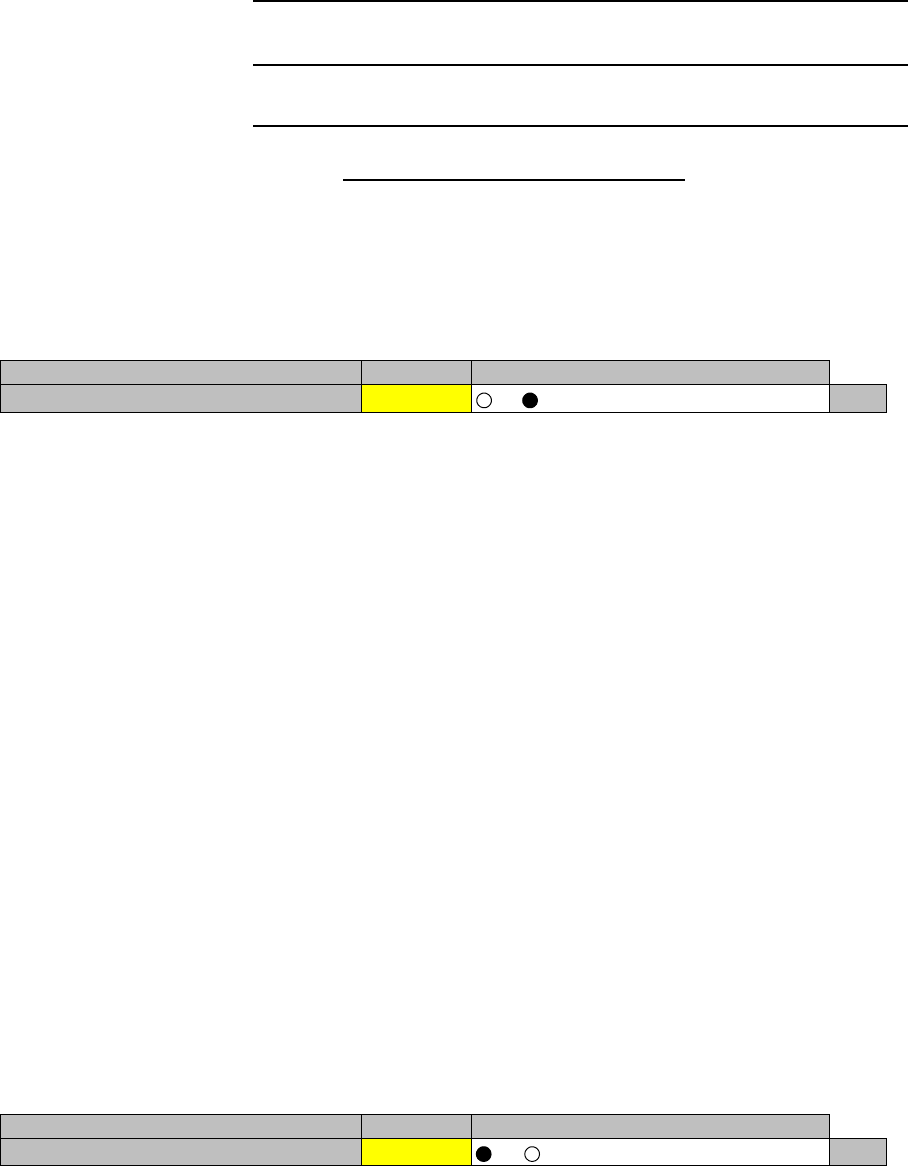
ROI-S05751 CORRECTIVE MAINTENANCE
5-41
Chart 5-4 (Cont’d)
Step Procedure
Mounting GbE (OPTICAL) INTFC
For the GbE (OPTICAL) INTFC mounting, install the module as
following order,
1 Referring to Chart 2-1, set the IDU to maintenance ON
condition by LCT,
2 Turn OFF the power switch on the MODEM,
3 Align the GbE (OPTICAL) INTFC to the shelf, then push it in
until the multipin connector firmly fits,
4 Tighten the two screws on the module,
5 Connect optical cables to 1000BASE-SX OUT and IN
connectors,
Caution: Do not stare at the laser beam or look at it directly with
optical instruments. Otherwise, it may hurt your eyes (Class
1 Laser Product).
6 Turn ON the power switch on the MODEM,
7 Check that the “ON LINE” LED is lit on the GbE (OPTICAL)
INTFC which is replaced,
8 Check that the OC-3(1) is normal on the Alarm/Status display,
9 Check that the installed GbE (OPTICAL) INTFC module exists
in the INVENTRY list,
10 Check the operation of the installed GbE (OPTICAL) INTFC
module,
11 Click on the “Off” button of Maintenance and Click on the “Set”
button,
---Maintenance1---
Item Value Setting
Maintenance On Off On Set
---Maintenance1---
Item Value Setting
Maintenance Off Off On Set
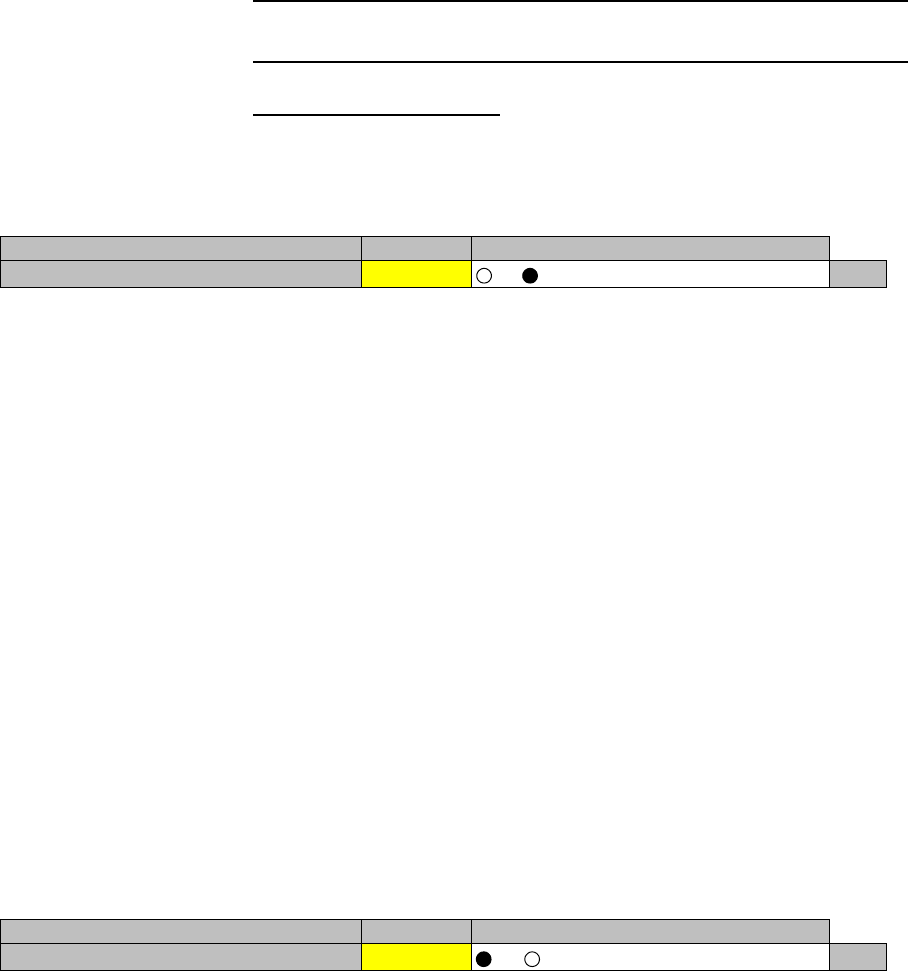
CORRECTIVE MAINTENANCE ROI-S05751
5-42
Step Procedure
OC-3/GbE INTFC, CTRL
1 Referring to Chart 2-1, set the IDU to maintenance ON
condition by LCT,
2 Turn OFF the power switch on the MODEM,
3 Check that the switch on the MODEM (both MODEM for 1+1
configuration) is off position,
4 Align the module to the IDU shelf, then push it in until the
multipin connector firmly fits,
5 Tighten two screws on the module,
6 Connect all cables to the module,
7 Turn on the power switch on the MODEM.
8 Check that the 4P LAN INTFC, OC-3, GbE INTFC, CTRL is
normal on the Alarm/Status display,
9 Check that the installed 4P LAN INTFC, OC-3, GbE INTFC,
CTRL module exists in the INVENTRY list,
10 Check the operation of the replaced 4P LAN INTFC, OC-3,
GbE INTFC, CTRL module,
11 Click on the “Off” button of Maintenance and click on the “Set”
button,
---Maintenance1---
Item Value Setting
Maintenance On Off On Set
---Maintenance1---
Item Value Setting
Maintenance Off Off On Set

ROI-S05751 CORRECTIVE MAINTENANCE
5-43
Chart 5-4 (Cont’d)
Step Procedure
Replacing the CTRL Using the MMC or LCT.
This procedure explains how to replace the CTRL using the MMC or LCT.
This procedure is applied when the CTRL is not failed, or when the
equipment configuration data are saved into the MMC or LCT/PNMx.
Note: If the NMS parameters (Network Config.) can not be restored,
then the resetup with the PNMx is required.
The Use of the MMC for the CTRL Replacement
When the MMC is used, the replacement can be performed without the
LCT operation.(The resetup with the PNMx for the Network Config. is
necessary.)
1 Insert the MMC into the MMC slot on the CTRL front, (The
data size to save is approximately 10 kbyte.)
2 Set the PROTECT SW on the CTRL front to ON position (for
upper side). Then, the MAINT LED (amber) on the IDU is lit
and the equipment configuration data gather up and the saving
of data to the MMC start,
3 When the equipment configuration data gather up and data
saving to the MMC has been completed, the MAINT LED on
the IDU blinks slowly, (Check that the MAINT LED blinks
slowly when remove the CTRL.)
4 Remove the cables connected to the CTRL, loosen two fixed
screws and remove the CTRL,
Note: Be careful not catch the module on the cable when
extracting the module. If the module caught on the live
cables, it may be caused radio link error.
5 Prepare the spare CTRL. Set the PROTECT SW on the spare
CTRL to ON position (for upper side), (The PROTECT SW
setting distinguish the normal start up or protected start up.)
Mount the CTRL into the IDU. Check that the MAINT LED on
the IDU blinks. Tighten two screws and connect cables removed
in step 4.
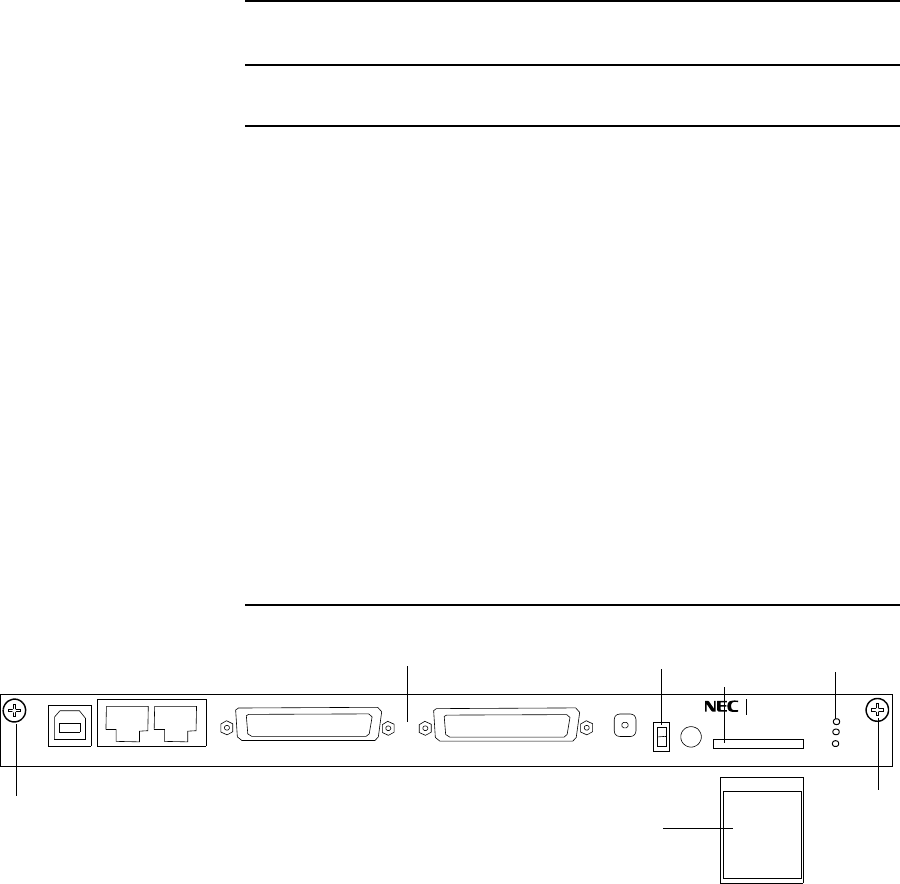
CORRECTIVE MAINTENANCE ROI-S05751
5-44
Chart 5-4 (Cont’d)
Step Procedure
6 When the MAINT LED blinks, insert the MMC into the MMC
slot on the CTRL front, which has equipment configuration data
used in the former CTRL,
7 The download of the equipment configuration data start, the
deployment is performed. When the CTRL has been made
provision, MAINT LED on the IDU turns to light. Check that
the MAINT LED lights and set the PROTECT SW to OFF
position (for lower side). Then, the equipment configuration
data deploys and data is restored.
8 In the Equipment Setup menu and the Provisioning menu,
confirm that the equipment configuration and setting conditions
are the same as before replacement. Check that neither alarm is
indicated in the Alarm Status.
9 The CTRL replacement finishes. Perform the resetup for the
Network Config. since the Network Config. data is not restored.
AUX/ALM
LCT NMS NE SC IN/OUT EOW
PROTECT
CALL MMC
MAINT
MEMORY
IDU
PASOLINK NEO
MAINTE LED
MMC Slot
MPROTECT SW
CTRL
MMC
SCREW
SCREW
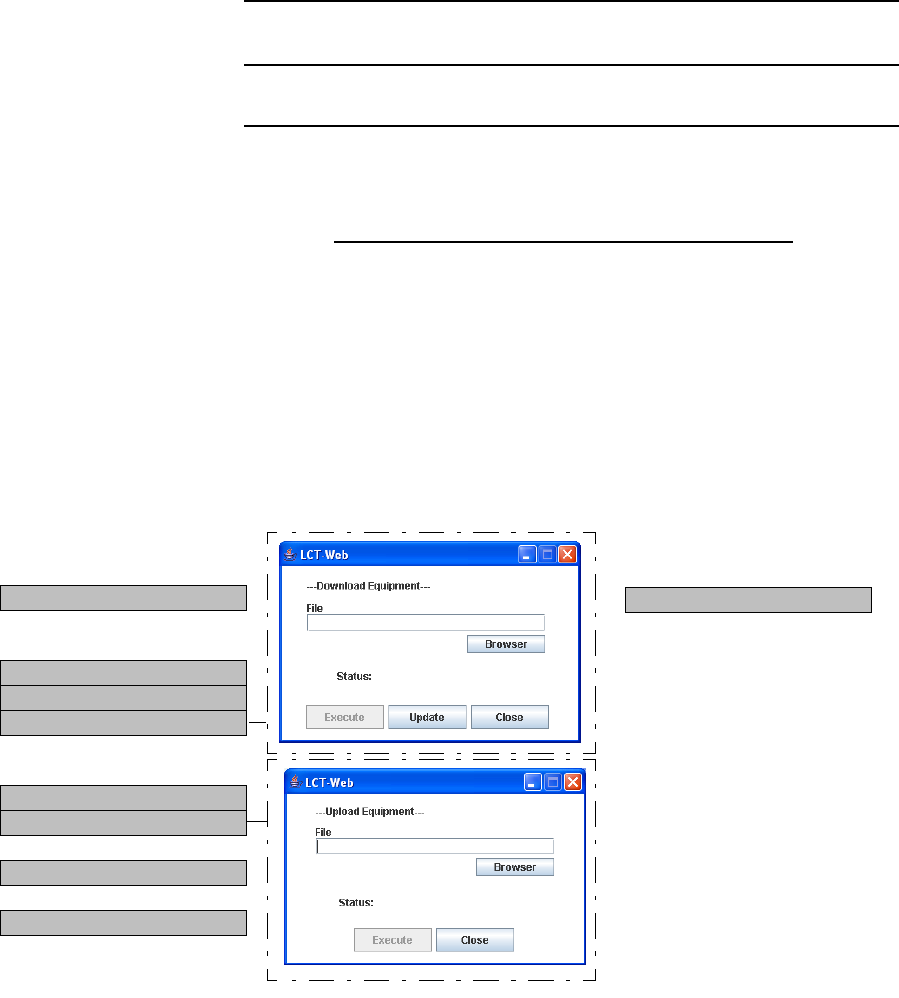
ROI-S05751 CORRECTIVE MAINTENANCE
5-45
Chart 5-4 (Cont’d)
Step Procedure
Note: If the NMS parameters (Network Config.) can not be restored,
then the resetup with the PNMx is required.
The Use of the LCT for the CTRL Replacement
When the LCT is used, the replacement can be performed without the
MMC. (The resetup with the PNMx for the Network Config. is necessary.)
1 Referring to Chart 2-1, set the IDU to Maintenance ON
condition by LCT (Check that the MAINT LED lights.),
2 Set the PROTECT SW on the CTRL front to ON position (for
upper side). Then, equipment configuration data gather up and
the saving of data start,
--- Maintenance2 ---
---Control---
CPU Reset
---Download---
Configuration File
Program File
Equipment Config. File
---Upload---
Configuration File
Equipment Config. File
---Date/Time---
Date/Time Setting
---Password---
Password Setting
---PMON Clear---
PMON Clear
3 Select the Maintenance2 from the Maintenance menu, select the
Equipment Config. File of Upload. Enter the directory of the
file name where the uploaded file will be saved (extension is
.cfg),
4 When the upload to the LCT has completed, MAINT LED
blinks slowly (Check that the MAINT LED blinks slowly when
remove the CTRL.),

CORRECTIVE MAINTENANCE ROI-S05751
5-46
Chart 5-4 (Cont’d)
Step Procedure
5 Remove the cables connected to the CTRL, loosen two fixed
screws and remove the CTRL,
Note: Be careful to avoid catching the module on the cable when
extracting the module. If the module is caught on the live
cables, it may cause a radio link error.
6 Prepare the spare CTRL. Set the PROTECT SW on the spare
CTRL to ON position (for upper side), (The PROTECT SW
setting distinguish the normal start up or protected start up.)
Mount the CTRL into the IDU. Check that the MAINT LED on
the IDU blinks. Tighten two screws and connect cables
removed,
7 To download the equipment configuration data to the LCT,
select Maintenance2 from the Maintenance menu, select the
Equipment Config. File of Download. Enter the directory of the
file name where the uploaded file is saved, click on the
“Execute” button to start the download. When “Complete”
appears in the Progress Status, click on the “Update” button to
perform download.
8 When the CTRL has been provisioned, the MAINT LED on the
IDU turns to light. Check that the MAINT LED lights, set the
PROTECT SW to OFF position (for lower side). Then, the
equipment configuration data deploys and data is restored.
9 In the Equipment Setup menu and the Provisioning menu,
confirm that the equipment configuration and setting conditions
are the same as before replacement. Check that neither alarm is
indicated in the Alarm Status.
10 The CTRL replacement finishes. Perform the resetup for the
Network Config. since the Network Config. data is not restored.
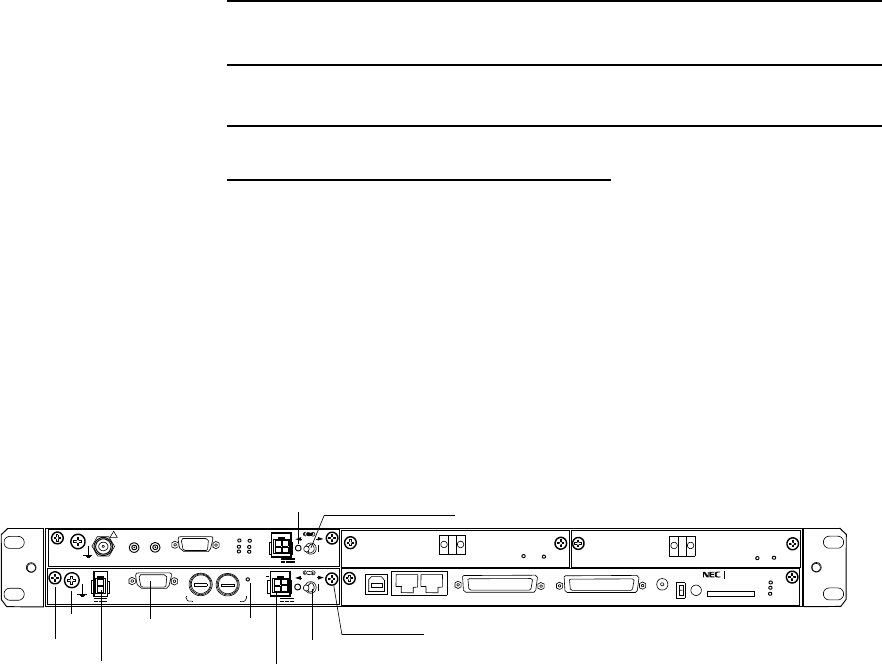
ROI-S05751 CORRECTIVE MAINTENANCE
5-47
Chart 5-4 (Cont’d)
Step Procedure
Replacing the DC-DC CONV (Optional).
When the power is supplied to the SELV of the DC-DC CONV (optional)
but the PWR LED of the DC-DC CONV is not lit though the power switch
is on, before replacing the DC-DC CONV, check the conduction of the
fuse in the DC-DC CONV.
1 Referring to Chart 2-1, set the IDU to maintenance ON
condition by LCT,
2 Set the power switch on the MODEM to Off position,
3 Set the power switch on the DC-DC CONV to Off position,
FG
FG
SELV
!
XIF IN XIF OUT
IF IN/OUT
TX
RX
RESET
XPIC CTRL
XPIC
PWR
ODU
MD/
CBL PWR
PULL
AUX/ALM
NMS NE SC IN/OUT EOW
PROTECT
CALL MMC
MAINT
MEMORY
IDU
NLITE E
LCT
PWR Switch
SELV
PWR LED
−43V/OUT
GScrew
Screw
SELV
PWR PULL
PWR
ALM FUSE (250V/8AH)
−
43V
G
OUT
STD
G
PWR Switch
PWR LED
ALM
ALM
OC-3 IN
OC-3 OUT
ALM
OC-3 IN
OC-3 OUT ONLINE
ONLINE
4 Disconnect cables connected to the DC-DC CONV as following
order,
(1) Disconnect power supply cable from SELV connector,
(2) Disconnect power supply cable from −43/OUT connector,
(3) Disconnect ground cable from ground terminal,
(4) Disconnect ALM cable from ALM terminal,
5 Loosen two screws fixed the DC-DC CONV,
6 Extract the DC-DC CONV from the IDU shelf,
7 Check that the power switch on the spare DC-DC CONV is Off
position
8 Mount the spare DC-DC CONV to the IDU shelf,
9 Tighten two screws to fix the DC-DC CONV,
10 Connect cables to the DC-DC CONV as reversed order in step
4,
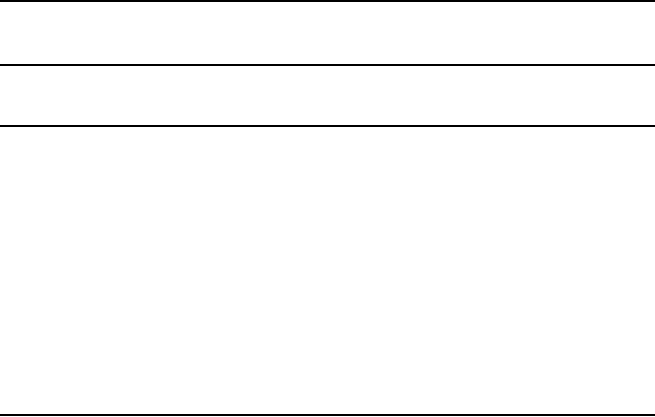
CORRECTIVE MAINTENANCE ROI-S05751
5-48
Chart 5-4 (Cont’d)
Step Procedure
11 Turn on the power switch on the DC-DC CONV,
12 Check that PWR LED on the DC-DC CONV is on,
13 Turn on the power switch on the MODEM,
14 Check that PWR LED on the MODEM is on,
15 Check that ALM LED on the IDU is unlited,
16 Set the IDU to maintenance OFF condition by LCT.

ROI-S05751 CORRECTIVE MAINTENANCE
5-49
Chart 5-4 (Cont’d)
Step Procedure
B. IDU REPLACEMENT
REMOVING
1 Turn off the power switch on the MODEM (both MODEM in
1+1 configuration),
2 Disconnect the IF cable, signal cables and the power cable, etc.
as following order,
(1) Disconnect XPIC CTRL cables from opposite IDU. (XPIC
configuration only.)
(2) Disconnect XIF coaxial cables from opposite IDU. (XPIC
configuration only.)
(3) Disconnect OC-3, LAN, Aux. signal cables from connector.
(4) Disconnect power supply cable from SELV connector.
(5) Disconnect IF cable from IF IN/OUT connector.
(6) Disconnect ground cable from the ground terminal
Note: The adapter for IF cable connector is reused.
3 As shown in Fig. 5-9, loosen four screws and remove the IDU,
MOUNTING
4 Fix the two brackets to desired position on the IDU, if necessary
(see Fig. 5-10),
5 Mount the IDU into the original position of the mounting rack
and tighten the four screws,
6 Reconnect the IF cables, signal cables and the power cable to
the original position as following order,
(1) Connect ground cable to the ground terminal
(2) Connect IF cable (with adapter) to IF IN/OUT connector.
(3) Connect power supply cable to SELV connector.
(4) Connect OC-3, LAN, Aux. signal cables to proper
connector.
(5) Connect XIF coaxial cables to opposite IDU. (XPIC
configuration only.)
(6) Connect XPIC CTRL cables to opposite IDU. (XPIC
configuration only.)
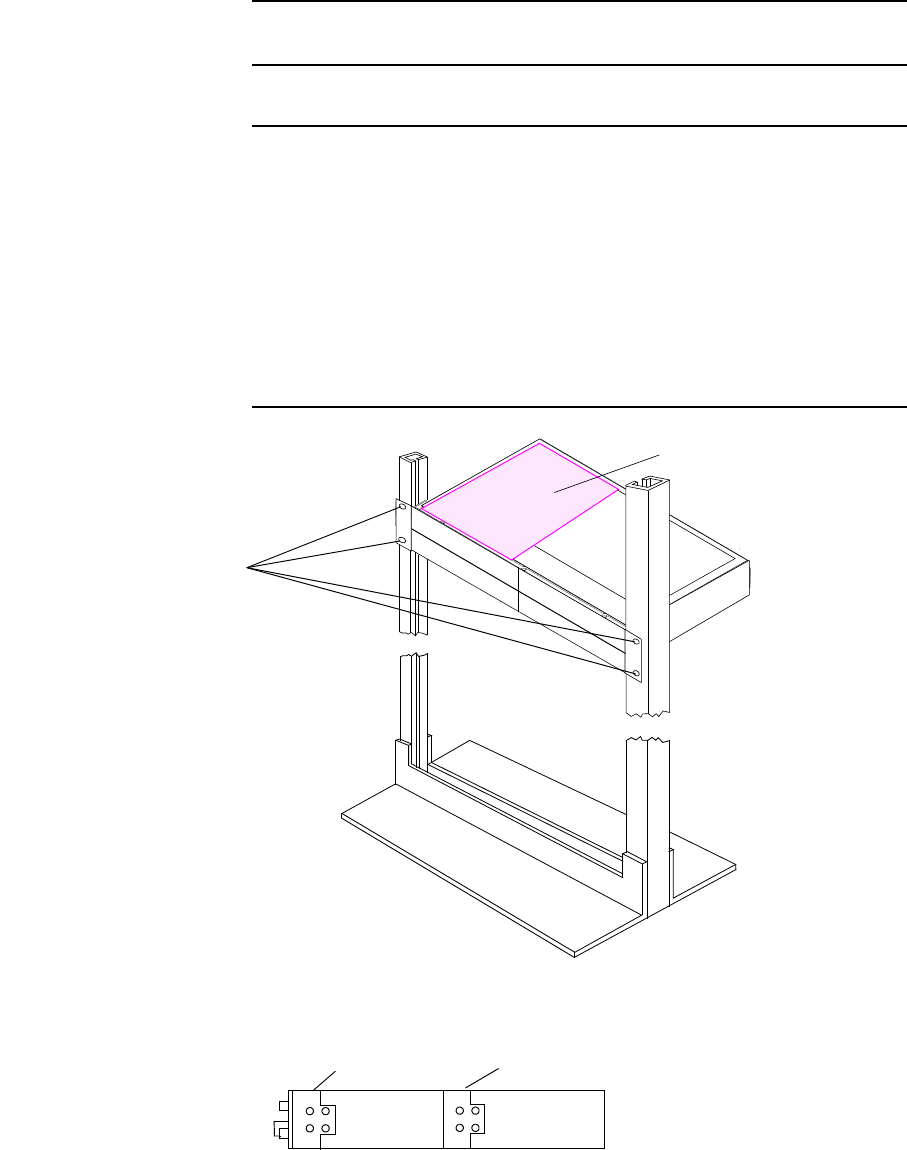
CORRECTIVE MAINTENANCE ROI-S05751
5-50
Chart 5-4 (Cont’d)
Step Procedure
7 Form the wiring, and fix the cables using cable binder to the
mounting rack,
Notes: 1. Do not cross the cables on front of indicators and power
switch used for maintenance.
2. Take suitable radius to wiring the IF cable. (e.g. 10D-
FB: 70 cm)
8 Turn on the power switch on the IDU.
SCREW
Note: Weight 4 kg.
Hot Surface
Caution: The top surface of the IDU above
MODEM is hot in operation.
Fig. 5-9 Demounting and Remounting
FRONT
POSITION
CENTER
POSITION
SIDE VIEW
Fig. 5-10 Bracket Mounting Position

ROI-S05751 CORRECTIVE MAINTENANCE
5-51
5.2.3 Fuse Replacement
When the power is supplied to the SELV but the IDU can not be powered
on with the power switch, check the conduction of fuse in the MODEM.
Chart 5-5 Fuse Replacement
Step Procedure
1 Set the power switch on the MODEM which is not powered to
Off position,
2 Disconnect cables connected to the MODEM as following
order,
(1) Disconnect power supply cable from SELV connector.
(2) Disconnect IF cable from IF IN/OUT connector. The adapter
is reused.
(3) Disconnect ground cable from the ground terminal.
3 Loosen two screws on the MODEM,
4 Extract the MODEM from the IDU shelf,
5 Remove protection cap over the fuse (see Fig. 5-11),
6 Remove the fuse from the fuse holder,
7 Check conduction of the broken fuse using tester,
8 Check conduction of the reserved fuse using tester,
9 Replace the broken fuse with reserved one,
10 Set the replaced fuse to the fuse holder,
11 Cap over the replaced fuse,
12 Mount the MODEM to the IDU shelf,
13 Tighten two screws on the MODEM,
14 Connect cables to the MODEM as reversed order in step 2,
15 Turn on the power switch on the MODEM,
16 Check that power is on.
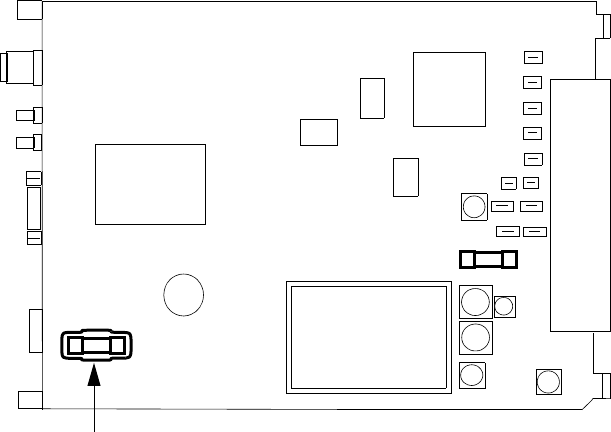
Reserve Fuse (6.3A)
21606.3 Fuse
RKS-F91000-0107
(Front)
Fuse Cap
(MODEM)
RESERVE
CORRECTIVE MAINTENANCE ROI-S05751
5-52
Fig. 5-11 Fuse in the MODEM

ROI-S05751 CORRECTIVE MAINTENANCE
5-53
When the power is supplied to the SELV of the DC-DC CONV (optional)
but the PWR LED of the DC-DC CONV is not lit though the power switch
is on, check the conduction of the fuse in the DC-DC CONV.
Chart 5-6 DC-DC CONV Fuse Replacement
Step Procedure
1 Set the power switch on the DC-DC CONV which is not
powered to Off position
2 Disconnect cables connected to the DC-DC CONV as following
order,
(1) Disconnect power supply cable from SELV connector,
(2) Disconnect power supply cable from −43/OUT connector,
(3) Disconnect ground cable from ground terminal,
(4) Disconnect ALM cable from ALM terminal,
3 Loosen two screws on the DC-DC CONV,
4 Extract the DC-DC CONV from the unit,
5 Put the screwdriver to the groove of the fuse holder and turns
the fuse holder counter clockwise,
6 Remove the fuse from the fuse holder,
7 Check conduction of the broken fuse using tester,
8 Remove the reserved fuse as described in step 5,
9 Check conduction of the reserved fuse using tester,
10 Replace the broken fuse with reserved one,
11 Set the replaced fuse to the fuse holder,
12 Put the screwdriver to the groove of the fuse holder and push it
into the DC-DC CONV,
13 Turn the screwdriver clockwise until the fuse holder is locked
up, (When the fuse holder is locked up, the groove of the fuse
holder is set to horizontal as shown in Fig 5-12.)
14 Check and replace another fuse in the same way as from Step 5
to Step 13,
15 Mount the DC-DC CONV to the unit,
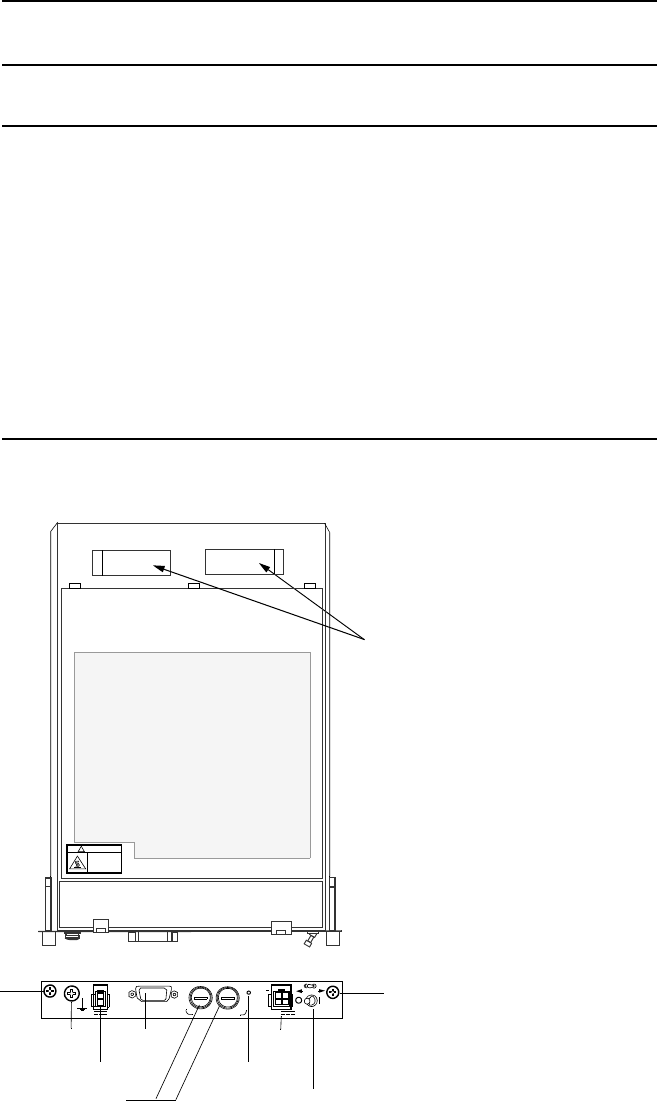
CORRECTIVE MAINTENANCE ROI-S05751
5-54
Chart 5-6 (Cont’d)
Step Procedure
16 Tighten two screws on the DC-DC CONV,
17 Connect cables to the DC-DC CONV as reversed order in step
2,
18 Turn on the power switch on the DC-DC CONV,
19 Check that power is on.
20 Turn on the power switch on the IDU/DC-DC CONV UNIT,
21 Check that power is on.
Reserve Fuse (8A)
GAB250V8 Fuse
CBE-006255-001
(Front)
Fuse Holder
RESERVE RESERVE
CAUTION
HOT SURFACE
Avoid contact.
!
Reserved Fuse
SELV
PWR PULL
PWR
ALM FUSE (250V/8AH)
−
43V
G
OUT
STD
G
PWR Switch
SELV
PWR LED
ALM
−43V/OUT
G
Screw
Screw
(DC-DC CONV)
Fig. 5-12 Fuse in the DC-DC CONV

ROI-S05749-05FE CONTENTS
August, 2007
CL-1
NEC NLite E
6-38 GHz SONET DIGITAL RADIO SYSTEM
Section II OPERATION
CONTENTS
TITLE PAGE
1 GENERAL ••••••••••••••••••••••••••••••••••••••••••••••••••••••••••••••1-1
2 OPERATING EQUIPMENT •••••••••••••••••••••••••••••••••••••••••2-1
2.1 IDU Shelf ••••••••••••••••••••••••••••••••••••••••••••••••••••••••••••2-4
2.2 CTRL •••••••••••••••••••••••••••••••••••••••••••••••••••••••••••••••••2-5
2.3 MODEM •••••••••••••••••••••••••••••••••••••••••••••••••••••••••••• 2-12
2.4 STM-1 INTFC ••••••••••••••••••••••••••••••••••••••••••••••••••••• 2-16
2.5 4P LAN INTFC (Optional) ••••••••••••••••••••••••••••••••••••• 2-18
2.6 GbE INTFC (Optional) •••••••••••••••••••••••••••••••••••••••••• 2-20
2.7 DC-DC CONV (Optional) •••••••••••••••••••••••••••••••••••••• 2-23
2.8 ODU ••••••••••••••••••••••••••••••••••••••••••••••••••••••••••••••••• 2-25
3 SYSTEM SETUP •••••••••••••••••••••••••••••••••••••••••••••••••••••• 3-1
3.1 Equipment Setup •••••••••••••••••••••••••••••••••••••••••••••••••3-1
3.2 Provisioning Setup ••••••••••••••••••••••••••••••••••••••••••••••• 3-4
3.3 Events and Performance •••••••••••••••••••••••••••••••••••••••3-7
3.4 Control ••••••••••••••••••••••••••••••••••••••••••••••••••••••••••••• 3-14
3.5 Setup Description •••••••••••••••••••••••••••••••••••••••••••••• 3-16
3.5.1 Automatic Laser Shutdown Control
(OPT INTFC) (SDH) ••••••••••••••••••••••••••••••••••••••••••••• 3-16
3.5.2 Automatic Protection Switching (APS)
(OPT INTFC Optional APS Configuration) (SDH) ••••••• 3-18
3.5.3 Automatic Transmitter Power Control •••••••••••••••••••• 3-23
3.5.4 Loopback Control •••••••••••••••••••••••••••••••••••••••••••••• 3-27
3.5.5 Link Loss Forwarding Control (LAN) •••••••••••••••••••••• 3-27
3.5.6 MS-AIS Generation (SDH) •••••••••••••••••••••••••••••••••••• 3-28
3.5.7 Cross Polarization Interference Canceller (XPIC
Reset Control •••••••••••••••••••••••••••••••••••••••••••••••••••• 3-30
3.5.8 Network Management (Optional) ••••••••••••••••••••••••••• 3-31
CONTENTS ROI-S05749
CL-2
2 pages
3.5.9 Functionality Classification ••••••••••••••••••••••••••••••••• 3-32
3.6 Protection Switching •••••••••••••••••••••••••••••••••••••••••• 3-33
3.6.1 1 + 1 Twin-path System ••••••••••••••••••••••••••••••••••••••• 3-33
3.6.2 Hot-standby System ••••••••••••••••••••••••••••••••••••••••••• 3-33
3.6.3 Switchover Control ••••••••••••••••••••••••••••••••••••••••••••• 3-34
TITLE PAGE
ROI-S05749-05FE CONTENTS
August, 2007
CL-3

ROI-S05749 GENERAL
1-1
1. GENERAL
This section provides instructions for operation of the 6 to 38 GHz SONET
microwave radio system.
This section describes interface terminals and jacks, controls, indicators,
and test jacks. Use of the LCT is required for local operation, monitoring,
control and setup. For details of system and provisioning setup, refer to
Section IV NLite E LCT Manual.
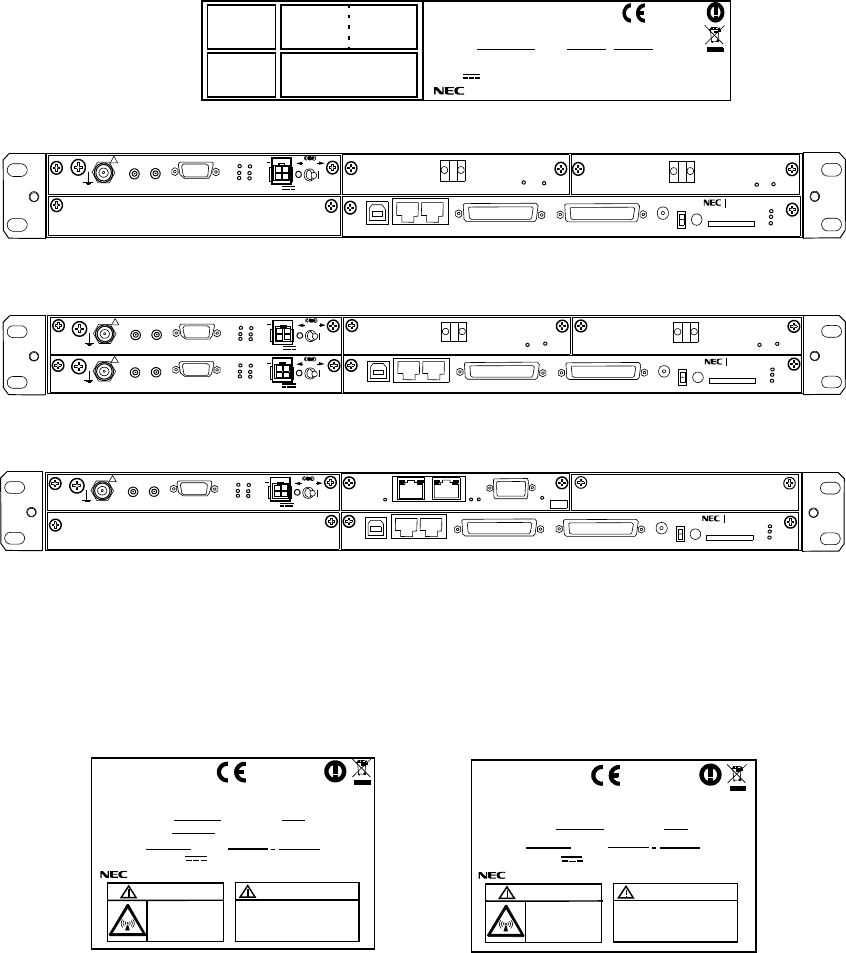
TRP-( )G-1B
0678
NEC NLite E
TRP-( )G-1B
OUTDOOR UNIT (NHG)
SHIFT FREQUENCY
MHz SUB BAND
(NWA-009034)
WEIGHT 3.5kg/ - 48V 0.5A
NEC Corporation TOKYO JAPAN MADE IN JAPAN
CAUTION
Non-ionizing
radiation
0678
-48V INPUT
Power down IDU before
disconnection or
connection of cable.
NEC NLite E
TX
HIGH/LOW
WEIGHT 3.5kg/ - 48V 0.5A
NEC Corporation TOKYO JAPAN MADE IN JAPAN
CAUTION
Non-ionizing
radiation
-48V INPUT
Power down IDU before
disconnection or
connection of cable.
MHz
TX FREQUENCY
OUTDOOR UNIT (NHG)
SHIFT FREQUENCY
MHz SUB BAND
TX
HIGH/LOW
SERIAL No. DATE
SERIAL No. DATE
(NWA-009034)
NEC NLite E
IDU 1+1
IDU 1+0
MDP-150MB-1AA
WEIGHT: 4 kg (WITH OPTION)
SER. No. DATE ,
INDOOR UNIT
−48 V 2.5A (WITH ODU & OPTION)
NEC Corporation
TOKYO JAPAN MADE IN JAPAN
(H2930)
0678
MODEM(1) INTFC (1) INTFC (2)
MODEM(2) CTRL
SELV
!
AUX/ALM
NMS NE SC IN/OUT EOW
PROTECT
CALL MMC
MAINT
MEMORY
IDU
XIF IN XIF OUT
IF IN/OUT
TX
RX
RESET
XPIC CTRL
XPIC
PWR
ODU
MD/
CBL
PULL
PWR
PASOLINK NEO
LCT
Equipped with LAN Interface for Main LAN (SONET)
G
G
ALM
WS IN/OUT
100M PORT 1 PORT 2 100M
WS
(Blank)
M S
.
G
SELV
!
AUX/ALM
NMS NE
ALM
SC IN/OUT EOW
PROTECT
CALL MMC
MAINT
MEMORY
IDU
XIF IN XIF OUT
IF IN/OUT
TX
RX
RESET
XPIC CTRL
XPIC
PWR
ODU
MD/
CBL PWR
NLite E NEO
LCT
OC-3 IN
OC-3 OUT
PULL
ALM
OC-3 IN
OC-3 OUT
(Blank)
ONLINE
ONLINE
G
G
G
SELV
!
AUX/ALM
NMS NE
ALM
SC IN/OUT EOW
PROTECT
CALL MMC
MAINT
MEMORY
IDU
XIF IN XIF OUT
IF IN/OUT
TX
RX
RESET
XPIC CTRL
XPIC
PWR
ODU
MD/
CBL PWR
NLite E NEO
LCT
OC-3 OUT OC-3 IN
PULL
SELV
!
XIF IN XIF OUT
IF IN/OUT
TX
RX
RESET
XPIC CTRL
XPIC
PWR
ODU
MD/
CBL PWR
PULL
ALM
OC-3 OUT OC-3 IN
ONLINE ONLINE
G
G
G
G
GENERAL ROI-S05749
1-2
2 pages

ROI-S05749 OPERATING EQUIPMENT
2-1
2. OPERATING EQUIPMENT
The indicators, switches, interface terminals and jacks for wiring with the
associated equipment are described here.
The IDU component modules listed in Table 2-1 are plugged-in from front
of the IDU shelf as shown in Fig. 2-1.
The component modules of the ODU shown in Fig. 2-2 are listed in Table
2-2.
Note: Use shielded cables which are connected to the RJ-45 connectors
to suppress interference from affecting the signal and to reduce
electromagnetic radiation which may interfere with other signal
cables.
Note:Twist power cables (+)/(−) to suppress inductive interference signals.
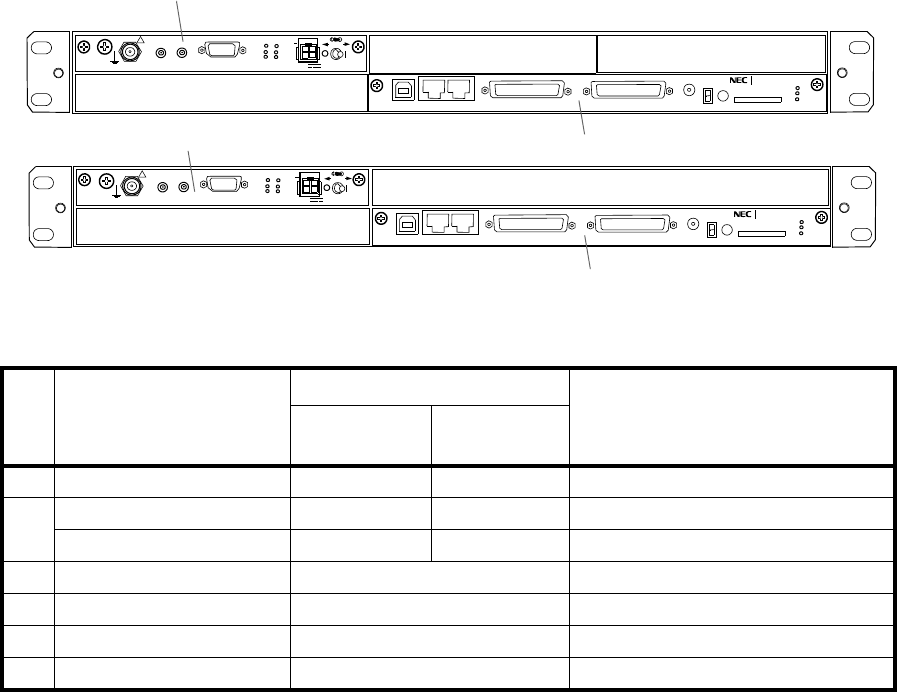
1
2
4, or 5 5*
6
G
1
2
6
3
SELV
!
XIF IN XIF OUT
IF IN/OUT
TX
RX
RESET
XPIC CTRL
XPIC
PWR
ODU
MD/
CBL PWR
PULL
SELV
!
XIF IN XIF OUT
IF IN/OUT
TX
RX
RESET
XPIC CTRL
XPIC
PWR
ODU
MD/
CBL PWR
PULL
AUX/ALM
NMS NE SC IN/OUT EOW
PROTECT
CALL MMC
MAINT
MEMORY
IDU
PASOLINK NEO
LCT
AUX/ALM
NMS NE SC IN/OUT EOW
PROTECT
CALL MMC
MAINT
MEMORY
IDU
PASOLI NK NEO
LCT
G
G
G
G
G
OPERATING EQUIPMENT ROI-S05749
2-2
Table 2-1 IDU COMPOSITION
No. UNIT/MODULE NAME
H2930 MDP-150MB-1AA
REMARKS
Expandable
1 + 0 system 1 + 1 system
1MODEM (X) (X) 32QAM/128QAM *1
2
MODEM −(X) 32QAM/128QAM *1
DC-DC CONV (√)−-20 to -60/+20 to +60 VDC *2
3LAN INTFC (√)4-Port-LAN (for SONET) *3
4GbE INTFC (√)GbE (for SONET)
5OC-3 INTFC (√)OC-3 *3 for APS
6CTRL (X)
Notes: 1. (X) always equipped.
2. (√) optionally equipped.
*1 selectable in setting program.
*2 for expanding power supply range.
*3 for optional APS
Fig. 2-1 IDU Composition
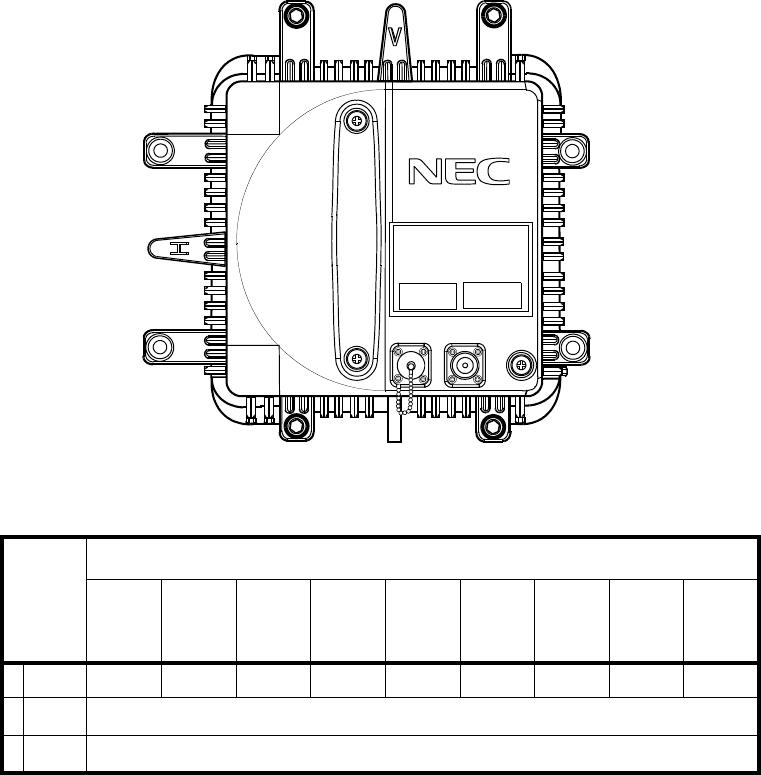
6 - 38 GHz ODU
FG
IFL
MON
RX LEV
NLite E
ROI-S05749 OPERATING EQUIPMENT
2-3
Table 2-2 ODU COMPOSITION
MODULE
Name *
TRP-( )G-1B
6 GHz 7 GHz) 8 GHz 10 GHz 11 GHz 18 GHz 23 GHz 26 GHz 38 GHz
NWA-
009024( )
NWA-
009026( )
NWA-
009028( )
NWA-
009030( )
NWA-
009032( )
NWA-
009038( )
NWA-
009040( )
NWA-
009042( )
NWA-
009048( )
1RF CKT H2202( ) H2203( ) H2204( ) H2225( ) H2205( ) H2229( ) H2230( ) H2231( ) H2234( )
2IF CKT —
3PS —
Note: Component modules are enclosed in the ODU case.
Fig. 2-2 ODU Composition
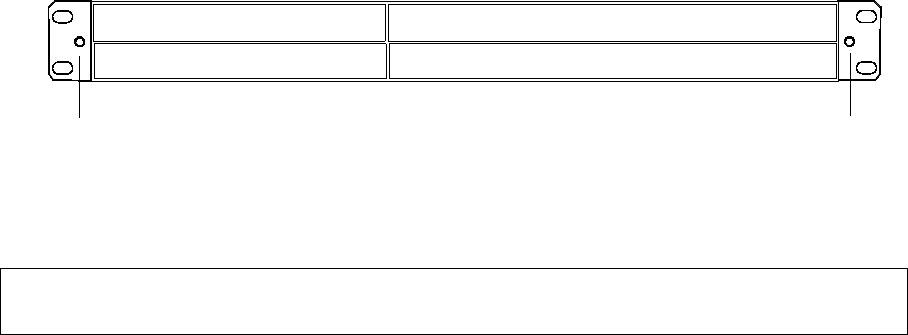
OPERATING EQUIPMENT ROI-S05749
2-4
2.1 IDU Shelf
G
G
GG
Jack (IDU)
GElectrostatic Discharge (ESD) jack used to connect
wrist strap band.
*
Caution*:Engineers for maintenance of the equipment must take the
necessary steps to avoid bit errors or cause damage to the
modules due to electrostatic discharge. Wear a conductive
wrist strap connected to the ground jack (G) on the front of
the IDU to minimize static build-up during maintenance.

ROI-S05749 OPERATING EQUIPMENT
2-5
2.2 CTRL
AUX/ALM
NMS NE SC IN/OUT EOW
PROTECT
CALL MMC
MAINT
MEMORY
IDU
PASOLINK NEO
LCT
MAINT(amber)
MEMORY(amber)
IDU(red)
CALL
PROTECT
SC IN/OUT
AUX/ALM
NE
NMS
LCT
MMC
EOW
The CTRL generates various control signals based upon LCT setup data
and gathered operating status in the IDU and from the ODU, has SC,
EOW, LAN, NE, EXT ALM, HK, Cluster ALM signals interface. By
Connecting a PC, manual control, performance monitoring and system
setup can be performed.
Interface Signals (CTRL)
AUX/ALM (D-Sub
Female 44 pins)
Input/Output Signal
EOW: 1 CH
Frequency: 0.3 to 3.4 kHz (1020 Hz (Test Tone))
Level: −6 dBm
Impedance: 600 ohms
ALM: ALM 6 outputs/6 HK Inputs/ 4 HK Control outputs,
Cluster 4 Inputs/outputs
Output: Relay contact Form-C
Input: Photocoupler
Bz 1,2 IN: Signalling control extension input.
Call 1,2 OUT: Signalling control extension output.
EOW: EOW headphone jack

OPERATING EQUIPMENT ROI-S05749
2-6
SC IN/OUT (D-Sub
Female 44 pins)
Input/Output Signal
NE2: Network Element
Level: RS-485
DSC (RS-232C): 2 CH
Bit rate: 9600 bps
Level: RS-232C
DSC (V.11): 2 CH
Bit rate: 64 Kbps
Level: V. 11
Impedance: 100 ohms
NE (RJ-45): Network Element
Level: 10 Base-T
LCT (USB): Serial interface USB-B type connector with PC
NMS (RJ-45): PNMS
Level: 10 Base-T
Indicators (CTRL)
LED Indication Remarks
MAINT Maintenance mode can be
selected by LCT, PNMT and
PNMS
“The maintenance Mode
“ON” is selected”.
Actively blinks: In progress of program data download.
Inactively blinks:Protect Mode for CTRL replacement
in effect.
MEMORY Memory Card (MMC) status. ON: Enable access to Memory Card
OFF: Disable access to Memory Card
Blinks: Accessing Memory Card
IDU IDU Summary alarm. Check ALM LEDs on each module to find the cause
and/or connect LCT to check the performance condition.
Blinks: CPU or peripheral event occurred.
Interface Signals (CTRL)

Switch (CTRL)
Switch Operating Remarks
CALL Transmits EOW calling signal to sound the
buzzer in the opposite station.
PROTECT Prevent service interruption when the CTRL
module is replaced.
Accessing the Memory Card (MMC)
is required to apply the function.
ROI-S05749 OPERATING EQUIPMENT
2-7
User Interface Pin Assignment (CTRL)
Terminal Description
CTRL
ALM/AUX IN/OUT
(D-sub Female, 44 Pins)
Service channel data input/output
Pins 1 (+) and 16 (–) EOW input 1
Pins 2 (+) and 17 (–) EOW output 1
Pins 3 (+) and 18 (–) EOW input 2
Pins 4 (+) and 19 (–) EOW output 2
Pin 5 Ground
Pins 25 (COM), 40 (NC)
and 11 (NO) ⎯ RL1*1
Maintenance alarm output
Between Between
Pins 25 and 40 Pins 25 and 11
Normal state : Closed Open
Alarm state : Open Closed
Pins 24 (COM), 39 (NC)
and 10 (NO) ⎯ RL2*1
IDU CPU/PS1/PS2 alarm output
Between Between
Pins 24 and 39 Pins 24 and 10
Normal state : Closed Open
Alarm state : Open Closed
Pins 23 (COM), 38 (NC)
and 9 (NO) ⎯ RL3
ODU1/ODU2 alarm output*2
Between Between
Pins 23 and 38 Pins 23 and 9
Normal state : Closed Open
Alarm/Event state : Open Closed

OPERATING EQUIPMENT ROI-S05749
2-8
Pins 22 (COM), 37 (NC)
and 8 (NO) ⎯ RL4
ODU CPU1/ODU CPU2/Cable Open alarm output*2
Between Between
Pins 22 and 37 Pins 22 and 8
Normal state : Closed Open
Alarm/Event state : Open Closed
Pins 21 (COM), 36 (NC)
and 7 (NO) ⎯ RL5
IDU total alarm output*2
Between Between
Pins 21 and 36 Pins 21 and 7
Normal state : Closed Open
Alarm/Event state : Open Closed
Pins 20 (COM), 35 (NC)
and 6 (NO) ⎯ RL6
High BER1/High BER2 alarm output*2
Between Between
Pins 20 and 35 Pins 20 and 6
Normal state : Closed Open
Alarm/Event state : Open Closed
Pins 15 (+) and 14 (−)HK1 alarm input*3
Normal state : Open
Control/Event state : Closed
Pins 13 (+) and 12 (−)HK2 alarm input*3
Normal state : Open
Control/Event state : Closed
Pins 29 (+) and 28 (−)HK3/Cluster4 alarm input*3
Normal state : Open
Control/Event state : Closed
Pins 27 (+) and 26 (−)HK4/Cluster3 alarm input*3
Normal state : Open
Control/Event state : Closed
Pins 44 (+) and 43 (−)HK5/Cluster2 alarm input*3
Normal state : Open
Control/Event state : Closed
Pins 42 (+) and 41 (−)HK6/Cluster1 alarm input*3
Normal state : Open
Control/Event state : Closed
Pin 30 Buzzer input 1
Pin 31 Call output 1
Pin 32 Buzzer input 2
Pin 33 Call output 2
User Interface Pin Assignment (CTRL)
Terminal Description

ROI-S05749 OPERATING EQUIPMENT
2-9
CTRL
SC IN/OUT
(D-sub Female, 44 Pins)
NE2/DSC Service channel data input/output
Pins 1 (+) and 2 (–) NE2 TXD
Pin 3 Ground
Pins 4 (+) and 5 (–) V.11-1 TX data input
Pins 6 (+) and 7 (–) V.11-1 RX data output
Pins 8 (+) and 9 (–) V.11-2 TX data input
Pins 10 (+) and 11 (–) V.11-2 RX data output
Pins 12 and 13 (G) RS-232C-1 data input
Pins 14 and 15 (G) RS-232C-2 data input
Pin 16 NE2 RXD TERM
Pins 17, 18 Ground
Pins 19 (+) and 20 (–) V.11-1 TX clock input (co-dir.) or output (contra-dir.) *4
Pins 21 (+) and 22 (–) V.11-1 RX clock output
Pins 23 (+) and 24 (–) V.11-2 TX clock input (co-dir.) or output (contra-dir.) 4*
Pins 25 (+) and 26 (–) V.11-2 RX clock output
Pins 27, 28, 29 Ground
Pins 30 (+) and 31 (–) NE2 RXD
Pin 32 Ground
Pins 33 (+) and 34 (–) V.11-1 TX frame pulse input (co-dir.) or output (contra-dir.) *4
Pins 35 (+) and 36 (–) V.11-1 RX frame pulse output
Pins 37 (+) and 38 (–) V.11-2 TX frame pulse input (co-dir.) or output (contra-dir.) *4
Pins 39 (+) and 40 (–) V.11-2 RX frame pulse output
Pins 41 and 42 (G) RS-232C-1 data output
Pins 43 and 44 (G) RS-232C-2 data output
User Interface Pin Assignment (CTRL)
Terminal Description

OPERATING EQUIPMENT ROI-S05749
2-10
Notes: *1: RL1 (Maintenance) and RL2 (IDU CPU/PS1/PS2
ALM OUTUT) are fixed and can not be changed to
other items. The relay contact is rated at 0.2 A.
*2: These alarm items are assigned at the factory (default
setting) and can be changed by the LCT as shown in
Table 2-3 in Section 1 (Alarms may be selectively
assigned to RL3 to RL6).
*3: Photocoupler interface; resistance of open input
terminal is more than 200 kilo ohms. Closed input
terminal is less than 50 ohms.
*4: V11 interface for the TX clock and frame pulse input/
output depend on co-/contra-directional mode setting
in the LCT provisioning menu.
LCT
(USB connector type B)
Local craft terminal (LCT) data input/output
Pin 1 Vbus
Pins 2 (–) and 3 (+) D
Pin 4 Ground
NMS (RJ-45) PNMS data (10Base-T) input/output
Pins 1 (+) and 2 (–) NMS TXD
Pins 3 (+) and 6 (–) NMS RXD
Pins 4, 5, 7 and 8 Not Connected
NE (RJ-45) NE data (10Base-T) input/output
Pins 1 (+) and 2 (–) NMS TXD
Pins 3 (+) and 6 (–) NMS RXD
Pins 4, 5, 7 and 8 Not Connected
User Interface Pin Assignment (CTRL)
Terminal Description
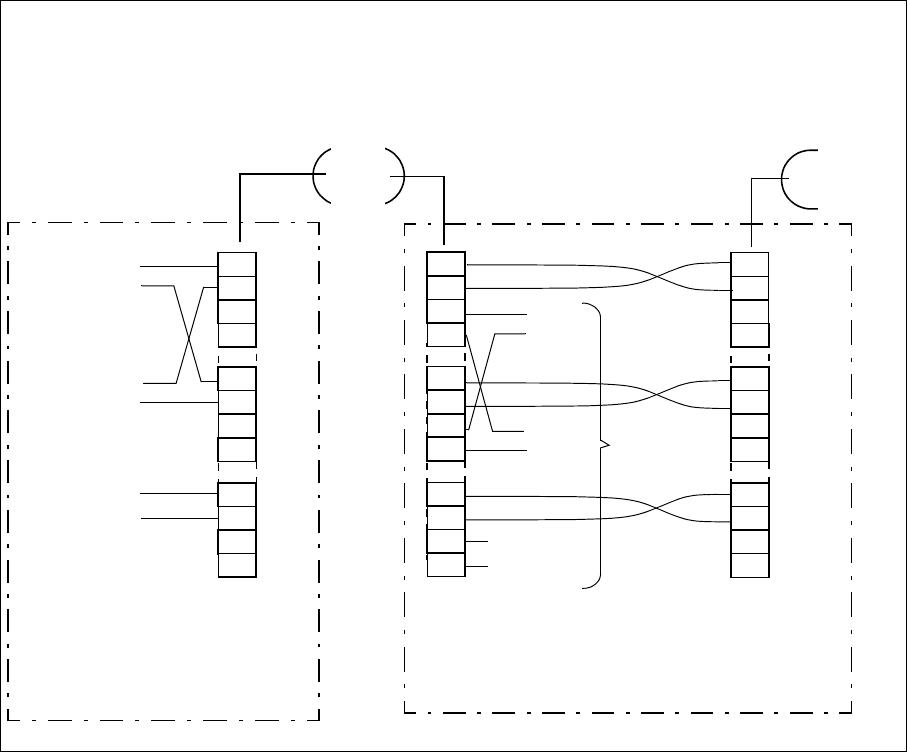
EOW 4W R
IDU Dir. A
ALM/AUX IN/OUT
(D-Sub, 44 Pins)
EOW Connection
When EOW signal is connected between two IDUs, perform wiring as follows.
1
16
2
3
4
17
18
19
30
31
32
33
IDU Dir. C
ALM/AUX IN/OUT
(D-Sub, 44 Pins)
IDU Dir. B
ALM/AUX IN/OUT
(D-Sub, 44 Pins)
Back -to- Back Station B
Terminal Station A
1
16
2
3
4
17
18
19
30
31
32
33
1
16
2
3
4
17
18
19
30
31
32
33
EOW 4W S
Buzzer IN
Call OUT
EOW
Extension
EOW
4W S
EOW
4W R
Buzzer IN
Call OUT
ROI-S05749 OPERATING EQUIPMENT
2-11
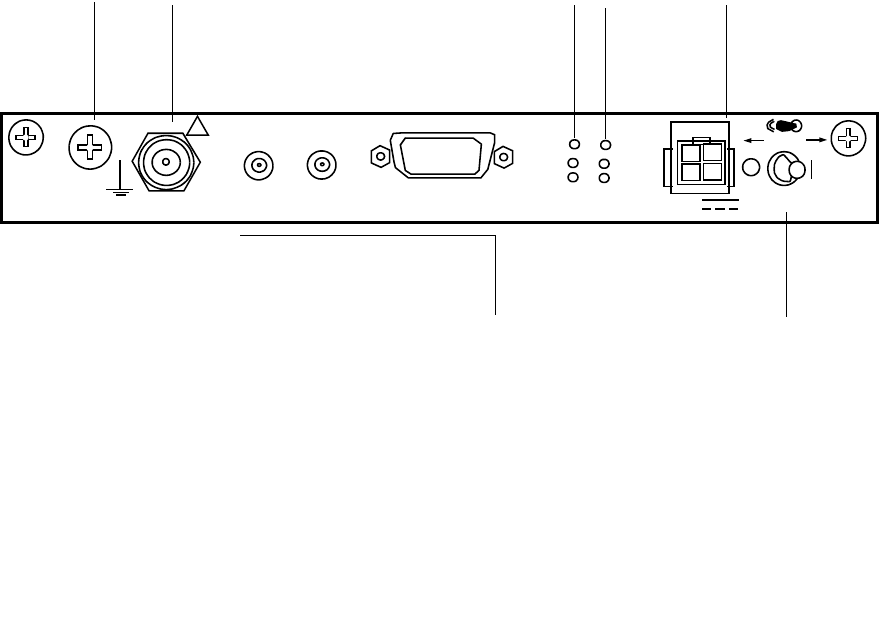
OPERATING EQUIPMENT ROI-S05749
2-12
2.3 MODEM
SELV
!
XIF IN XIF OUT
IF IN/OUT
TX
RX
RESET
XPIC CTRL
XPIC
PWR
ODU
MD/
CBL
PULL
PWR
SELV
PWR
PWR(green)
ODU(red)
MD/CBL(red)
TX (green)
RX (green)
XPIC RESET(amber)
XPIC CTRL
XIF OUT
XIF IN
IF IN/OUT
G
Caution: Do not apply to the equipment a voltage that varies sharply. The equipment
operation may be impaired.
Caution: Do not remove/connect the IF cable with the IDU power ON, Turn the IDU
power OFF before connecting/disconnecting the IF cable, or equipment may
cause damaged.
Caution: Do not insert/extract the MODEM with the power ON, turn the IDU power
OFF and remove all cables connected to the MODEM before insert/extract the
MODEM, or MODEM may be damaged.
Caution: The top surface of the IDU shelf above MODEM is hot in operation.
The MODEM provides the 32QAM/128QAM Modulation/Demodulation
for, 10/100Base T(x)/1000 Base T (LAN) or OC-3 (SONET) data
transmission and following main functions.
- Forward Error Correction using RS/Interleave
- BER (High BER/Low BER) detection/indication/release for internal
and external
- Reducing ODU output signal distortion using BB Linearizer
- Equalization using Transversal Equalizer
- XPIC ODU synthesizer synchronization control
- Interfered signal from opposite polarization cancellation (XPIC)
- IDU/ODU power supply
- System power on/off

ROI-S05749 OPERATING EQUIPMENT
2-13
Interface Signals (MODEM)
IF IN/OUT (TNC Female)
TX Frequency: 340 MHz
RX Frequency: 140 MHz
Power supply: −48 V
Impedance: 50 ohms
Connecting IF Cable length:
5D-FB: less than 150 m
8D-FB: less than 300 m
10D-FB: less than 350 m
G (Screw): Ground terminal
(5 mm square cable (more than 2.5 mm diameter
cable) (AWG#10) is recommended to apply for the
frame ground. The proper press fix terminal tool
shall be used.)
SELV (Molex M5569-04A1,
4 pins) (DC IN)
Input Voltage: −48 V DC (negative), + (positive, ground)
XIF IN/XIF OUT
(Receptacle IEC 169-13 (1.0/
2.3))
Only used for XPIC system between two IDUs
XIF IN: IF signal of opposite polarization input.
(connect to XIF OUT of the other MODEM)
XIF OUT: IF signal for opposite polarization output.
(connect to XIF IN of the other MODEM)
Frequency: 140 MHz
Impedance: 75 ohms
XPIC CTRL
(D-Sub 15 pins, Serial Port)
Only used for XPIC system between two IDUs
(connect to XPIC CTRL of the other MODEM)
Automatic/Remote XPIC reset control signal interface between mutual MODEM.

Indicators (MODEM)
LED Indication Remarks
PWR The PWR switch of the MODEM is turned
on.
DC power is supplied to the
ODU also.
ODU
Transmit RF power of the ODU decreased
approx. −3 dB from preadjusted ATPC
minimum (MIN) level in provisioning.
Check Metering using LCT for
local and/or opposite site in
Maintenance menu
Receiver input level of the ODU falls below
squelch level.
APC loop of local oscillator in ODU is
unlocked.
IF signal from the MODEM to ODU is lost.
Blinks when IF cable is open circuit.
Connected ODU is not matched with
inventory.
MD/CBL Blinks when IF cable is short circuit.
TX (only 1+1) Selected status of ODU TX When TX mute control: LED
Off
RX (only 1+1) Selected status of MODEM RX output signal When RX SWO switched to
opposite: LED Off
XPIC RESET XPIC function is OFF condition Only XPIC configuration.
Propagation condition
deteriorated or XPIC is reset
from LCT control.
Switches (MODEM)
Switch Operating Remarks
PWR IDU and ODU power On/Off switch. Refer to Start-up and Shut-down the
Equipment in Maintenance Section
OPERATING EQUIPMENT ROI-S05749
2-14

User Interface Pin Assignment (MODEM)
Terminal Description
SELV
SELV (DC IN)
(Molex M5569-04A1 Connector,
4 Pins)
−48 V DC power input
Note: Only −48 V (−40.5 to −57 V) is available.
Pins 1 and 3 Ground
Pins 2 and 4 −48 V
IF IN/OUT
TNC Jack (Female) * IF signal IN/OUT and PS OUT to the ODU
XPIC CTRL
(D-Sub Female, 15 pins) Used for interconnection between IDUs in XPIC
configuration.
Pins 1 (+) and 6 (–) XPIC SV TXD
Pins 2 (+) and 7 (–) XPIC SV RXD
Pin 3 Ground
Pins 4 (+) and 9 (–) XPIC SEL IN
Pins 5 (+) and 10 (–) XPIC SEL OUT
Pins 8 (+) and 12 (–) XPIC RESET IN
Pin 11 Ground
Pins 13 (–) and 14 (+) XPIC RESET OUT
Pin 15 Ground
ROI-S05749 OPERATING EQUIPMENT
2-15
Note: * It is recommended that TNC (Male) L-angle connector for
the 8D-FB IF cable is used to connect it to the IDU. When
the N (Male) straight connector is attached to the 5D-FB or
10D-FB IF cable, use of the TNC (Male) - N (Female) (NJ-
TNCP-LA) L-angle adapter is needed.
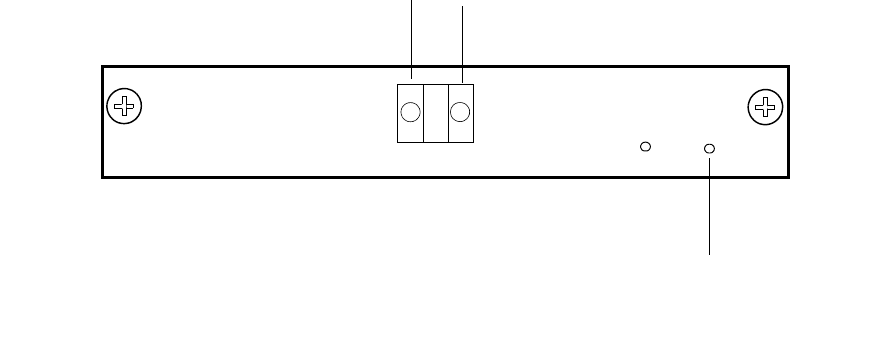
OPERATING EQUIPMENT ROI-S05749
2-16
2.4 OC-3 OPTICAL INTFC
ALM
STM-1 IN
STM-1 OUT
ALM (red)
ONLINE(green)
STM-1 IN
STM-1 OUT
ONLINE
STM-1 (OPT) INTFC
Caution: Do not insert/extract the OC-3 INTFC with the power ON. Turn OFF the PWR switch
on the MODEM and remove all cables connected to the OC-3 INTFC before inserting/
extracting theOC-3 INTFC, or that INTFC may be damaged.
The OC-3 INTFC provides an optical signal interface only. The module
performs the following functions:
- Coded Mark Inversion (CMI) to Non Return to Zero (NRZ)
conversion
- Optical to Electrical conversion
- RSOH termination
- Stuffing control
- Hitless switching (for 1+1 configuration)
- Performance monitoring (conforms to G.826/G.828)
- Automatic Laser Shut Down (ALS)
- Near End/Far End loopback

Interface Signals (OC-3 INTFC)
OC-3 IN/OUT
LC
Optical OC-3 Input/Output, G.957
Optical
Type: G. 9 5 7
Bit Rate: 155.520 Mbps
Level: L-1.1: 0 to −8 dBm (TX)/−10 to −34 dBm (RX)
S-1.1: −8 to −15 dBm (TX)/−8 to −28 dBm (RX)
Code: NRZ
Wavelength:1310 nm
Indicators (OC-3 INTFC)
LED Indication Remarks
ALM
LOSS of OC-3 from MUX is detected. Check MUX and wiring.
Frame synchronization of input OC-3 signal
from MUX is lost.
Check MUX and wiring.
BER (E-BER, DMR or MUX) is worse than
preset value (10-3 to 10-5, selectable). Check RSL, Interference and TX
power at opposite site when BER
ALM occurs.
BER (SD, DMR or MUX) is worse than preset
value (10-5 to 10-9, selectable).
Frame synchronization of input OC-3 signal
from radio is lost.
Check OC-3 transmission at the
opposite site, ODU or MODEM in
local.
Mounting module is not matched with
inventory.
Change LCT setting or other
( )INTFC module.
ONLINE Online status of Working/Standby in APS: ON
Offline status of Working/Standby in APS: OFF
Online status of Working w/o APS: ON
ROI-S05749 OPERATING EQUIPMENT
2-17
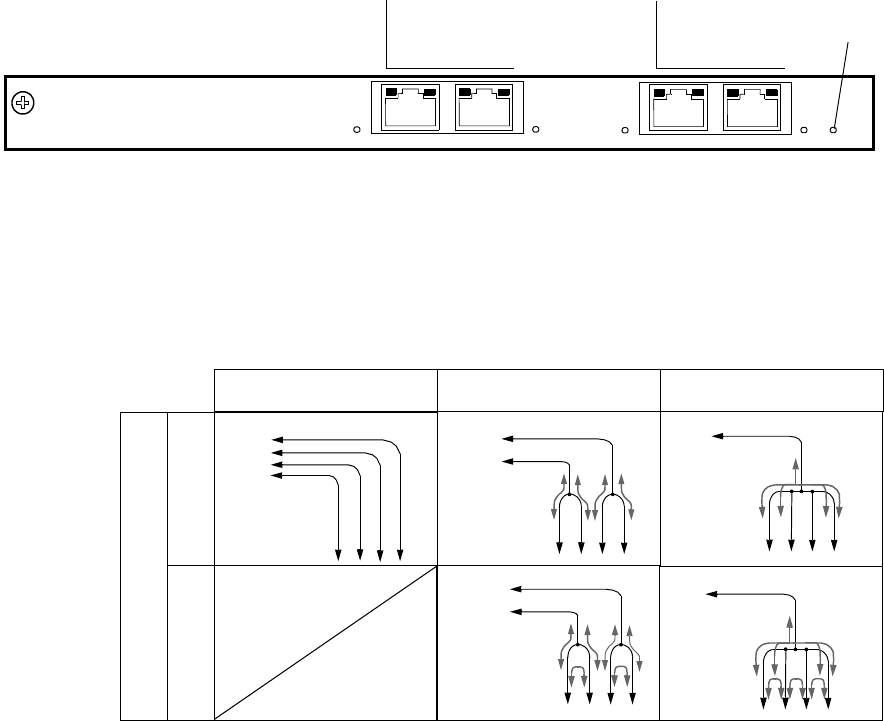
OPERATING EQUIPMENT ROI-S05749
2-18
2.5 4P LAN INTFC
4P LAN
4P LAN INTFC
PORT1
PORT2
100M PORT 3 PORT4 100M
ALM
100M PORT 1 PORT 2 100M
PORT3
PORT4
ALM
LED(red)
The 4P LAN INTFC (optional) is installed into the Main-INTFC slot
(Slot1) in the system configuration and it provides 4 Port LAN Fast
Ethernet interfaces. The LAN interface is used 4 Port shared (P1-P4)
mode, 2 Port (P1-P2/P3-P4) shared mode or separated (P1/P2/P3/P4)
mode.
Separated P1-P4 Shared
P1-P2 Shared
P3-P4 Shared
Disabled
Enabled
Switching
P1 P2 P3 P4
(1) (2) (3)
(4) (5)
Dir-A
P1 P2 P3 P4
Dir-A
Dir-A Dir-A
P1 P2 P3 P4
P1 P2 P3 P4
P1 P2 P3 P4
Dir-A

User Interface Signals (4P LAN INTFC)
LAN PORT1 to
PORT4 (RJ-45)
LAN interface Port 1, Port 2, Port 3 and Port 4.
Selectable 2 Mbps to 100 Mbps CH is assigned for LAN.
Input/Output Signal: 10/100Base-T(x) Auto-sensing or fixed
Flow control: Full duplex or Half duplex
Forwarding mode: Store-and-Forwarding
ROI-S05749 OPERATING EQUIPMENT
2-19
Indicators (4P LAN INTFC)
LED Indication Remarks
100M LAN signal is in 100BASE-TX mode.
LINK LAN and associated equipment are linked
and flashing under the exchanging the
packet.
COLLISION/
DUPLEX
Input/Output LAN signal is in Full
Duplex mode. Flashing when a collision
condition occurs.
ALM
The module is extracted. Mount the module.
Mounting module is not matched with
inventory.
Change LCT setting or other ( )INTFC
module.
LAN link failure occurs. Check LAN cable connection.
Module failure occurs. Replace the module with a spare.
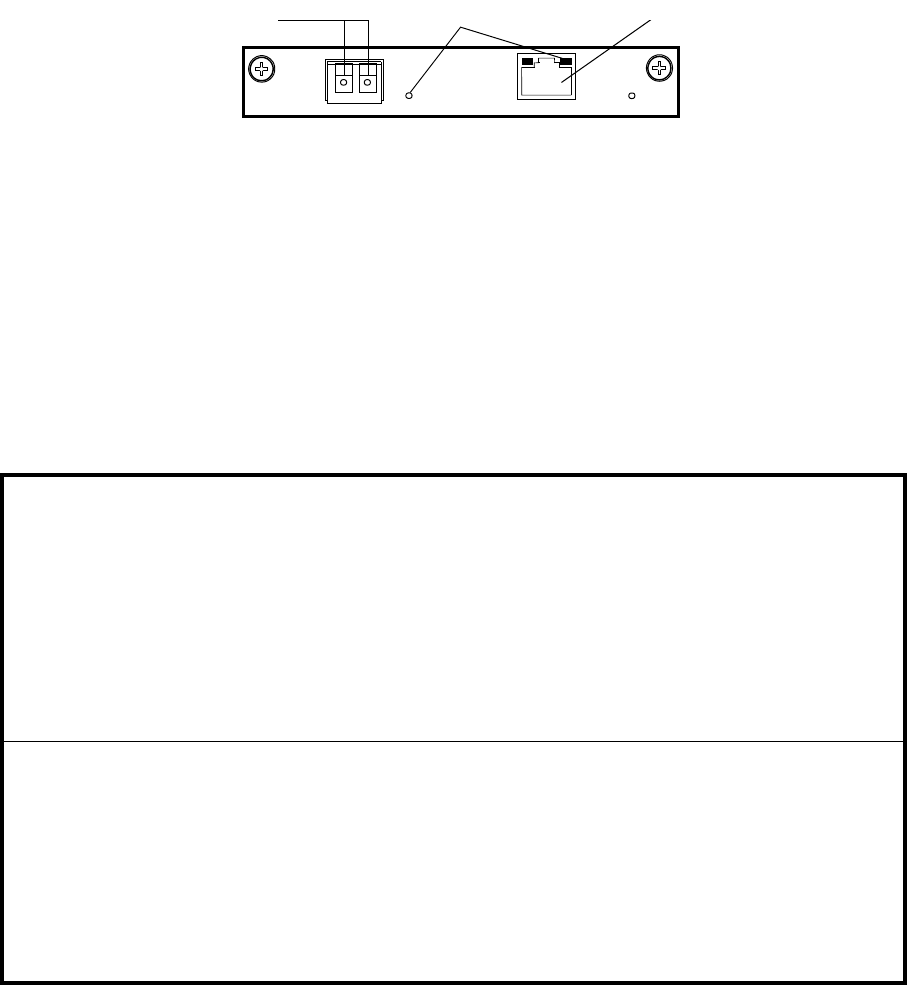
OPERATING EQUIPMENT ROI-S05749
2-20
2.6 GbE INTFC
ALM
OUT
1000BASE-SX
PORT
IN
1000BASE-SX 1000BASE-T
INDICATOR
The GbE INTFC (optional) provides 1000BASE-SX/1000BASE-T
interface. The GbE INTFC is installed into the Main-INTFC slot (Slot1)
instead of the OC-3 INTFC in the SONET (128 QAM) system
configuration. The signal is connected either SFP (for 1000BASE-SX) or
RJ-45 (for 1000MASE-T).
These bytes (E1/F1/DCCr) are available between radio links. The RMON
for LINE side is available but DMR side is unavailable. The maximum
passed packet size is 9600 bytes.
The GbE INTFC ia applicable together with the LAN INTFC.
User Interface Signals (GbE INTFC)
1000BASE-SX: Gigabit Ether signal, Optical Interface
1000BASE-SX IN:
1000BASE-SX OUT:
(SFP Optical Interface
Connector)
Ether signal Input
Ether signal Output
Speed & Duplex: 1000 Mbits Full Duplex/Auto Negotiation fixed
Flow control: Flow control ON or OFF selectable
Link Loss
Forwarding:
Disabled/Enabled selectable
1000BASE-T: Gigabit Ether signal, Electrical Interface
1000BASE-T Port:
(RJ-45 Interface
Connector)
Ether signal Input/Output
Speed & Duplex: 1000 Mbits Full Duplex/Auto Negotiation fixed
Flow control: Flow control ON or OFF selectable
Link Loss
Forwarding:
Disabled/Enabled selectable

User Interface Pin Assignment (GbE INTFC)
Terminal Description
1000BASE-SX
(SFP Fiber connector)
Multimode Fiber/LC Connector
IN (Right side) 1000BASE-SX Input
OUT (Left side) 1000BASE-SX Output
1000BASE-T
(RJ-45, 8 pins)
1000BASE-T Input/Output
(MDI/MDI-X)
Pin 1 DATA-A+/ DATA-B+
Pin 2 DATA-A−/ DATA-B−
Pin 3 DATA-B+/ DATA-A+
Pin 4 DATA-C+/ DATA-D+
Pin 5 DATA-C−/ DATA-D−
Pin 6 DATA-B−/ DATA-A+
Pin 7 DATA-D+/ DATA-C+
Pin 8 DATA-D−/ DATA-C−
Note: Cable connector: CAT5e/RJ-45
ROI-S05749 OPERATING EQUIPMENT
2-21

Indicators (GbE INTFC)
LED Indication Remarks
Indicator Indicates which Port is applied to the signal interface.
When the indicator is flashing slowly, the
input signal is off in the corresponding
interface port which is set to be used.
When the indicator is flashing fast, the
input/output signal is on in the
corresponding interface port which is set
to be used.
When the indicator is lit steady, the signal
is linked in the corresponding interface
port which is set to be used.
When the indicator is unlit, the
corresponding interface which port is set
to no use.
ALM
The module is extracted. Mount the module.
Mounting module is not matched with
inventory.
Change LCT setting or other ( )INTFC
module.
Module failure occurs. Replace the module with a spare.
LOS from DMR is detected.
Check IDU/ODU and radio link.
LOF from DMR is detected.
Excessive-BER alarm condition from
DMR occurs.
SD from DMR is detected.
GbE output signal for fiber cable is
interrupted.
Replace the module with a spare. (SFP
mode only)
LAN link failure occurs. Check LAN cable connection.
OPERATING EQUIPMENT ROI-S05749
2-22

ROI-S05749 OPERATING EQUIPMENT
2-23
2.7 DC-DC CONV
SELV
PWR PULL
PWR
ALM FUSE (250V/8AH)
−
43V
G
OUT
STD
+
PWR LED(green)
FUSE (250V/8AH)
DC-DC CONV
Caution: Do not apply to the equipment a voltage that varies sharply. The equipment
operation may be impaired.
Caution: Do not remove/connect the power supply cable with the PWR switch ON, Turn the
PWR switch OFF before connecting/disconnecting the power supply cable IN or
OUT, if not, module may be damaged.
PWR
SELV
ALM
−
43V OUT
G
Note: If the PWR LED is not lit though the PWR switch has set to ON, set the PWR switch to
OFF, remove two fuses from the module and check the conduction of them.
The DC-DC CONV (optional) converts 20 to 60 V or −20 to −60 V DC
input to −43 V stable DC voltage. The module applies when the Nlite E +
ODU is connected to the IDU.
Interface Signals (DC-DC CONV)
SELV
(Molex M5569-04A1, 4 pins) (DC IN)
Input Voltage: −20 to −60 V/+20 to +60 V DC
−43V OUT
(Molex M5569-02A1,
2 pins) (DC OUT)
Output: −43 V/1.6A
G (Screw): Ground terminal
(5 mm square cable (more than 2.5 mm diameter cable)
(AWG#10) is recommended to apply for the frame
ground. The proper press fix terminal tool shall be
used.)
ALM: Power supply ALM signal output

Indicators (DC-DC CONV)
LED Indication Remarks
PWR The PWR switch of the DC-DC CONV is
turned on.
Switches (DC-DC CONV)
Switch Operating Remarks
PWR IDU and ODU power on/off switch. Refer to Start-up and Shut-down the
Equipment in Maintenance Section
User Interface Pin Assignment (DC-DC CONV)
Terminal Description
SELV
SELV (DC IN)
(Molex M5569-04A1 Connector,
4 Pins)
−20 to −60/20 to 60 V DC power input
Pins 1 and 3 0 V /(or +20 to +60 V)
Pins 2 and 4 −20 to −60 V/(or 0 V)
−43V OUT
(Molex M5569-02A1,
2 pins) (DC OUT)
−43 V DC power output (connects to the SELV connector of
the MODEM module using accessory cable)
Pin 1 Ground
Pin 2 −43 V
ALM Power supply ALM signal output
(D-Sub Female, 9 pins)
Pins 6 (COM), 1 (NC) and
2 (NO)
PS and input voltage alarm output
Between Between
Pins 1 and 6 Pins 6 and 2
Normal state : Closed Open
Alarm state : Open Closed
Pin 9 Ground
Pins3,4,5,7,8 No connected
OPERATING EQUIPMENT ROI-S05749
2-24
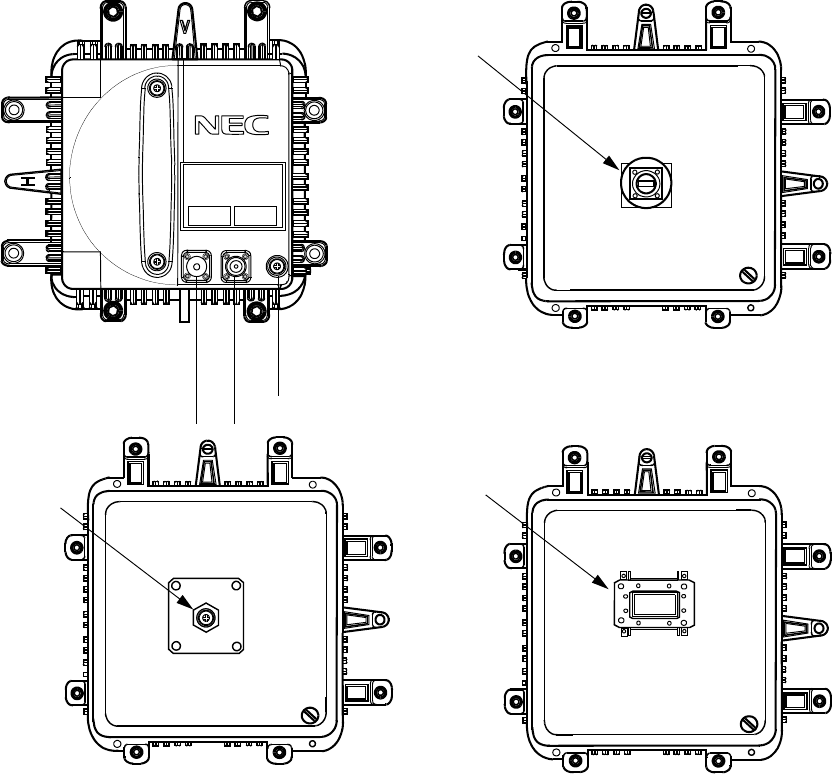
ROI-S05749 OPERATING EQUIPMENT
2-25
2.8 ODU
FG
IFL
MON
RX LEV
IFL (IF IN/ OUT)
RX LEV MON
FG (Frame Ground) Antenna Direct Mounting Type
RF IN/OUT
(REAR VIEW)
RF IN/OUT
(REAR VIEW)
(FRONT VIEW)
Coaxial Cable Type (6/7/8 GHz)
(REAR VIEW)
RF IN/OUT
WG Type (6/7/8 GHz)
NLite E
The ODU receives 340 MHz IF signal from the IDU and converts it to an
RF signal using a local signal generated by a synthesized local oscillator.
This RF signal is then sent to the antenna through the BPF which limits the
RF transmit signal dispersion. The TX output level is controlled to the
specified from the IDU corresponded to the QPSK 32QAM or 128QAM
modulation.
The RF signal received from the antenna is amplified to the required level.
Afterward the signal is converted into the 140 MHz IF signal by mixing
with a local signal generated by a synthesized local oscillator. Then the
140 MHz IF signal is sent to the IDU through the IF cable.

OPERATING EQUIPMENT ROI-S05749
2-26
Interface Signals (ODU)
IFL (N Female)
TX Frequency 340 MHz
RX Frequency: 140 MHz
Power supply: −48 V
Impedance: 50 ohms
Connecting IF Cable length:
5D-FB: less than 150 m
8D-FB: less than 300 m
10D-FB: less than 350 m
FG (Screw) Frame ground, connecting near by ground point.
RF IN/OUT RF signal interface.
- N female connector for the 6/7/8 GHz ODU with coaxial
cable connection.
- NEC proprietary flange for the 10 to 38 GHz ODU with
antenna mounting (direct/OMT/HYB COMB/TX ATT).
- Waveguide connection flange;
6 GHz: PDR70
7/8 GHz: PDR84
10/11 GHz: PDR100
18/23 GHz: PBR220
38 GHz: PBR320
Monitoring Terminal (ODU)
Terminal Operating Remarks
RX LEV MON: Monitoring RX LEV in AGC voltage
using the digital voltmeter or PASOLINK
MONITOR unit * for antenna
orientation.
Use LCT to check the RX LEV in
Maintenance.
Note*:In order to measure exact performance of AGC V at the
RX LEV MON, it is mandatory required to set Antenna
Alignment Mode to ON as the AGC voltage indication is
not guaranteed outside Antenna Alignment Mode.
It is necessary to set to Antenna Alignment Mode every
time monitor the RX level with the NLite E MONITOR
unit.

ROI-S05749 SYSTEM SETUP
3-1
3. SYSTEM SETUP
This section provides system setup to make up proper system
configuration. The setup is performed accessing to the LCT program using
the PC. For the detail procedure, refer to Section IV Appendix LCT
Operation Manual.
3.1 Equipment Setup
The equipment setup menu decides system fundamental configuration.
Note: For the details of setup item of the LAN PORT USAGE, refer to the
LAN INTERFACE (10/100BASE T(X)) Application and Setting in Section
IV.

SYSTEM SETUP ROI-S05749
3-2
Equipment Setup for SONET
User Interface OC-3
GbE over OC-3
2Port LAN over OC-3
Redundancy Setting 1+0(TERM)
1+1(Hot Standby TERM)
1+1(Twinpath TERM)
INTFC Main (WORK) OC-3(Optical)
OC-3(Electrical)
GbE over OC-3 When the “SONET GbE over OC-3” is
selected for User Interface.
2Port LAN over OC-3
INTFC SUB (PROT) Not Used
OC-3 (Optical)
WS
WS/LAN
XPIC Usage Not Used
Used (Main Master)
Used (SUB Master)
APS Function Unavailable
Available
Modulation Scheme 128QAM (fixed)
Transmission Capacity 156MB (fixed)
TX RF Frequency(No.1) [MHz]
TX RF Frequency(No.2) [MHz]
RX RF Frequency(No.1) [MHz]
RX RF Frequency(No.2) [MHz]
Frame ID(No.1) (Up to #32)
Frame ID(No.2) (Up to #32)
TX Power Control MTPC
ATPC
LAN Port Usage (Main) USED (fixed when GbE INTFC is applied.)
LAN Capacity(Main) 150Mbps (fixed when GbE INTFC is applied.)
LAN Port Usage (Main) P1=75MB/P2=75MB (selectable when LAN INTFC is applied.)
P1=100MB/P2=50MB
Best Effort
P1=100MB/P2=Not Used
LAN Capacity(Main) 150Mbps (fixed when LAN INTFC is applied.)
LAN Port Usage (SUB) P1-2 Shared/1Port Only(WS)
P1-2 Shared/1Port Only(SC)
LAN Capacity(SUB) 64kbps
128kbps
192kbps
256kbps
2Mbps

ROI-S05749 SYSTEM SETUP
3-3
---ODU FREQ INF---
TX Start
Frequency(No.1) [MHz]
TX Stop Frequency(No.1) [MHz]
Frequency Step(No.1) [MHz]
Shift Frequency(No.1) [MHz]
Upper/Lower(No.1)
Sub Band(No.1)
TX Start
Frequency(No.2) [MHz]
TX Stop Frequency(No.2) [MHz]
Frequency Step(No.2) [MHz]
Shift Frequency(No.2) [MHz]
Upper/Lower(No.2)
Sub Band(No.2)
Equipment Setup for SONET

SYSTEM SETUP ROI-S05749
3-4
3.2 Provisioning Setup
The provisioning setup menu determines system fundamental functions.
SONET Provisioning Setup
Provisioning
BER Threshold Setting High BER Threshold
Low BER/E BER(DMR)
SD(DMR)
E BER(MUX)
SD(MUX)
BER Threshold Setting High BER Threshold 1E-3 1E-4 1E-5
Low BER Threshold 1E-6 1E-7 1E-8 1E-9
E-BER (DMR) 1E-3 1E-4 1E-5
SD (DMR) 1E-6 1E-7 1E-8 1E-9
E-BER (MUX) 1E-3 1E-4 1E-5
SD (MUX) 1E-6 1E-7 1E-8 1E-9
SC Assignment RS-232C-1/2
V11-1/2
V-11-1/2 Direction Setting
Not Used SC1 SC2 SC3 SC4
E1 (MUX)F1(MUX)E1(DMR)F1(DMR)
Not Used SC1 SC2 SC3 SC4
E1 (MUX) F1(MUX) DCCr(MUX) E1
(DMR) F1(DMR) DCCR(DMR) F1(DMR)
Co-directional Contra-directional
LAN Port Setting
(For GbE INTFC)
LAN Port Setting
Switching Function Disable Enable
Port
Media Type SFP RJ-45
Speed & Duplex AUTONEG (1000MB Full Duplex).)
Flow Control Off On
Link Loss Forwarding Disabled Enabled

ROI-S05749 SYSTEM SETUP
3-5
LAN Port Setting
(For LAN INTFC)
INTFC (Main) Setting
Switching Function
Clock Souce Setting Internal Clock DMR Internal -> Clock
Port1
Port Usage Not Used Used
Speed & Duplex AUTONEG (Auto-MDI/MDX)
10M-Half (MDI)
10M-Full (MDI)
100M-Half (MDI)
100M-Full (MDI)
10M-Half (MDIX)
10M-Full (MDIX)
100M-Half (MDIX)
100M-Full (MDIX)
Flow Control Off On
Collision Report Not Report Report
Port2
Port Usage Not Used Used
Speed & Duplex AUTONEG (Auto-MDI/MDX)
10M-Half (MDI)
10M-Full (MDI)
100M-Half (MDI)
100M-Full (MDI)
10M-Half (MDIX)
10M-Full (MDIX)
100M-Half (MDIX)
100M-Full (MDIX)
Flow Control Off On
Collision Report Not Report Report
Link Loss Forwarding Disabled Enabled
LAN Port Setting
(For LAN INTFC)
INTFC (SUB) Setting
Switching Function Disabled Enabled
Port1
Port Usage Not Used Used
Speed & Duplex AUTONEG (Auto-MDI/MDX)
10M-Half (MDI)
10M-Full (MDI)
100M-Half (MDI)
100M-Full (MDI)
10M-Half (MDIX)
10M-Full (MDIX)
100M-Half (MDIX)
100M-Full (MDIX)
Flow Control Off On
Collision Report Not Report Report
Link Loss Forwarding Disabled Enabled
Port2
(Items for Port 2 are same as the Port1)

SYSTEM SETUP ROI-S05749
3-6
OC-3 Setting MS-AIS Generation Disabled Enabled
ALS ALS Function Disabled Enabled
ALS Interval 60sec 180sec 300sec
TX Power Control ATPC Threshold Level(No.1/2) [dBm]
Additional ATT(No.1/2 [dB]
ATPC Range(MAX)(No.1/2) [dB]
ATPC Range(MIN)(No.1/2) [dB]
ATPC Power Mode(No.1/2) HOLD Max MIN
MTPC TX Power (No.1/2) [dBm]
ATPC Threshold Level(No.1/2) [dBm]
Additional ATT(No.1/2) [dB]
Condition for TX/RX SW TX SW Priority
RX SW Priority
RX SW Maintenance Mode
RX SW Condition-Early Warning
Non-Priority Priority No.1
Non-Priority Priority No.1
Manual Forced
Included EW Excluded EW
Condition for APS APS Maintenance Mode
APS Condition-SF(PROT)
APS Condition-Signal Degrade-SD(B1)
Lock in Usage
Lock in Count [times]
Lock in Detect Time [min]
Lock in Hold Time [hours]
Manual Forced
Priority High Priority Low
Included SD Excluded SD
Not Used Used
Relay Setting ALM output for RL1 to RL6
HK output for RL3 to RL6
Cluster1 to Cluster4 input
Cluster1 to Cluster4 output
Out
HK
Disabled Enabled
Out
TCN Threshold(15min) DMR/ OCR/RCVR
MUX OCR/RCVR
OFS
UAS
ES
SES
BBE
SEP
TCN Threshold(1day) DMR/ OCR/RCVR
MUX OCR/RCVR
OFS
UAS
ES
SES
BBE
SEP
PMON Select RX Level TCN Threshold [dBm]
SES Activation Condition
30[%] 15[%]
Others EOW2 External Setting
Alarm Correlation Capacity
Normal Invert
Off On
ROI-S05749 SYSTEM SETUP
3-7
3.3 Events and Performance
The alarm and status condition are based upon equipment setup and
provisioning setup, therefore indication items vary depending on the those
setup.
The summarized event and performance monitoring that are displayed on
the LCT PC are listed in the following table. For the detailed items, refer
to Section IV Appendix LCT OPERATION MANUAL.

SYSTEM SETUP ROI-S05749
3-8
Event List SONET
Alarm Status
ODU
ODU
TX Power
TX Input
RX Level
APC
ODU CPU
Mute Status
LO REF : only XPIC configuration
TX SW Status : only 1+1 configuration
RX SW Status : only 1+1 configuration
MODEM
MODEM
MODEM Unequipped
LOF
Route ID
High BER
Low BER
Early Warning
MOD
DEM
Input Voltage
Power Supply
IF Cable Short
Linearizer Status
Linearizer Fail
Cable EQL
XIF
XCTRL : only XPIC configuration
XPIC Status
XREF
ATPC Power Mode
CTRL
CTRL Module
MMC Mount
APS SW Fail : only APS configuration
APS Online Status : only APS configuration
APS Lock in Status : only APS configuration
XCTRL : only XPIC configuration
XCTRL Mode Mismatch : only XPIC configuration
UAE
OC-3(1)/UAE(MUX)
OC-3(1)/UAE(DMR)

ROI-S05749 SYSTEM SETUP
3-9
INTFC (Main)
Unequipped
Type Mismatch
OC-3(1) LOS (MUX)
OC-3(1) LOS (DMR)
OC-3(1) LOF (MUX)
OC-3(1) LOF (DMR)
OC-3(1) Output Control
OC-3(1) E-BER (MUX)
OC-3(1) E-BER (DMR)
OC-3(1) SD (MUX)
OC-3(1) SD (DMR)
OC-3(1) In-Phase
OC-3(1) TF
INTFC (Main)
Unequipped
Type Mismatch
Module
LAN Link
Link Loss Forwarding
Speed & Duplex GbE INTFC
LOS (DMR)
LOF (DMR)
E-BER (DMR)
SD DMR
Inphase
TF
Event List SONET

SYSTEM SETUP ROI-S05749
3-10
INTFC (Sub)
INTFC(2) Unequipped
OC-3(2) LOS (MUX)
OC-3(2) E-BER (MUX)
OC-3(2) E-BER (DMR) OPT INTFC applies APS
OC-3(2) SD (MUX)
OC-3(2) SD (DMR)
OC-3(2) Output Control
OC-3(2) In-Phase
OC-3(2) LOS (DMR)
OC-3(2) LOF (MUX)
OC-3(2) LOF (DMR)
OC-3(2) TF
Unequipped
Type Mismatch
Module
LAN Link *1
LAN Collision *1 When LAN Port
Link Loss Forwarding *1
Speed & Duplex *1
TCN-RX LEV
TCN-RX LEV-15min
TCN-RX LEV-1day
Event List SONET

ROI-S05749 SYSTEM SETUP
3-11
15min 1 day
TCN-OFS-15min Total
TCN-UAS-15min Total
TCN-ES-15min Total
TCN-SES-15min Total
TCN-BBE-15min Total
TCN-SEP-15min Total
TCN-OFS-15min(MUX)
TCN-UAS-15min(MUX)
TCN-ES-15min(MUX)
TCN-SES-15min(MUX)
TCN-BBE-15min(MUX)
TCN-SEP-15min(MUX)
TCN-OFS-15min(MUX)(P)
TCN-UAS-15min(MUX)(P)
TCN-ES-15min(MUX)(P) only APS configuration
TCN-SES-15min(MUX)(P)
TCN-BBE-15min(MUX)(P)
TCN-SEP-15min(MUX)(P)
TCN-OFS-1day Total
TCN-UAS-1day Total
TCN-ES-1day Total
TCN-SES-1day Total
TCN-BBE-1day Total
TCN-SEP-1day Total
TCN-OFS-1day(MUX)
TCN-UAS-1day(MUX)
TCN-ES-1day(MUX)
TCN-SES-1day(MUX)
TCN-BBE-1day(MUX)
TCN-SEP-1day(MUX)
TCN-OFS-1day(MUX)(P)
TCN-UAS-1day(MUX)(P)
TCN-ES-1day(MUX)(P)
TCN-SES-1day(MUX)(P) only APS configuration
TCN-BBE-1day(MUX)(P)
TCN-SEP-1day(MUX)(P)
Event List SONET

SYSTEM SETUP ROI-S05749
3-12
PMON(History)
RX Level
RX Level(15min)
RX Level(1day)
DMR (W) (1day)
Status
OFS
SEP
BBE
ES
SES
UAS
DMR (W) (15min)
Status
OFS
SEP
BBE
ES
SES
UAS
MUX (W) (day)
Status
OFS
SEP
BBE
ES
SES
UAS
MUX (W) (15min)
Status
OFS
SEP
BBE
ES
SES
RMON(Line)(15min) only for LAN
Status
RX UNICAST
RX BROADCAST
RX MULTICAST
RX PAUSE
RX CEC ERR
RX ALIGNMENT ERR
RX SYMBOL ERR
RX UNDERSIZE
RX FRAGMENTS
RX Pkts 64
RX Pkts 65 to 127
RX Pkts 128 to 255
RX Pkts 256 to 511
Event List SONET
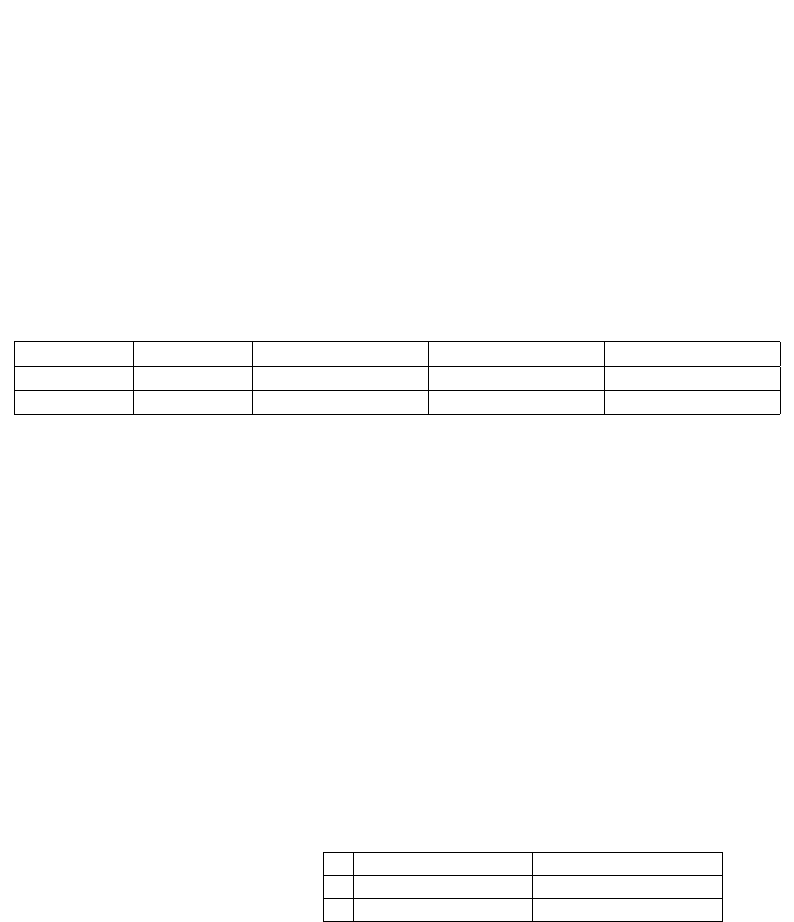
ROI-S05749 SYSTEM SETUP
3-13
Notes : *1 When the LAN/WS INTFC is provided, status of each LAN
PORT is displayed as follows.
Notes:For the GbE INTFC, there are distinctions for the
following functions from the 10BASE-T/100BASE-Tx
1. RX Undersize: Unavailable.
2. RX Fragments: Unavailable.
3. RX Symbol Errors:
For SFP: Available
For RJ-45: Unavailable (un-counting, only "0" is
indicated.)
4. TX Multicast PKts (Including number of the TX pause
packets.)
5. RX Multicast PKts (Including number of the RX pause
packets.)
6. Countable packet size for the following items shown in
right side of the table and reading must be taken place
as follows. (The indication will not be taken placed.)
7. The RX Alignments Error is counted as an RX CRC
ERR.
RX Pkts 512 to 1023
RX Pkts 1024 to 1536
TX JABBERS
TX UNICAST
TX BROADCAST
TX MULTICAST
TX PAUSE
TX COLLISION
Event List SONET
Status of LAN PORT
Link Collision LLF Speed & Duplex
Sub PORT1 Link Normal Normal 100M-Full (MDIX)
Sub PORT1 Link Normal Normal 100M-Full (MDIX)
Indication Reading
15 RX Pkts 1024-1536 RX Pkts 1024-1518
16 RX Pkts 1537-MAX RX Pkts 1519-MAX
SYSTEM SETUP ROI-S05749
3-14
3.4 Control
The control condition is based upon equipment setup and provisioning
setup, therefore control items vary depending on the those setup.
The control items that are displayed on the LCT PC are listed in the
following table. the control operation can be performed in Maintenance
“ON”.

ROI-S05749 SYSTEM SETUP
3-15
Note *1: only for 1+1 Configuration.
Control List (SONET)
Control
Maintenance
TX SW Manual Control *1
RX SW Manual Control *1
RX SWMaintenance Mode
ATPC Manual Control(No.1)
ATPC Manual Control(No.2) *1
TX Mute Control(No.1)
TX Mute Control(No.2) *1
CW Control(No.1)
CW Control(No.2) *1
APS Manual Control (Auto/Working/Protection) : Only APS configuration
APS Maintenance Mode : Only APS configuration
IF Loopback(No.1)
IF Loopback(No.2) *1
Main Loopback (Near End)
Main Loopback (Near End) INTFC (1) : Only APS configuration
Main Loopback (Near End) INTFC (2) : Only APS configuration
Main Loopback (Far End)
Linearizer Control(No.1)
Linearizer Control(No.2) *1
ALS Restart : Only Optical INTFC
XPIC Control Local(No.1) : Only XPIC configuration
XPIC Control Local(No.2) : Only XPIC configuration
XPIC Control Remote(No.1) : Only XPIC configuration
XPIC Control Remote(No.2) : Only XPIC configuration
Offline Maintenance
DADE Adjust
RF SUB Band Select(No.1)
RF SUB Band Select(No.2) *1
RF Shift Frequency Setting(No.1)
RF Shift Frequency Setting(No.2) *1
Antenna Alignment Mode(No.1)
Antenna Alignment Mode(No.2) *1
SYSTEM SETUP ROI-S05749
3-16
3.5 Setup Description
The following describes to select suitable functions for the system
operation by the provisioning setup.
3.5.1 Automatic Laser Shutdown Control (OPT INTFC) (SONET)
The OC-3 INTFC (only for OPT) is provided with the Automatic Laser
Shutdown (ALS) function that can be enabled or disabled. If the ALS
function is enabled, the laser output is periodically turned ON and OFF
when the optical cable carrying the OC-3 signal is disconnected
inadvertently, or intentionally during maintenance. When the ALS
function is disabled, the laser output is always ON even if the optical cable
is disconnected. Fig. 3-1 shows a block diagram of the ALS function.
If a fault occurs at point A and the absence of the optical input signal in the
RX 2 lasts for 550 ±50 msec (OC-3 LOS alarm condition), the optical
signal bound for the RX 1 (MUX equipment) from the TX 2 (OPT INTFC
module) is interrupted by a control signal generated inside the OPT INTFC
module. The MUX equipment detects the loss of signal at RX1 and the
ALS function in the MUX will, subsequently, turn off the laser output of
TX1. When the fault at point A is cleared the system can be restored by
controlling the laser output of TX2 through one of the following modes:
• Automatic control
• Manual restart (2 sec.) control
• Manual restart (90 sec.) control
(a) Automatic Control
When 60, 180 or 300 sec.(selectable) have elapsed after the optical
signal entering RX 2 is cut off, the IDU emits laser signal from TX
2 to RX 1 for 2 sec. This would then cause the laser output of TX1
to turn on. If, at this time, the fault at point A has been cleared, the
ALS function will be released and the operation will return to
normal.
(b) Manual Restart (2 sec.) Control
Upon receiving a command signal for manual restart from the LCT
or the PASOLINK network management terminal (PNMT) while
the optical input signal to the RX 2 is off, the IDU emits the laser
signal from the TX 2 to the RX 1 for 2 ±0.25 sec. This would then
cause the laser output of TX1 to turn on. If, at this time, the fault at
point A has been cleared, the ALS function will be released and
the operation will return to normal (if not it returns to automatic
condition).
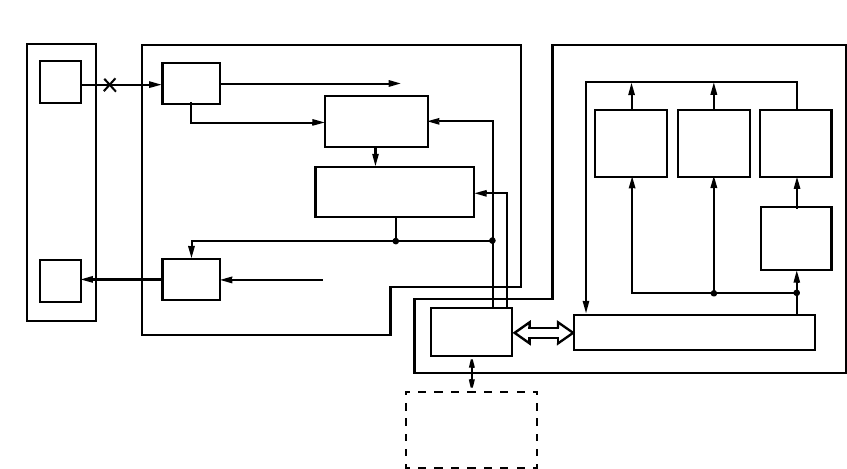
ROI-S05749 SYSTEM SETUP
3-17
(c) Manual Restart (90 sec.) Control
Upon receiving a command signal for manual restart for test from
the LCT or the PNMT while the optical input signal to the RX 2 is
off, the IDU emits the laser signal from the TX 2 to the RX 1 for 90
±10 sec. This would then cause the laser output of TX1 to turn on.
If, at this time, the fault at point A has been recovered, the ALS
function will be released and the operation will return to normal (if
not it returns to automatic condition).
Fig. 3-1 ALS System Functional Block Diagram
MUX
EQUIPMENT OPT INTFC
TX1
RX1
AO/E
RLOS 550 ± 50 ms
TIMER
O/E
RX2
TX2
CONT
LCT or PNMT
DATA BUS
60/180/
300 sec.
DELAY
2±0.25S
TX ON
TIMER
CTRL
ALS CONT
ENABLE/DISABLE
2S
TX ON
TIMER
90±10S
TX ON
TIMER
SB/DATA
BUS
CLEAR
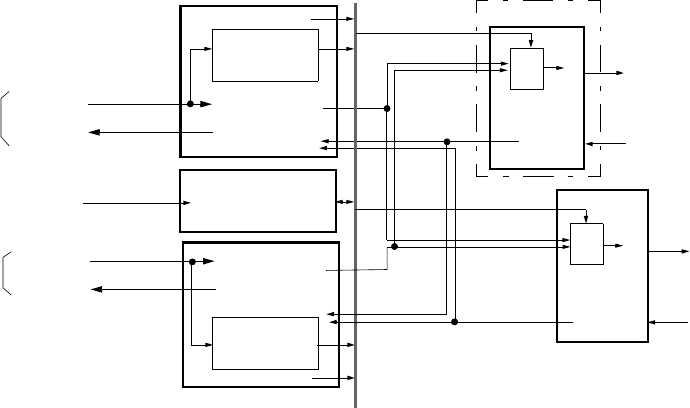
SYSTEM SETUP ROI-S05749
3-18
3.5.2 Automatic Protection Switching (APS) (OPT INTFC Optional
APS Configuration) (SONET)
(a) Line Protection
The Automatic Protection Switching (APS) provides for uni-
directional line protection against optical cable interface failures. It is
performed by detected alarm condition or remote control signal.
Fig. 3-2 OPT APS System
The OC-3 (OPT) INTFC monitors the OPT line input signal interface
condition and when an alarm condition occurs in the optical cable or
optical interface module, APS is activated. Also the APS is activated
when remote control signal is received.
Uni-directional APS is performed only in the receiving section of the
local side when a failure or signal degradation of the received signal
is detected in one direction. Fig. 3-3 shows APS switching mode.
OC-3 (OPT)
INTFC
MODEM
Working
OPT IN
OPT OUT
Protection
MODEM
only 1+1
OC-3 (OPT)
INTFC
SW
SW
LOS/LOF/BER
DET
LOS/LOF/BER
DET
OPT IN
OPT OUT
CTRL
Remote
Module Failure
Module Failure SW CTRL
SW CTRL
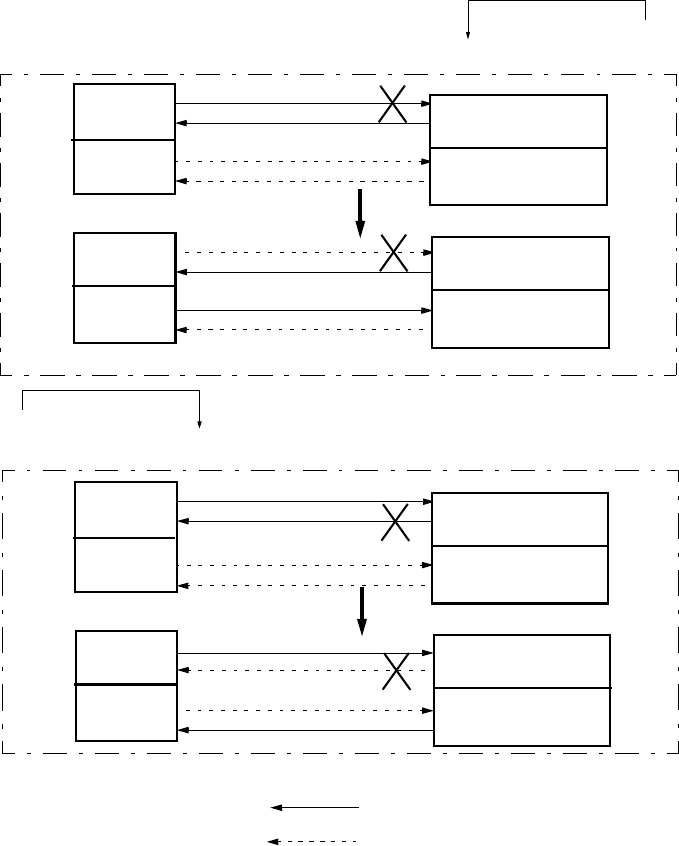
ROI-S05749 SYSTEM SETUP
3-19
Fig. 3-3 Line Protection
(1)
(2)
Uni-directional Mode Line Protection
(Work)
(Prot)
(Work)
(Prot)
OC-3 (OPT) INTFC
(No.1)
OC-3 (OPT) INTFC
(No.2)
OC-3 (OPT) INTFC
(No.1)
OC-3 (OPT) INTFC
(No.2)
Received OPT failure
(1)
(2)
(Work)
(Prot)
(Work)
(Prot)
OC-3 (OPT) INTFC
(No.1)
OC-3 (OPT) INTFC
(No.2)
OC-3 (OPT) INTFC
(No.1)
OC-3 (OPT) INTFC
(No.2)
Received OPT failure
NLite E
ASSOCIATED EQUIPMENT
NLite E
ASSOCIATED EQUIPMENT
SW CTRL
SW CTRL
WORKING
PROTECTION
WORKING
WORKING
PROTECTION
PROTECTION
WORKING
WORKING
PROTECTION
PROTECTION
WORKING
PROTECTION
WORKING
WORKING
PROTECTION
PROTECTION
Note:ON LINE
OFF LINE
SYSTEM SETUP ROI-S05749
3-20
(b) APS Function Setup
The APS switchover is performed with the following order of priority
of two (2) modes.
(1) When “APS Condition-SF” is lower priority (default).
• UNEQUIP > LKI*1 > FSW > SF > SD*2 > MSW
(2) When “APS Condition-SF” is higher priority.
• UNEQUIP > LKI*1 > SF(P) > FSW > SF(W) > SD*2 > MSW
Notes: *1 Excluding when the Lock in Usage is set Not Used.
*2: Excluding when the APS Condition-SD(B1) is set to
Excluded SD.
UNEQUIP:Unequipped redundant OC-3 INTFC (OPT).
LKI:Lock in (see following descriptions Lock in for detail)
FSW:Forced Control (see following descriptions when APS
Maintenance Mode is set to Forced)
SF: Signal Fail (see following descriptions of APS
Condition-SF(PROT)
SF(P); Signal Fail of Protection side
SF(W); Signal Fail of Working side
SD; Signal Degrade (see following descriptions APS
Condition-SD(B1) for detail)
MSW;Manual control (see following descriptions when APS
Maintenance Mode is set to Manual)
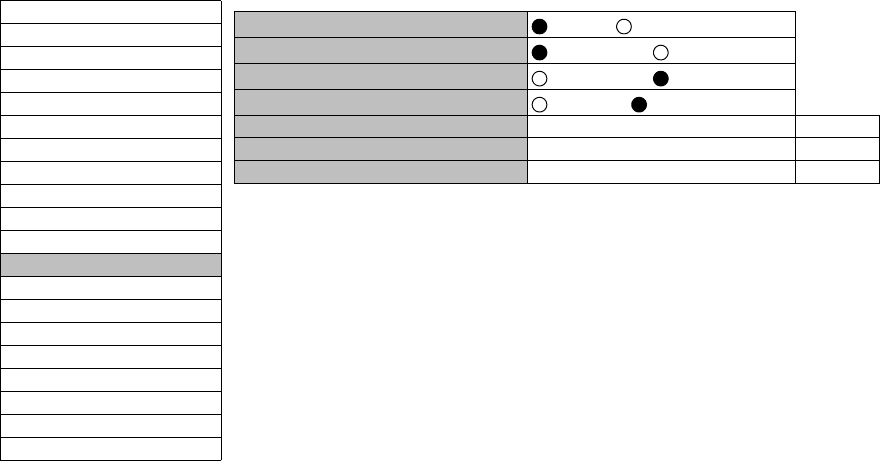
ROI-S05749 SYSTEM SETUP
3-21
• APS Maintenance Mode
This is a setup to give priority to manual control operation in
maintenance.
Manual: Give priority to alarm events in maintenance
operation. In this mode, manual control disables the
operation under alarm condition.
Forced: Give priority to forced control in maintenance
operation. In this mode, manual control enables the
operation under alarm condition and the alarmed side
can be selected.
Caution: When the APS Maintenance Mode is set to
“Forced” in provisioning, APS manual control can
select either Working or Protection line though one
is alarmed. Then, take care switching to avoid traffic
interruption.
• APS Condition-SF(PROT):
This is a setup to give higher priority to switchover by SF in
Protection side.
Priority High: This setup gives highly priority to SF of Protection
side (installed in INTFC Slot2) for switchover
control condition. Since the setup gives priority
higher than the Forced Control, the ONLINE is
maintained in Main side (installed in INTFC Slot1)
under occurrence of SF condition of Protection side.
LCT MENU
Alarm/Status
Equipment Setup
Inventory
AUX I/O
Maintenance
Provisioning
BER Threshold Setting
SC Assignment
OC-3 Setting
TX Power Control
Condition for TX/RX SW
Condition for APS
Relay Setting
TCN Threshold (15min)
TCN Threshold (1day)
PMON Select
Others
Metering
PMON(Current)
PMON(History)
---Condition for APS--- Range
APS Maintenance Mode Manual Forced
APS Condition-SF(PROT) Priority High Priority Low
APS Condition-SD(B1) Included SD Excluded SD
Lock in Usage Not Used Used
Lock in Detect Count [times] 4 1 to 255
Lock in Detect Time [min] 10 1 to 60
Lock in Hold Time [hours]) 24 1 to 48
SYSTEM SETUP ROI-S05749
3-22
• APS Condition-SD(B1)
This is a setup that it includes the SD or excludes SD for the
switchover control condition. When including it, the switchover is
performed when SD reaches the threshold value which is set in BER
Threshold/SD (MUX) in provisioning.
Include SD: Including SD for switchover condition
Exclude SD: Excluding SD for switchover condition
• Lock in
The function is used to pause the switchover activation for a period of
time when in the switchover of frequent occurrence.
The following setting is needed to be used for it.
Lock in Count: Setup for the Lock in threshold value of the
switchover number of times.
(setting range: 1 to 255 times)
Lock in Detect time: Setup for the watching interval of counting
number of times for Lock in.
(setting range: 1 to 60 minutes)
Lock in Hold time: Setup for the duration of pause of switchover
in the Lock in condition.
(setting range: 1 to 48 hours)
The Lock in status can be observed on the Alarm/Status of LCT
display.
The Lock in condition may be released after passing the Lock in Hold
time or the change of setting.
The following is an example in default value.
• Lock in Count: 4
• Lock in Detect time: 10
• Lock in Hold time: 24
This sets into the Lock in condition when the switchover is activated
more than 4 times within 10 minutes interval of watching number of
times. The switchover activation pauses during 24 hours after set in
the Lock in condition. The Lock in condition will be released after
passing of 48 hours and it sets into normal mode.
When it will be manually released that under the Lock in condition,
perform resetting by changing parameter value or changing the
setting condition to “Lock in Usage Not Used”.
ROI-S05749 SYSTEM SETUP
3-23
3.5.3 Automatic Transmitter Power Control
The automatic transmit power control (ATPC) function automatically
varies the TX output power according to path conditions. In the SHF and
EHF band, fading exerts heavy influences on propagation, causing the
receive signal level at the opposite station to vary. The ATPC function
operates by controlling the transmit output power of the opposite station
according to the variation of the received signal level at the local station.
ATPC provides the following advantages:
• Improvement in up fading characteristics
• Improvement in residual BER characteristics
• Reduction of interference to intra system
• Reduction of interference to inter system
Note: In the XPIC configuration, ATMC/MTPC setup and action
control in the Sub Master station are applied from the Main
Master station.
A functional block diagram of the ATPC operation is shown in Fig.
3-4.
ATPC improves the BER characteristics under adverse changes in
climatic conditions and reduces the possibility of interference. To
implement ATPC, the received level (RX LEV) is detected by the
Receiver (RX) in the ODU and passed to the CPU in the CTRL
module. The CPU then determines whether the transmit output
power needs to be controlled. This is based on the transmit output
power and the minimum and maximum values of the output control
range (ATPC range). ATPC is relevant for the receiving threshold
level that were previously specified using the LCT or PNMT (as
ATPC Threshold Level).
A control signal (POWER CTRL), whose function is to maintain the
received RX signal level (RSL) by decreasing or increasing the TX
output power of the opposite station, is generated by the CTRL
module through the MD Unit. This control signal is based on the
result of comparison between the current receiver input level and
the preset receiving threshold level. This control signal is sent to the
opposite station to control its transmit output power.
At the opposite station, this control signal is detected by the CTRL
module. The TR Unit, in accordance with this control signal,
produces a control that will either raise, lower or maintain the
current TX output power.
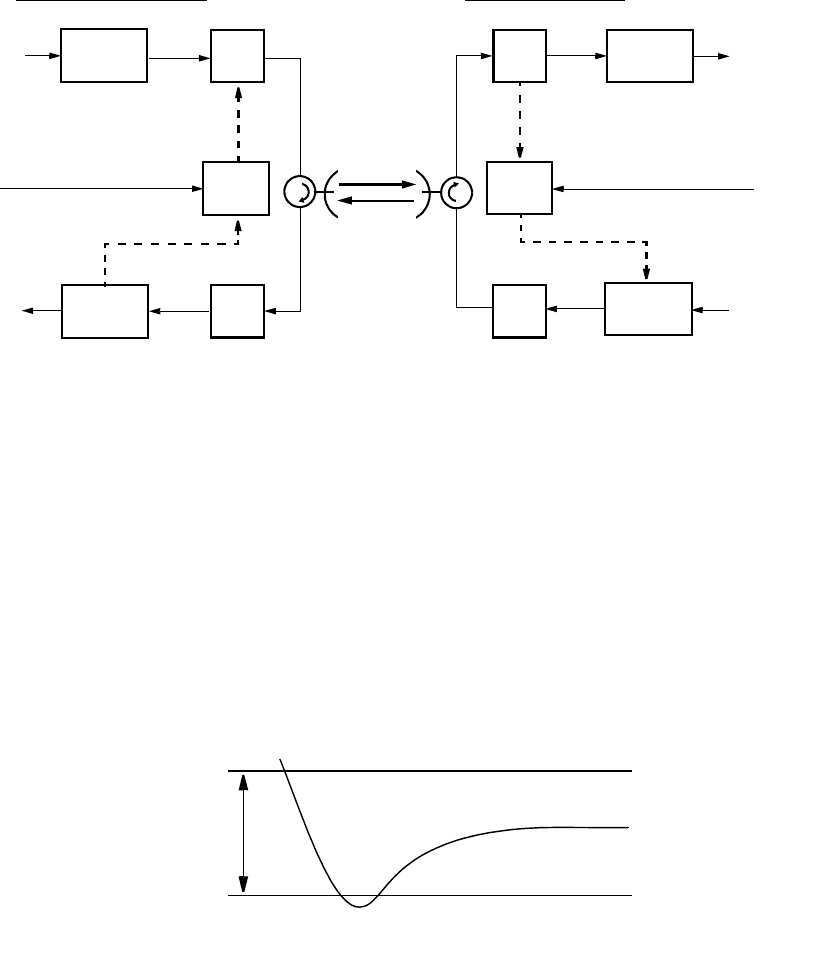
SYSTEM SETUP ROI-S05749
3-24
Fig. 3-4 ATPC, Functional BLock Diagram
Example of ATPC setting.
Where ATPC MAXIMUM PWR of ATPC Range is set to 0 dB, ATPC
MINIMUM PWR is set to -10 dB and RX Threshold to -55 dBm. In this
case, if RX level is lower than -55 dBm, monitor/control is performed with
the interval of 8 msec. RX level is monitored in 1 dB step, and TX output
is controlled in 1 dB step.
However, a fixed hysteresis of 5 dB referred to the RX Threshold is
implemented for ATPC operation.
Example: If RX Threshold is set to -55 dBm, no output control is made
unless the RX level goes below -55 dBm or goes above -50 dBm, so that
the receive level is maintained within -55 to -50 dBm by ATPC.
TX
TX
RX
RX
POWER CONT
REMOTE
RX IN LEV
REMOTE
CTRL CTRL
ATPC CTRL ATPC CTRL
TRANSMITTING STATION RECEIVING STATION
MODEM
MODEM
MODEM
MODEM
-50 dBm
RX LEVEL
-55 dBm
(RX THRESHOLD
LEVEL)
5 dB
(ATPC
HYSTERESIS)
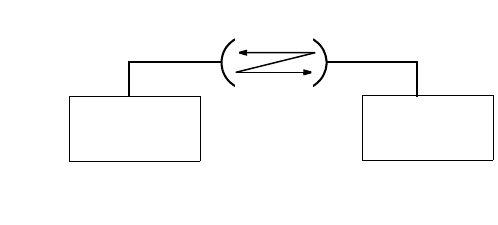
ROI-S05749 SYSTEM SETUP
3-25
Using MTPC-ATPC
The ATPC Control System of the PASOLINK transmits the information on
the receiving level to the opposite station and controls the transmission
level of its local station in accordance with the receiving level of the
opposite station. Transmission level control can be used not only for
setting the same operation (ATPC-ATPC) between local station and
opposite station but also for operation in combination of stations with
different operations (MTPC-ATPC, ATPC-MTPC). The station set in
MTPC mode is not controlled by the information from opposite station but
is fixed in its transmitting output level.
Even if the station is set in the MTPC mode, the opposite station is likely
to be set in the ATPC mode. Therefore, setting the RX Threshold (ATPC
Threshold level) is required for controlling the transmission level of the
opposite station. Between the stations that are respectively set in the
MTPC mode, however, the setting is disabled.
The following is an example of operation between stations set in MTPC-
ATPC mode.
The transmitting level of station B is controlled so that the receiving level
of station A in the above figure reaches the RX Threshold set level (−50
dBm) set in station A. This method is used in station A for reducing the
level of interference to other route. As station A is set in the MTPC mode,
the transmitting level is kept unchanged.
An example of using MTPC-ATPC is shown below. As shown in the
figure, in the master station communicating with many substations, waves
gather from substations possibly causing interferences. Therefore,
substations must be set in the ATPC mode to minimize the diffraction
(interference) to other routes while reducing the receiving levels from
individual substations to the minimum. In substations, there is little
possibility of occurring interferences; therefore, the master station is set in
the MTPC mode to permit transmission at a constant level.
MTPC
(RX Threshold: −50 dBm) ATPC
PASOLINK
ODU
PASOLINK
ODU
STATION A STATION B
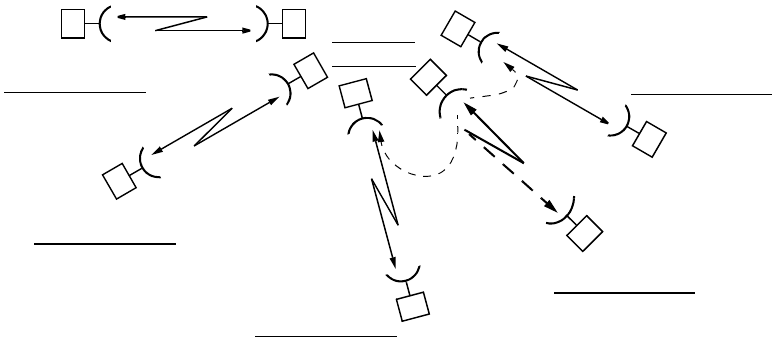
SYSTEM SETUP ROI-S05749
3-26
A constant transmit output power in both MTPC and ATPC is maintained
using the ALC function which is provided in the RF CKT module. The
ALC circuit detect the transmit output power using a diode to obtain a DC
voltage proportional to the transmit power. The gain of the RF amplifier is
controlled inversely with this detected DC voltage to maintain the transmit
output power within the specified limits.
When the ATPC malfunction occurs, transmitter output power is
maintained at the following level according to the ATPC mode. The ATPC
mode is set in provisioning using LCT.
Hold:Maintain the TX output level at the current level, when the
ATPC malfunction occurs.
MAX:Maintain the TX output level at ATPC maximum level, when
the ATPC malfunction occurs.
MIN:Maintain the TX output level at ATPC minimum level, when
the ATPC malfunction occurs.
(ATPC)
SUBSTATION 2
(ATPC)
SUBSTATION 3
(ATPC)
SUBSTATION 4
MASTER
STATION
(ATPC)
SUBSTATION 1
(ATPC)
SUBSTATION 5
(A)
(B)
(A),(B)
(C)
: Diffraction to other route.
: RX received level down.
(C)
(MTPC)
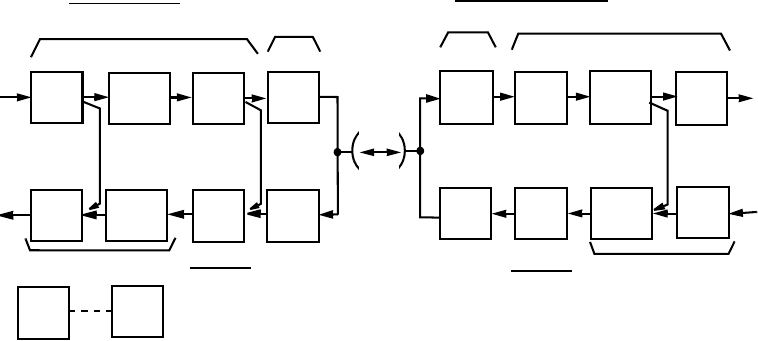
ROI-S05749 SYSTEM SETUP
3-27
3.5.4Loopback Control
The loopback function is provided for checking the system quality during
maintenance and/or to quickly isolate a fault location on the SONET
configuration. The control is performed by the LCT, the PNMT or the
PNMS.
Provided here is the control of the:
• Near-End loopback is performed at the OC-3 INTFC module.
• Far-End loopback is performed at the OC-3 INTFC module.
• IF loopback (IF-LB) is performed at the MODEM module ((c) in Fig.
3-5) for IF signal.
Notes: 1. During the IF loopback is in execution, monitoring of
the opposite and the subsequent stations are disabled on
the PNMS and PNMT.
2. Loopback control will interrupt the radio link condition.
3. The IF LOOPBACK and the RX SW is not operated
interlock. The RX SW switching is necessary to select
the same CH with IF LOOPBACK in 1+1 configuration.
Fig. 3-5 Loopback Location
3.5.5 Link Loss Forwarding Control (LAN)
Link Loss Forwarding (LLF) control provides two kinds of functions for
10/100BASE-T interface. One is to automatically stop the output from the
DATA
IN
IDU
OWN STATION OPPOSITE STATION
DEM
TX
RX
DATA
OUT
(a) (c)
( )INTFC MODEM
ODU IDU
DEM
TX MOD
RX DATA
OUT
( )INTFCMODEM
ODU
MOD
(b)
CTRL
LCT/
PNMT
DEMUX
MUX
Note: Reverse direction is the same as above.
CODE
CONV
CODE
CONV
CODE
CONV
CODE
CONV
DEMUX
MUX
OC-3/E1/E3
OC-3/E1/E3
OC-3/E1/E3
DATA
IN
OC-3/E1/E3
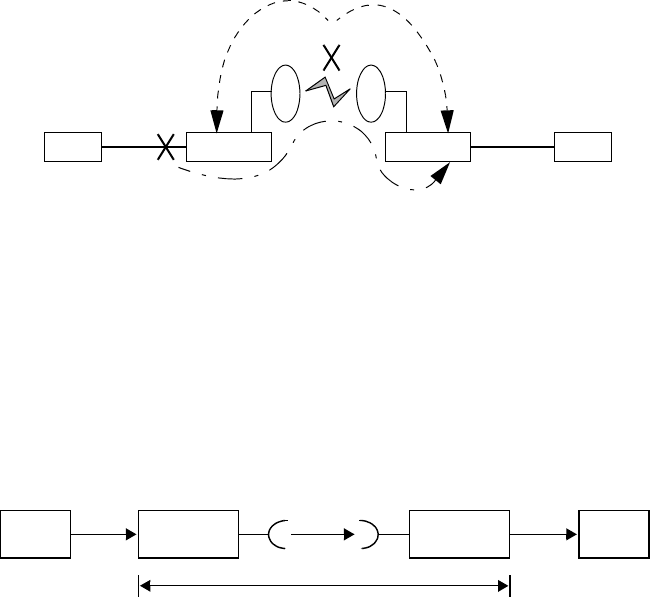
SYSTEM SETUP ROI-S05749
3-28
LAN port to alert the equipment connected with the LAN port when the
system has been disconnected by the fault in the radio section. The other is
to transmit the information for cutting the link interconnected with the
LAN port in the opposite station when the link between the LAN port and
equipment is faulty. This function can be selected by setting
“Provisioning” on LCT to “Enable” or “Disable”.
3.5.6 MS-AIS Generation (SONET)
When any fault occurs in the NLite E equipment, or when OC-3 input
signal disappears, or when any fault occurs in radio section, The function
of MS-AIS Generation causes the OC-3 output signal from the NLite E
equipment to be stopped and/or non-frame signal (all “1”) to be output, to
detect the fault in the MUX equipment of the opposite station.
This function can be selected by setting “Provisioning” on LCT to
“Enable” or “Disable”. Normally, this function is set to “Enable”. If this
function is set to “Disable”, the function of MS-AIS Generation is stopped.
AUTO: Output Stop
Radio Fault
HUB HUBLAN LAN
FAULT
NLite E NLite E MUXMUX
DATA
IN
DATA
OUT
RADIO SECTION
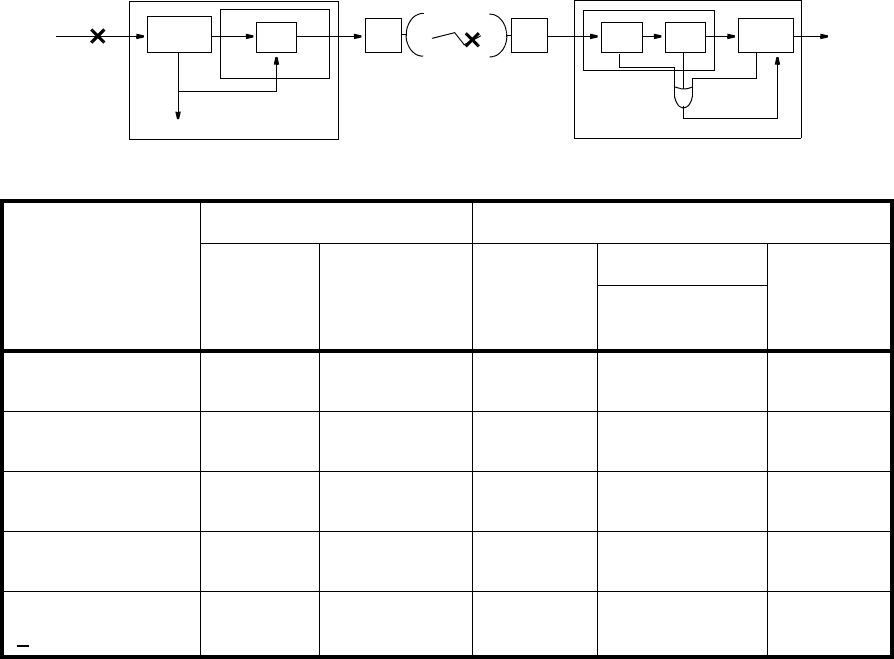
ROI-S05749 SYSTEM SETUP
3-29
For example, at the station A, when the NLite E equipment detects the OC-
3 input Loss Of Signal (LOS) and/or Loss Of Frame (LOF), the
information is transmitted to the station B by using RFCOH. When the
station B detects the information, NLite E equipment stops the OC-3
output signal. Similarly, it is the same even if a receiving input level down
or loss of radio frame (LOF) appear in station B.
Notes:1. * Optical interface: Shutdown
Electrical interface: all “1”
2. When the MS-AIS Generation is “Enable”, status indication of
MS-AIS Generation on LCT is not indicated.
Event
Station A Station B
LED LCT LED
LCT
OC-3
OUTPUT
OC-3 Output
Control
OC-3 Input Loss at
Station A IDU ALM MAIN INTFC
LOS ⎯Under Execution Shutdown *
(or all “1”)
OC-3 Loss of Frame
at Station A IDU ALM MAIN INTFC
LOF ⎯Under Execution Shutdown *
(or all “1”)
RX Level Down ⎯N/A ODU ALM Under Execution Shutdown *
(or all “1”)
Loss of Radio
Frame at Station B ⎯N/A IDU ALM Under Execution Shutdown *
(or all “1”)
BER Degrade
(≤1E-4) at Station B ⎯N/A IDU ALM Normal N/A
STATION A STATION B
NLite E
ODU ODU FSYNC
LOF
OC-3 OUTPUT CONTROL
RLOS/RLOF
RFCOH
MODEM
OC-3
INTFC RFCOH
MUX
RFCOH
DEMUX
OC-3
INTFC
OC-3
OUTPUT
OC-3
INPUT
LOS
LOF
INPUT
LOSS
MODEM
OC-3
LOF
NLite E
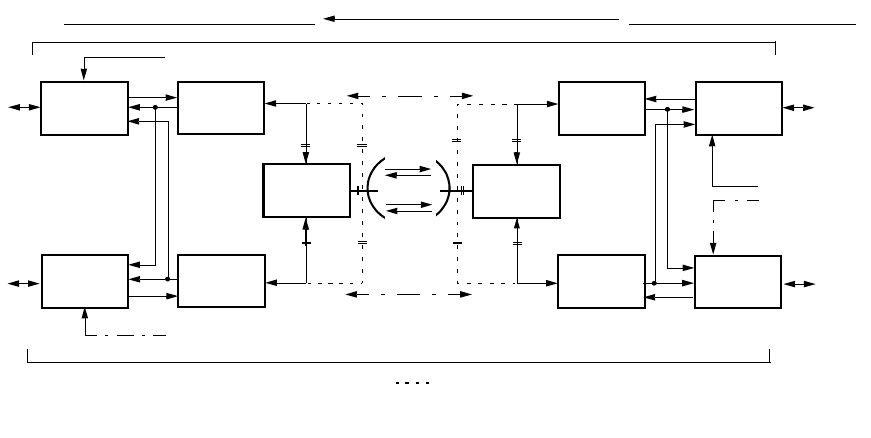
SYSTEM SETUP ROI-S05749
3-30
3.5.7 Cross Polarization Interference Canceller (XPIC) Reset Control
For the Cross Polarization Interference Canceller (XPIC) to function
properly, signals for both Main Master and Sub Master sides must be
received normally. For this reason, when either signal is in abnormal
condition, the XPIC RESET function provides a way for turning off the
XPIC operation. Local/Remote XPIC reset can be controlled separately to
the Main Master and Sub Master.
The LOCAL RESET and/or REMOTE RESET control is performed to the
channel which is working online when the system is following conditions.
• When the MODEM or ODU is replaced.
• Frame Synchronization is lost (FASYNC) at the MODEM module in
the Co-pol. channel.
• At the MODEM module in the Co-pol. channel, IF signal from X-pol.
channel is lost (XIF alarm).
• The system is controlled in IF loopback (IF-LB) condition with the
LCT, PNMS or PNMT.
• The XPIC RESET control is executed from the LCT, PNMS or
PNMT.
• The XPIC RESET control is applied from the MODEM module in
the X-pol. channel.
• The XREF or LO REF alarm condition occurs.
Note: The SD system can not be applied for the XPIC configuration.
H-pol
V-pol
LOCAL STATION (Main Master)
IDU
IDU
Main Master CH
ODU
Sub Master CH
ODU
OMT
IDU
IDU
ODU
ODU
OMT
OPPOSITE STATION (Sub Master)
Fig. 3-6 XPIC Reset Control
Dual Pol.
V-pol
H-pol
Remote XPIC reset V-pol
Remote XPIC reset H-pol
reset V-pol
Local/Remote XPIC
reset H-pol
Local/Remote XPIC
REMOTE
Note : Feeder Connection for Dual Pole Feed Antenna.
Control
coincidence
coincidence
f1
f2
f2
f1
OC-3
CH1
OC-3
CH1
OC-3
CH2
OC-3
CH2
XIF XIF
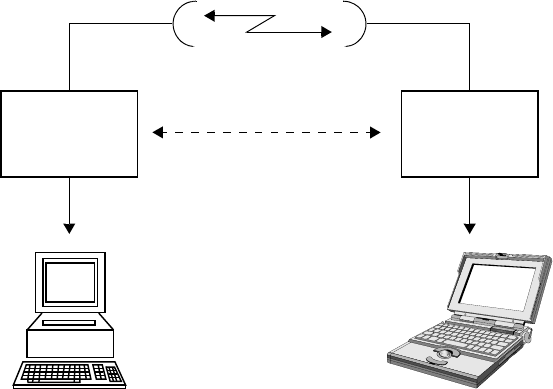
ROI-S05749 SYSTEM SETUP
3-31
3.5.8 Network Management (Optional)
The Network Management System (NMS) configuration is shown in Fig.
3-7. The PASOLINK network management system (PNMS) is connected
to the NMS (LAN) connector of the IDU located at the designated
maintenance center while the PASOLINK network management terminal
(PNMT) is connected to the LCT USB connector on the IDU of remote
stations. The PNMT/PNMS provides monitoring and control of the actual
microwave link status and its associated Nlite E equipment. Status
information form and control signals to remote stations are transmitted
using RFCOH.
For detailed information, refer to the related PNMS or PNMT manual.
Fig. 3-7 Network Management System
PNMS PNMT
NLite E
PNMS: PASOLINK Network Management System
PNMT : PASOLINK Network Management Terminal
LCT
NMS (LAN)
CONNECTOR CONNECTOR
NLite E
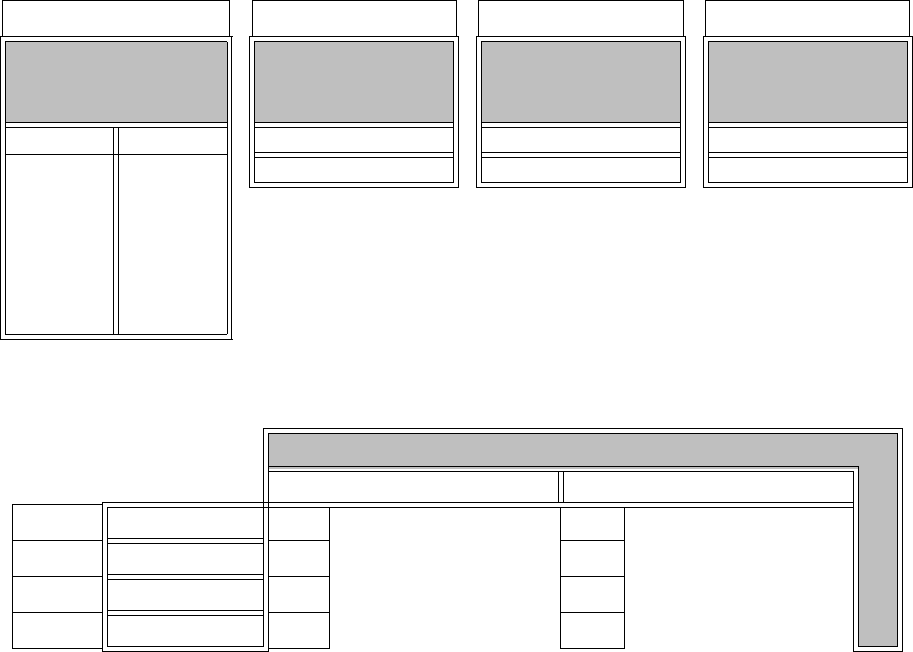
SYSTEM SETUP ROI-S05749
3-32
3.5.9 Functionality Classification
The functionality of the NLite E is defined by optional system parameters,
interface card and transmission capacities as listed in the following
categories. The functionality is found in the Software Key in the LCT
Inventory menu.
Functionality Classification of the NLite E
1 2 3 4
Capacity
and
Redundancy
Bit Rate LAN Interface XPIC
Functionary
1+0 System 1+1 System Fixed Available Available
1. 10 MB 1. 10 MB Free Unavailable Unavailable
2. 20 MB 2. 20 MB
3. 40 MB 3. 40 MB
4. 80 MB 4. 80 MB
5. 100 MB 5. 100 MB
6. 156 MB 6. 156 MB
Optional System, Interface Card and Transmission Capacity
System and Transmission Capacity
1+0 1+1
OC-3 Opt S1.1 156MB 156MB
OC-3 Opt L1.1 156MB 156MB
2P LAN 156MB 156MB
GbE 156MB 156MB
ROI-S05749 SYSTEM SETUP
3-33
3.6 Protection Switching
Protection switching is provided in the 1+1 Twin-path and the HS systems.
3.6.1 1 + 1 Twin-path System
Protection switching in this system is performed by a hitless switch (HL
SW) on the ( )INTFC module of the IDU at the receiving end.
When both the No. 1 and No. 2 channels are in normal operating
condition, the OC-3 data streams from the associated MUX equipment are
sent to the receiving end through the No. 1 and No. 2 channels. At the
receiving end, the output data streams of the No. 1 and No. 2 channels
MODEM enter the HL SW. The data signal selected by HL SW is fed to
associated MUX equipment.
At the receiving end, when the low bit error alarm (LOW BER ALM) is
detected in the MODEM of the No. 1 channel, the alarm signal is sent to
the switch control logic circuit on the CTRL module. The switch control
logic circuit send the HL SW control signal to the ( ) INTFC module.
Then, the HL SW selects the data signal from No.2 channel. The
switching condition is shown on the RX1 and RX2 STATUS indicators on
the IDU.
3.6.2 Hot-standby System
Protection switching in this system is performed by the TX switches* on
the No. 1 and No. 2 channel ODUs at the transmitting end and by the HL
SW** on the ( ) INTFC module of the IDU at the receiving end.
Note: 1. * Transmit switching is actually accomplished by muting the
output of either No.1 or No.2 channel ODU, using a control
signal from the IDU.
When both the No. 1 and No. 2 channels are in normal operating
condition, the OC-3 data signal from the associated MUX equipment are
sent to the No. 1 and No. 2 channel ODUs through the No. 1 and No. 2
channel IDUs. Here, either of the No. 1 or No. 2 channel signal is selected
at the TX switch on the ODU and fed to the receiving end. At the receiving
end, the output data signal of the No. 1 and No. 2 channels MODEM enter
the HL SW on the ( ) INTFC module. The data signal selected by HL SW
is fed to associated MUX equipment.
SYSTEM SETUP ROI-S05749
3-34
When the modulator alarm is detected in the MODEM or when the TX IF
input alarm, TX power alarm or APC alarm is detected in the ODU, the
alarm signal is sent to the switch control logic circuit on the CTRL
module. The switch control logic circuit produces a TX switch control
signal for selecting the ODU that is in the normal condition. When the
ODU receives the TX switching control signal, the output of the ODU that
is currently active (on-line) is muted and the output of the other ODU is
un-muted. The switching condition is shown on the TX1 and TX2 STAUS
indicators on the IDU.
At the receiving end, when the low bit error alarm (LOW BER ALM) is
detected in the MODEM of the No. 1 channel, the alarm signal is sent to
the switch control logic circuit on the CTRL module. The switch control
logic circuit send the HL SW control signal to the ( )INTFC module. Then,
the HL SW selects the data signal from No.2 channel. The switching
condition is shown on the RX1 and RX2 STATUS indicators on the IDU.
3.6.3 Switchover Control
The following explains the protection switching function in the 1+1 Twin-
path and HS system.
(a) TX Switching
TX switching in HS system is accomplished by muting the TX
output power of either No.1 or No.2 channel ODU. Two mode of
TX switch controls are provided: automatic switching that is
initiated by detection of a failure in the transmit section of the IDU
or ODU, and manual switching is performed by using the LCT.
TX switching, either manually or automatically, may cause a
momentary interruption of the traffic. TX switching have the
following operational mode:
• Switching Mode:
1. Manual : Applied in Maintenance mode.
2. Auto: Normal operating mode.
TX SW Setup in provisioning has following features:
• Switching Priority:
1. Non Priority: Selecting non revertive mode.
2. Priority No.1: This mode is applied to select No.1
when both No.1 and No.2 are normally operating.
ROI-S05749 SYSTEM SETUP
3-35
(b) RX Switch
RX switching in 1+1 Twin-path/HS system is performed by the HL
SW on the ( ) INTFC module.
Two types of RX switch controls are provided: automatic
switching that is initiated by the quality deterioration of the
received signal and manual switching that is initiated by the
operator using the LCT.
The switching mode and switching priority for automatic and
manual switching are identical to those of TX switching. However,
the switching priority is only valid under automatic switching
control. This is because automatic switching is implemented by
hardware logic and manual switching is implemented by software
logic. That is, automatic switching and manual switching are
completely independent and separate operations. Thus, when the
operator reverts to automatic switching after performing manual
switching, the channel will be re-selected by the switch control
logic circuit.
• Switching Mode:
1. Manual : Applied in Maintenance mode.
2. Auto: Normal operating mode.
RX SW Setup in provisioning has following features:
• Switching Priority:
1. Non Priority: Selecting non revertive mode.
2. Priority No.1: This mode is applied to select No.1
when both No.1 and No.2 are normally operating.
• RX SW Maintenance Mode:
1. Manual mode, this disables the RX SW manual control
when either No. 1 or No. 2 RX route is in alarm status.
2. Forced mode, this enables the RX SW manual control
though either or both No. 1 and No. 2 RX routes are in alarm
status.
Caution: When the RX SW mode is set to “Forced” in
provisioning, RX SW manual control can select either
No. 1 or No. 2 RX route though one is alarmed. Then,
take care switching to avoid traffic interruption.
SYSTEM SETUP ROI-S05749
3-36
• RX SW Condition-Early Warning
1. Included Early Warning, this switch over the RX SW at
less than 1E-9.
2. Excluded Early Warning, this switch over the RX SW at
Low BER setting values 1E-6, 1E-7, 1E-8 or 1E-9.
(default value is 1E-7)
• RX Switching Condition Cross Reset
(only XPIC 1+1 configuration):
1. Included Cross Reset, this switch over the RX SW when
XPIC reset control is acted.
2. Excluded Cross Reset, this does not switch over the RX SW
though XPIC reset control is acted.
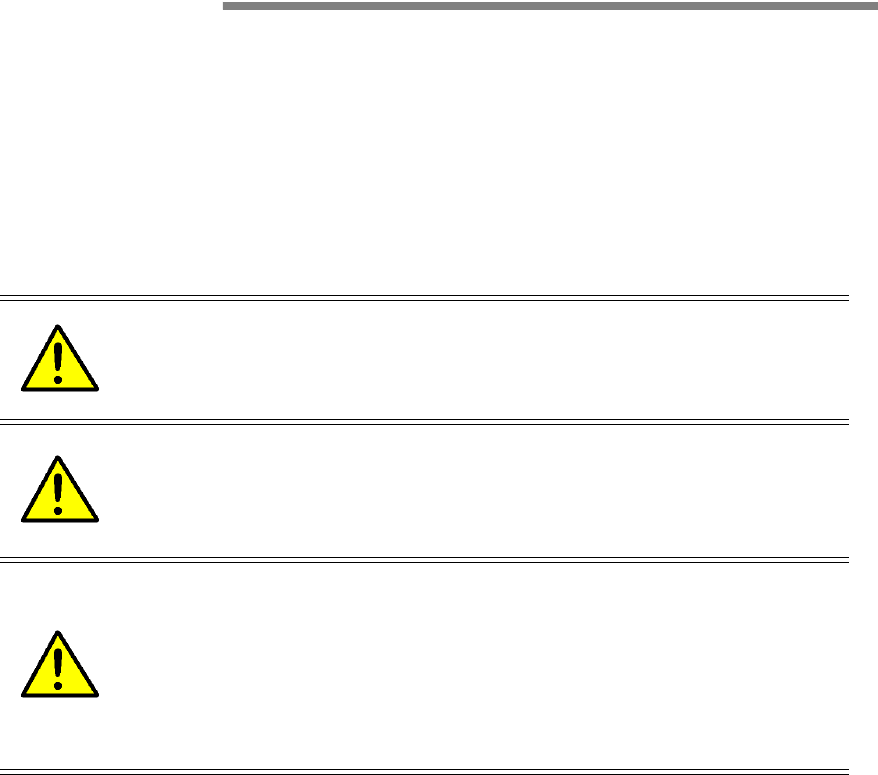
ROI-S05747-052E SAFETY INFORMATION
August, 2007
-1-
SAFETY INFORMATION
This safety instruction is prepared to protect accident resulting personal
injury or death and also physical damage of the equipment during
maintenance or installation. To avoid hazardous conditions, read this
Instruction Manual thoroughly before equipment operation. The signal
words (Danger, Warning and Caution) are used in the Instruction manual
as follows:
GENERAL SAFETY
DANGER
Indicates an imminently hazardous
situation which, if not avoided, will
result in death or serious injury.
WARNING
Indicates an imminently hazardous
situation which, if not avoided, could
result in serious injury or physical
damage.
CAUTION
Indicates a potentially hazardous
situation which, if not avoided, may
result in minor or moderate injury or
physical damage. It is also said to
alert against inappropriate practice.
LABELS
Caution and Warning labels attached to the IDU and ODU as follows:

Turn off power of IDU before
disconnecting cable.
!
-
48V
OUTPUT
Power down IDU
before disconnection
or connection of
cable.
! WARNING
!
-
48V
INPUT
Power down IDU
before
disconnection
or
connection of
cable.
-48V OUTPUT
!
Power down IDU
or connection of cable.
before disconnection
Do not disconnect I/F cable between the IDU and the ODU in
operation condition, to avoid damaging the IDU and the ODU.
The −48 V DC power is superimposed on the center conductor of
the I/F cable between the IDU and the ODU. Connecting a test
equipment directly to this terminal may damage it and touching
the coaxial cable core may cause electrical shock.
CAUTION
HOT SURFACE
Avoid contact.
!
CAUTION
HOT SURFACE
Avoid contact.
!
CAUTION
Non-ionizing
radiation
Be careful that top surface of the IDU is hot.
Caution that the Non-ionizing radiation from the equipment may
effect on health.
CLASS 1
LASER PRODUCT
In a system using the OPT INTFC module, do not stare at the
laser beam or look at it directly with optical instruments.
Otherwise, it may hurt your eyes (Does not apply to PDH).
The mark on the electrical and electronic products only applies to
the current European Union Member States.
SAFETY INFORMATION ROI-S05747
-2-
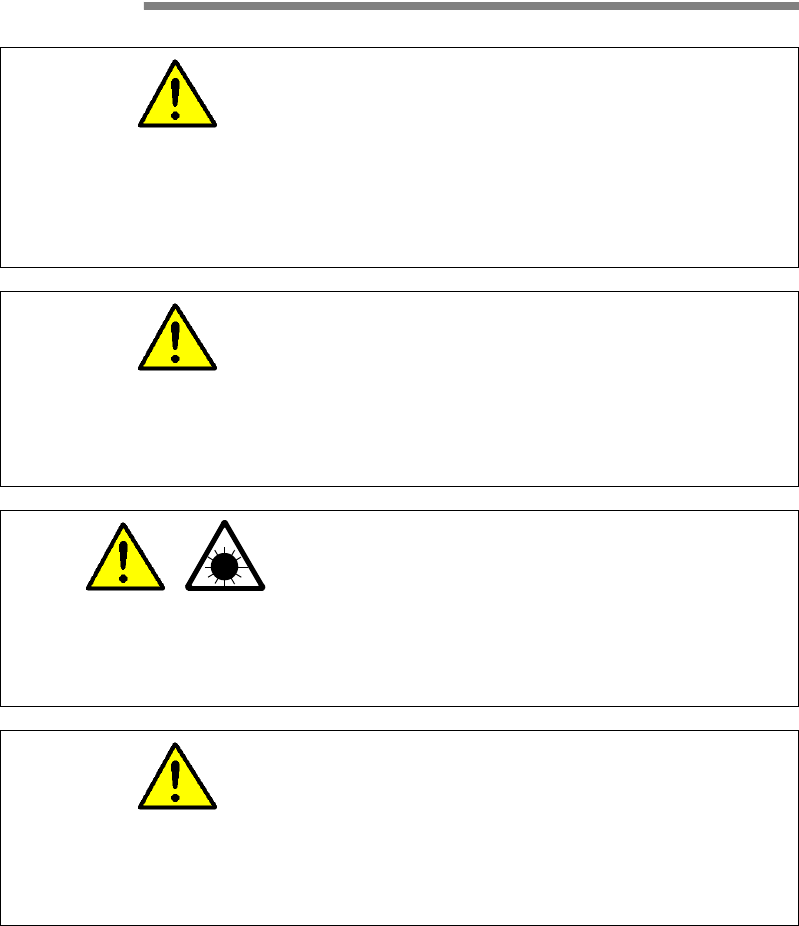
ROI-S05747 WARNING
-3-
WARNING
WARNING
The –48 V DC power is superimposed on the center conductor of the
coaxial cable between the IDU and the ODU. Connecting a test set
equipment directly to this terminal may damage it and touching the
coaxial cable core may cause electrical shock.
WARNING
Do not touch the I/F cable jack core before turning off the power
switch. If touching the coaxial cable core may cause electrical
shock.
WARNING
In a system using the OPT INTFC module, do not stare nor use
optical instruments to look at the laser beam directly as this may
cause eye damage. (Class 1 Laser Product).
WARNING
This is a Class A product. In a domestic environment this product
may cause radio interference in which case the user may be required
to take adequate measures.
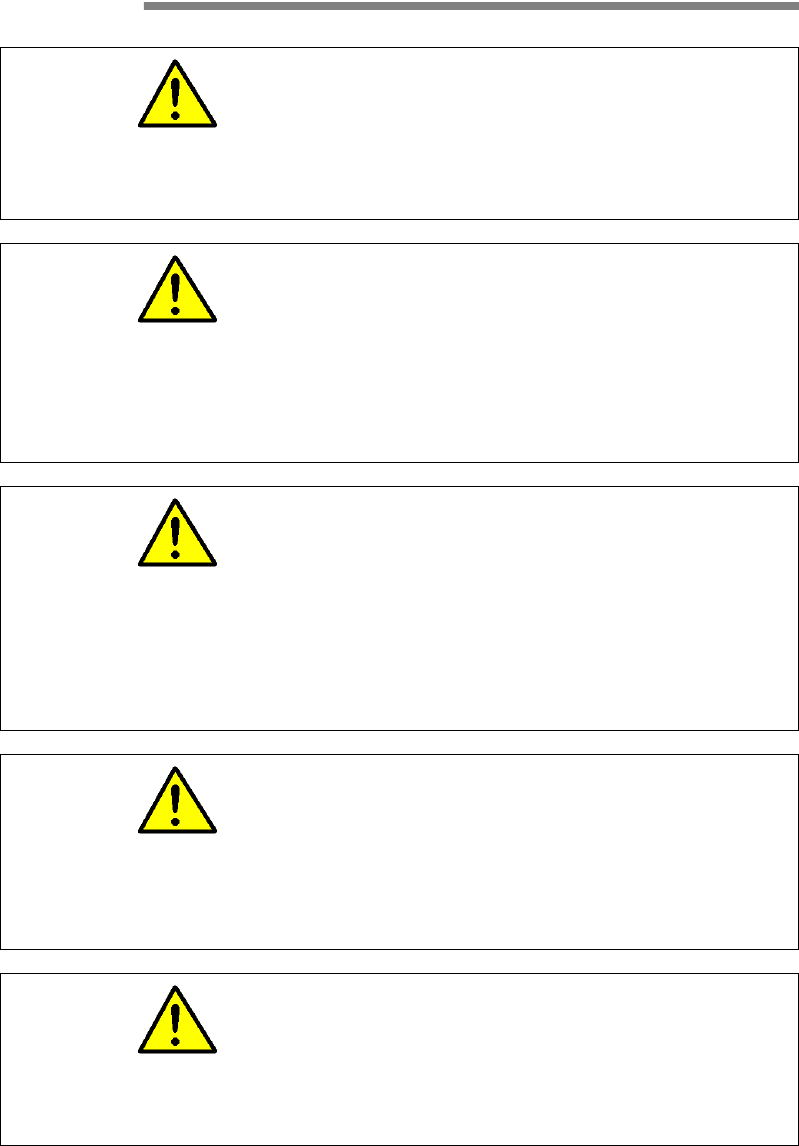
CAUTION ROI-S05747
-4-
CAUTION
CAUTION
While the power supply is ON, do not connect/disconnect the power
supply connector. Otherwise, the DC-DC CONV may break down.
CAUTION
Locate the ODU within the area protected by lightning rod. To avoid
surge currents caused by lightning circulating in the equipment
earth system, connect the equipment earth system (frame ground) to
ground of the lightning rod at ground level.
CAUTION
Interrupt operation and turn off the power switch on the IDU, if in the
event of an emergency situation with appearance such as smoking,
burning smell, and strange sound. Continuation of operation may
cause burning or resulting in electric shock. As there is risk, do not
attempt to repair.
CAUTION
Introduction of spilling liquid, piece of metal, smoke, corrosive gas
or dust into the equipment, or approach of birds or animals may
cause burning or break-down.
CAUTION
Do not perform overhaul, modification or repairing of the equipment.
As it may cause burning or resulting in electric shock.

ROI-S05747 NOTICE (PLACING)
-5-
NOTICE (PLACING)
1. When the ODU is installed in the indoor, as the ODU
generates Non-ionizing radiation and it may cause health
effect, then, it is required to take adequate measures.
2. Do not block the vents of the equipment. It may cause break
down due to heating up of inner equipment in stuffy
condition. Ensure to follow the set up and usage rules as
follows.
Do not set up the equipment on the carpet, heating
floor or bare concrete.
Do not cover or wrap the equipment with table cloth,
lace, rubber or plastic material.
Do not set up the equipment in the bookshelves or
rocker or in a stuffy place.
Do not put anything like books or paper on and
against the equipment.
3. The equipment must be installed in correct place. Do not
install turning sideways or slanting. If not properly
installed, it may cause break down due to rise of inner
temperature.
4. Do not install the equipment in the following locations. If
installed, it may cause harmful influence for the equipment.
The equipment must be installed and maintained in a
clean, and dry place where temperature and humidity
remain stable, non-condensing into dew and within
the ranges specified by the manufacturer.
5. Because of the equipment is an indoor type, do not install
the equipment in the location where it could be caused harm
influence by salt-air, sand-dust, sulphuric acid gas etc..
If the equipment will be installed necessarily in such
location, the following must be heeded.
(a) Construction of the Equipment Room
Install the equipment in the airtight room or shelter
where it could not be suffered by external influence
mentioned above.
NOTICE (PLACING) ROI-S05747
-6-
6 Pages
(b) Environmental Temperature Impact for the Equipment
In the airtight room, it may be caused rising in
temperature with the heat generation of the
equipment.
Furnish an air-conditioner for industrial use in
accordance with the situation.
Do not apply air directly from the air-conditioner to
the equipment. When the equipment is located in face
of the air from the air-conditioner, it could be
condensed into dew by temperature variation.
(c) In the case of using at marine and coastal areas
(within 3 km from the seaside), it is necessary to make
measures against the damage from salt water. For
measures against the damage from salt water to an
ODU, request them to NEC.
6. The place of installation is restricted to Telecommunication
Center and similar environment.

ROI-S05755-054E ABBREVIATIONS
April, 2007
-1-
ABBREVIATIONS
The following abbreviations are used in the manual for the NLite E
equipment.
ABBREVIATION DESCRIPTION
A
AIS Alarm Indication Signal
ALM Alarm
ALS Automatic Laser Shutdown
ANT Antenna
APC Automatic Phase Control
APS Automatic Protection System
ASYNC Asynchronization
ATPC Automatic Transmitting Power Control
AT T Attenuator
AUX Auxiliary
B
BBE Background Block Error
BER Bit Error Rate
BNC Bayonet Navy Connector
BPF Band Pass Filter
C
CAS Channel Associated Signaling
CBL Cable
CD Compact Disk
CH Channel
CKT Circuit
CLK Clock
CMI Coded Mark Inversion
COM Common
COMB Combiner
CONN Connection
CONT Control

ABBREVIATIONS ROI-S05755
-2-
CONV Converter
CPU Central Processing Unit
CTRL Control
CW Carrier Wave
D
DADE Differential Absolute Delay Equalizer
DC Direct Current
DCCr Data Communication Channel in RSOH
DCK Drop Clock
DDT Drop Data
DEM Demodulator
DFP Drop Frame Pulse
DMR Digital Microwave Radio
DSC Digital Service Channel
E
EElectrical
E/O Electrical/Optical
E-BER Excessive-Bit Error Rate
EMC Electro Magnetic Compatibility
EOW Engineering Orderwire
EP Earthing Point
EQL Equalizer
ERR Error
ES Errored Seconds
EXT External
ABBREVIATION DESCRIPTION

ROI-S05755 ABBREVIATIONS
-3-
F
FAS Frame Alignment Signal
FEC Forward Error Correction
FG Frame Ground
FIL Filter
FPGA Field Programable Gate Array
FREQ Frequency
F/W Firmware
G
GGround
GND Ground
H
HD Hard Disk
HK House Keeping
I
ICK Insert Clock
ID Identification
IDT Insert Data
IDU Indoor Unit
IE Internet Explorer
IEEE Institute of Electrical and Electronic Engineers
IF Intermediate Frequency
I/F Inter Facility
IFL Inter Facility Link
IN Input
INTFC Interface
I/O Input/Output
IP Internet Protocol
ITU International Telecommunication Union
ABBREVIATION DESCRIPTION

ABBREVIATIONS ROI-S05755
-4-
L
LAN Local Area Network
LB Loop Back
LCD Liquid Crystal Display
LCT Local Craft Terminal
LED Light Emitting Diode
LLF Link Loss Forwarding
LEV Level
LO Local
LOF Loss of Frame
LOS Loss of Signal
M
MAC Media Access Control
MAINT Maintenance
MD Modulator Demodulator
MDI Media Dependent Interface
MDIX Media Dependent Interface with Crossover
MFAS Multi Frame Alignment Signal
MIX Mixer
MII Media Independent Interface
Mib Management Information Base
MLC Multi-Level Coding
MMC Memory Card
MOD Modulator
MODEM Modulator-Demodulator
MON Monitor
MPX Multiplexer
MS-AIS Multiplexer Section Alarm Indication Signal
MTPC Manual Transmitter Power Control
MUX Multiplexing Equipment
ABBREVIATION DESCRIPTION

ROI-S05755 ABBREVIATIONS
-5-
N
NC Normal Closed
NE Network Element
NMS Network Management System
NO Normal Open
NORM Normal
NRZ Nonreturn to Zero
O
OOptical
O/E Optical/Electrical
ODU Outdoor Unit
OFS Out of Frame Second
OH Overhead
OMT Orthogonal Mode Transducer
OPT Optical
OS Operating System
OUT Output
OW Orderwire
P
PProtection
PC Personal Computer
PDH Plesiochronous Digital Hierarchy
PH Phase
PKG Package
PM PASOLINK Management
PMON Performance Monitor
PNMS PASOLINK Network Management System
PNMT PASOLINK Network Management Terminal
PROT Protection
PS Power Supply
PWR Power
ABBREVIATION DESCRIPTION

ABBREVIATIONS ROI-S05755
-6-
Q
QAM Quadrature Amplitude Modulation
QPSK Quadrature Phase Shift Keying
R
RAM Random Access Memory
REC Rectifier
LO REF Local Reference Frequency
RF Radio Frequency
RFCOH Radio Frame Complementary Overhead
RL Relay
RMON Remote Network Monitoring
ROM Read Only Memory
RS Reed Solomon
RSOH Regenerator Section Overhead
RST Regenerator Section Termination
RSL Received Signal Level
RX Receive
S
SC Service Channel
SD Signal Degrade
SDH Synchronous Digital Hierarchy
SELV Safety Extra Low Voltage
SES Severely Errored Seconds
SEP Separation
SEP Severely Errored Period
SOH Section Overhead
SONET Synchronous Optical Network
STM Synchronous Transport Module
SV Supervisory
SW Switch
SYNC Synchronizer
SYNTH Synthesizer
ABBREVIATION DESCRIPTION

ROI-S05755 ABBREVIATIONS
-7-
SYS System
T
TCN Threshold Crossing Notification
TRP Transmitter-Receiver Equipment
TX Transmit
U
UAE Unavailable Event
UAS Unavailable Second
URL Uniform Resource Locator
USB Universal Serial Bus
V
VF Voice Frequency
V/H Vertical/Horizontal
VOL Vo l u m e
Vo - p Volt zero (0) to Peak
W
WWorking
Web World Wide Web
WG Waveguide
X
XC Cross Connect
XIF IFof Cross Polarization
XPIC Cross Polarization Interference Canceller
XPD Cross Polarization Discrimination
ABBREVIATION DESCRIPTION
ABBREVIATIONS ROI-S05755
-8-
8 pages
(This page is intentionally left blank.)

1-1
APPENDIX
FCC STATEMENT INFORMATION.................................. 1-1

1-2
1.0 FCC INFORMATION
The NLite E 5.8 GHz radios will be used for fixed Point to Point
applications. The NLite L radio utilizes a parabolic antenna that
requires professional installers for path alignment.
The maximum RF transmit power of the NLite E 5.8 GHz radios is
less than 0.3162 watts (+25 dbm).
Changes or modifications not expressly approved by the party
responsible for compliance could void the user's authority to
operate the equipment.
The peak RF transmit power of the NLite E 5.8 GHz radios is less
than 1.0 watts (+30 dbm).
This equipment has been tested and found to comply with the
limits for a Class A digital device, pursuant to the part 15 of the
FCC Rules. These limits are designed to provide reasonable
protection against harmful interference when the equipment is
operated in a commercial environment. This equipment
generates, uses, and can radiate radio frequency energy and, if
not installed and used in accordance with the instruction
manual, may cause harmful interference to radio
communications. Operation of this equipment in a residential
area is likely to cause harmful interference in which case the
user will be required to correct the interference at his own
expense.
The device complies with Part 15 of the FCC Rules. Operation is
subject to the following two conditions: (1) This device may not cause
harmful interference. (2) This device must accept any interference
received. This device must be professionally installed.
MADE IN JAPAN
Safety Information